Institutional Quality Assurance Cell Operations Manual

Quality Assurance Unit (QAU)
Institutional Quality Assurance Cell
Operations Manual
Higher Education Quality Enhancement Project (HEQEP)
University Grants Commission of Bangladesh
Ministry of Education
Government of the People’s Republic of Bangladesh
August 2014

Institutional Quality Assurance Cell Operations Manual (IQACOM)
Published by
Higher Education Quality Enhancement Project (HEQEP)
Dhaka Trade Centre (8th Floor), 99 Kazi Nazrul Islam Avenue
Karwan Bazar, Dhaka-12015, Bangladesh
Phone: 8189020-24, Fax: 8189021, E-mail: pd.heqep1@gmail.com
Web: www.heqep-ugc.gov.bd
Quality Assurance Unit (QAU)
University Grants Commission of Bangladesh (UGC)
UGC Bhaban, Agargaon, Dhaka-1207, Bangladesh
Phone: 8112629, 9122011, Fax: 8122948, 9114707
E-mail: chairmanugc@yahoo.com, Web: www.ugc.gov.bd
Copyright reserved by the University Grants Commission of Bangladesh. No part of the publication
may be reproduced, stored in retrieval system or transmitted into any form or by any means, i.e.,
electronic, mechanical, photocopying, recording, or otherwise, without prior permission in writing
form of the copyright authority.
Printed by
Natundhara Printing Press
277/3 Elephant Road (Kataban Dhal), Dhaka
Cell: 01711019691, 01911294855
Email: natundhara2014@gmail.com
ii

Institutional Quality Assurance Cell Operations Manual
Abbreviations and Acronyms
vii
Glossary
ix
Preface
xii
Introduction
xiv
TABLE OF CONTENTS
Contents
Page No.
Chapter 1: Context
1.1
Global Perspective on Quality Assurance
1
1.2
Growth of Quality Assurance (QA) Practices
1
1.3
Assurance (QA) Networks
1
Chapter 2: Quality Assurance in Practice
2.1
Quality Assurance in Higher Education
3
2.2
Quality Assurance System
3
2.3
Quality Assurance Principles
4
Chapter 3: Quality Assurance in Bangladesh
3.1
Urgency of QA Mechanism in Bangladesh
6
3.2
University Grants Commission (UGC) of Bangladesh
6
3.3
Quality Assurance Unit (QAU)
7
3.4
Institutional Quality Assurance Cell (IQAC)
8
3.5
Salient Features of Quality Assurance System of Bangladesh
9
3.6
Future Developments
10
Chapter 4: Institutional Quality Assurance Cell
4.1
Significance of IQAC
12
4.2
Establishment of IQAC
12
4.3
Objectives of IQAC
13
4.4
Functions of IQAC
13
4.5
Composition of IQAC
14
4.6
Terms of Reference for the Director, IQAC
15
iii

4.7
Performance Indicators
16
4.8
Institutional Oversight
16
4.9
Quality Assurance Committee (QAC)
17
4.10
The Terms of Reference of the QAC
18
4.11
Functional Relationship of IQAC with QAC and QAU
18
Chapter 5: Quality Assurance Framework
5.1
Quality Assurance Areas
20
5.2
Levels of Quality Assurance
25
5.3
Stages of Quality Assurance
26
Chapter 6: Procedure Design and Review
6.1
Procedures
28
6.2
Documented Procedure
28
6.3
Undocumented Procedure
29
6.4
New Procedure
30
Chapter 7: Evaluation and Assessment System
7.1
Self-Assessment
32
7.2
External QA Review and Accreditation
37
7.3
Meta Evaluation By QAU/UGC
38
Chapter 8: Training and Skills Enhancement
8.1
Proposal for Training
39
8.2
Internal Training
39
8.3
External Training
40
Chapter 9: Management of Conflicts of Interests and Confidentiality
9.1
Significance
41
9.2
Management of Conflicts
41
9.3
Management of Confidentiality
42
iv

List of Figures and Tables
List of Figures
Figure 1
Indicative Organogram of IQAC
15
Figure 2
The Relational Structure of the IQAC, Syndicate, QAC and the QAU
19
Figure 3
Strategy to introduce QA Framework in Bangladesh
27
List of Tables
Table 1
Benefits of IQAC to Different Stakeholders
xvi
Table 2
A Sample of Performance Indicators for the IQAC
17
Annexes
Annex 1
New Program Proposal Form
47
Annex 2
Document Change Format
51
Annex 3
Course Specifications Form
52
Annex 4
Student Course Evaluation Form
55
Annex 5
Template for Annual Course Report
57
Annex 6
Faculty Course Review Report
61
Annex 7
Guidelines for Writing Course Report
63
Annex 8
Guidelines for Compiling Course Specifications
66
Annex 9
Research Student Progress Report
68
Annex 10
Concept Note on Self-Assessment
70
Annex 10.1
Program Self Assessment Survey Questionnaire for Employer
72
Annex 10.2
Program Self Assessment Survey Questionnaire for Alumni
75
Annex 10.3
Program Self Assessment Survey Questionnaire for the Students
81
Annex 10.4
Program Self Assessment Survey Questionnaire for Non-Academic
86
Staffs
Annex 10.5
Program Self Assessment Survey Questionnaire for Academic Staffs
90
Annex 10.6
Report Format For Program Self Assessment
97
Annex 10.7
Institutional Self Assessment Survey Questionnaire for the Faculty
99
Members
v

Annex 10.8
Institutional Self Assessment Survey Questionnaire for the External
104
Stakeholders including Employers and Community
Annex 10.9
Institutional Self Assessment Survey Questionnaire for the Non-
106
Academic Staffs
Annex 10.10
Institutional Assessment Survey Questionnaire for the Students
109
Annex 10.11
Institutional Assessment Survey Questionnaire for the Graduates
113
Annex 10.12
Institutional Self Assessment Report Format
117
Annex 10.13
Guidelines for Peer Reviewers
118
Annex 11
Internal Audit Scale
119
Annex 12
Template for Faculty/Department Quality Assurance Report
120
Annex 13
Annual Institutional Quality Assurance Report
125
Annex 14
Sample of Conflicts of Interest and Confidentiality Declaration Form
133
Annex 15
Teacher Evaluation Form
135
Annex 16
Class Room Teaching Observation Format
137
Annex 17
Survey Form for PhD Program Offering Entity
139
Annex 18
Activity Chart of QAU
141
Annex 19
Flow chart on QAP Submission and Selection Process
142
vi

Abbreviations and Acronyms
ADP Annual Development Program
AIF Academic Innovation Fund
AfriQAN Quality Assurance Network for African Higher Education
ANQAHE Arab Network for Quality Assurance in Higher Education
APQN Asia Pacific Quality Network
BDT Bangladeshi Taka. The currency used as legal tender in Bangladesh
CANQATE Caribbean Area Network for Quality Assurance in Tertiary Education
ENQA European Association for Quality Assurance in Higher Education
FMR Financial Management Report
GAAP Governance and Accountability Action Plan
GIQAC Global Initiative for Quality Assurance Capacity
GoB Government of Bangladesh
HEI Higher Education Institution
HEQEP Higher Education Quality Enhancement Project
IDA International Development Association
ILO Intended Learning Outcomes
INQAAHE International Network for Quality Assurance Agencies in Higher Education
NEP National Education Policy 2010
PIC Project Implementation Committee. The committee chaired by Chairman UGC to
provide operational guidance to HEQEP
PSC Project Steering Committee. The inter-ministerial committee chaired by the
Secretary, MoE to provide policy guidance to the HEQEP
IQAC Institutional Quality Assurance Cell
IQACF IQAC Fund
IQACO Institutional Quality Assurance Cell Office
IQAR Institutional Quality Assurance Report
MoE Ministry of Education
NQF National Qualifications Framework
O & M Operation and Maintenance
vii

QAC Quality Assurance Committee
QAACB Quality Assurance & Accreditation Council, Bangladesh
QAP Quality Assurance Proposal
QAU Quality Assurance Unit in the UGC
QF Qualifications Framework
SA Self-Assessment
UGC Universities Grants Commission
UGCAR UGC Annual Report
UNESCO United Nations Educational, Scientific and Cultural Organization
VC Vice Chancellor. The highest management position in a Bangladeshi university.
viii

Glossary
Academic Council
The highest academic authority in the university responsible for
maintenance of standards of instruction, education and examination.
Academic Program
Also called Study Program.
Please see below the entry at Study
Program
Accreditation
The process by which a government or private agency evaluates the
quality of a higher education institution as a whole or a specific study
program in order to formally recognize it as having met certain pre-
determined minimal criteria or standards.
Additional Financing
This refers to the additional funding provided to HEQEP by IDA and
Schedule
GoB.
Assessment
The process of systematic gathering, quantifying, and using of
information in view of judging the instructional effectiveness and the
curricular adequacy of a higher education institution as a whole or
academic program. Assessment is necessary in order to validate a
formal accreditation decision, but it does not necessarily lead to an
accreditation outcome. It also means a technically designed process for
evaluating student learning outcomes and for improving student
learning and development as well as teaching effectiveness.
Audit
The process of reviewing an institution or a study program by external
peers that is primarily focused on its accountability, and determining
if the stated goals and objectives in terms of curriculum, teachers,
infrastructure, etc., are met.
Best Practice
A method or an innovative process involving a range of safe and
reasonable practices resulting in the improved performance of a higher
education institution or an academic program, usually recognized as
‘best” by other peer institutions. A best practice does not necessarily
represent an absolute, ultimate example or pattern, its application
assures the improved performance of a higher education institution or
program; rather it identifies the
best approach to a specific situation,
as institutions and programs vary greatly in compositions and scope.
Benchmarking
A standardized method for collecting and reporting critical operational
data in a way that enables relevant comparisons among the
performances of different institutions or programs, usually with a view
of establishing good practices, diagnosing problems in performance,
and identifying areas of strength. It gives the institution or the program
the external references and the best practices on which to base its
evaluation and to design its working processes.
Culture of Evidence
As it relates to institutional quality culture, the culture of evidence is a
mindset acquired in a higher education institution and based on clear
ethical values, principles, and rules, which consists of the self-
assessment of its learning outcomes, engaging the teaching staff and
ix

the academic administration in a thoughtful, regular collection,
selection, and use of relevant institutional performance indicators, in
order to inform and prove, whenever and to whomever necessary, that
it is doing well in specific areas, e.g., institutional planning, decision
making, quality, etc., and for the purpose of improving its learning and
teaching outcomes. The “culture of evidence” is the empirical basis for
the quality culture of a higher education institution.
Consultative Committee
Consultative Committee is not a decision making body of the
university but acts as an advisory committee such as the International
Advisory Council, Staff-Student Committee and Industrial Advisory
Board.
Deliberative Committee
A decision making committee of the university such as the Syndicate,
Examination Board and Academic Committees.
Department
Department means an academic unit in a university that offers study
and research programs that lead to awards of degrees/diploma by the
university. It may also refer to a non-academic unit such as IT Center,
Bursary and Department of Student Affairs.
Designer
The body designing the procedure.
Documented Procedure
Procedures that are represented in a written form.
Faculty
An academic entity which includes departments, centers, institutes,
academies and other such academic bodies, such as School of
Pharmacy or Center for Business Management Studies.
HEI
Higher Education Institution or University
National Qualifications
Generally, a NQF is designed to provide nationally recognized and
Framework (NQF)
homogeneous standards and qualifications, as well as recognition for
all learning of knowledge and competencies and a basis for further
review, articulation and development of existing and impending
qualifications. Also, among other purposes, it should facilitate
curricular change and allow for the improvement of access and social
inclusion, as well as the integration of changing societal needs. A NQF
is primarily developed by the National
Quality
Assurance and
Accreditation Council through a medium-term process of policy
development and public consultation.
Outcomes
Anticipated or achieved results of programs or the accomplishment of
institutional objectives, as demonstrated by a wide range of indicators,
such as, student knowledge, cognitive skills and attitudes. Outcomes
are direct results of the instructional program, planned in terms of
learner growth in all areas.
Performance Indicators
A range of statistical parameters representing a measure of the extent
(PIs)
to which a higher education institution
or a study
program is
performing in a certain quality dimension. They allow HEIs to
benchmark their own performances or allow comparison among HEIs.
Common examples
of PIs are,
number
of
admission
seekers/applications per seat/place, entry scores of candidates, research
x

grants and contracts gained, research articles
or studies published,
teacher/student ratio, institutions incomes and expenditures,
institution’s or department’s equipment/furniture, etc.
Procedure
Procedure is a set of sequentially arranged actions to be followed in
solving a problem or accomplishing a particular task. It includes
policies, regulations, processes, systems and rules that fall within the
purview of a QA body such as Student Regulations and Registration
Process.
Procedure Owner
The authority that manages the implementation of a procedure. For
example the procedure owner of an Assessment Appeal Process is the
Examination Department.
Quality Assurance
The committee set up by the university authority for institutional
Committee (QAC)
oversight of IQAC.
Quality Culture
It refers to a set of shared, accepted, and integrated patterns of quality
to be found in the organizational cultures
and the management
systems of institutions. Awareness of and commitment to the quality
of higher education, in conjunction with a solid culture of evidence
and with the efficient management of this quality (through quality
assurance procedures) are the ingredients of a quality culture.
Qualification
Any higher education award, i.e., degree, diploma or other type of
formal certification, issued by a competent authority attesting to the
successful completion of a course program. It covers a wide variety of
higher education awards at different levels and across countries, e.g.,
Bachelor’s and Master’s Degree, the Doctorate, Baccalaureate etc. A
qualification is important in terms of what it signifies: competencies
and range of knowledge and skills.
Qualifications Framework
A comprehensive policy framework defining all nationally recognized
qualifications in higher education in terms of work load, level, quality,
learning outcomes and profiles. It should be designed to be
comprehensible through the use of specific descriptions for each
qualification covering both its breadth (competencies associated with
learning outcomes) and its depth (level). It is structured horizontally in
order to cover all qualifications awarded in a system, and, vertically,
by level. Its purpose is to facilitate: (i) curriculum development and
design of study programs; (ii) student and graduate mobility; and (iii)
recognition of periods of study and credentials
Quality Assurance
A system that supports performance according to established criteria
or standards.
Quality Assurance
Proposal submitted by the university in a
prescribed format for
Proposal (QAP)
establishing the IQAC.
Self-Assessment
The process of self-assessment consists of the systematic collection of
administrative data, the questioning of students and teachers, and the
holding of moderated interviews with teachers and students, resulting
in a self-assessment report. Self-assessment is a collective institutional
reflection and an opportunity for quality enhancement. The resulting
xi

SA report further serves to provide information to external peer
reviewers who validate the self-assessment conducted by the
institution after undertaking a thorough audit.
Stakeholders
A person or a group of person that has an interest or concern in the
activities of the university.
Standards
Statements regarding an expected level
of requirements and
conditions against which quality is assessed or that must be attained by
higher education institutions and their programs in order for them to
be accredited or certified. The term standard means both a fixed
criteria against which an outcome can be matched, and a level of
attainment.
Study Program
A core modular component of higher education including all the
activities, i.e., design, organization, management, as well as the
process of teaching, learning and research, carried out in a certain field
and leading to an academic qualification. Study programs are
established by higher education institutions and may differ by level of
academic qualification, e.g., Diploma, Bachelor, Master, Doctorate,
Baccalaureate, etc., study mode, e.g., full-time, part-time, distance
learning, etc., and field of knowledge specialization, in accordance
with academic and professional division of labor. A study program is
accomplished through; (i) a curriculum, including all disciplines
leading to an academic qualification, distributed by year of study,
their weight being expressed in type of study credits; (ii) syllabuses
or course programs, containing a description of the teaching and
learning themes and practices associated with teaching, learning and
evaluation; (iii) the organizational chart of students and teaching staff
covering the period of implementation of study program; (iv) the
system of academic quality assurance for all activities necessary for
the completion of the study program.
Strategic Plan
A plan that puts in place the targeted achievements of objectives
within a marked timeline. It is a road map which contains broadly
defined goals and objectives that are represented in a sequence of steps
for achieving the desired future.
Syndicate
The highest executive authority in the public and private universities.
Syndicate is used as a generic term in this document that also means
the Regent Board in newly established public universities.
Syndicate Brief
Proposal of a procedure (new or significantly revised) for the
endorsement of the Syndicate.
Undocumented Procedure
Procedures that are practiced but not represented in a written form.
University’s Quality
A document which sets out the general parameter for QA activities in
Assurance Framework
the university and ensures that the right things are being done for the
right reasons. For example the framework ensures that appropriate
program delivery disciplines and governance are implemented
effectively. A framework supports innovation and improvement while
cultivating a culture of transparency and accountability.
xii

Preface
It is an accepted fact that higher education forms the basis of the knowledge society, a comprehensive
system of creativity and innovation, which is crucially important for the sustainable socioeconomic
development of a nation. Recently, higher education in Bangladesh has experienced a phenomenal
growth at least in quantity, doubling in number of tertiary level students from 1.12 million to 2.61
million in last four years. But the quality of education and research could not match the horizontal
increase. There is a popular saying that quantity without quality is a sure prescription for disaster,
while quality without quantity can act like seeds and at least something to build on. So quality is very
important in higher education.
The present government headed by the Hon’ble Prime Minister Sheikh Hasina is committed to
change the landscape of higher education through enhancement of quality of higher education and
research in the country. Her dream has been transformed into reality by her capable education
minister Mr. Nurul Islam Nahid through establishment of universities, formation of accreditation
council, opening up of channels of cross border higher education and upgrading the University Grants
Commission into Higher Education Commission. For achieving the target of quality education the
GOB and the World Bank has generously funded the project which is known as Higher Education
Quality Enhancement Project (HEQEP) . The project is being meticulously implemented by the
University Grants Commission, with help of the project officials and that of by the World Bank.
Establishment of Quality Assurance Mechanism is one of the major components of HEQEP. The
launching ceremony of Quality Assurance Mechanism in Bangladesh through calling for the proposal
of Quality Assurance (QAP) and establishing the Institutional Quality Assurance Cell (IQAC) in each
of the universities has been already in place. Establishment of IQACs at the universities would create
an enabling framework to provide quality education.
The IQAC Operation Manual (IQACOM) offers a set of guidelines and the processes to facilitate
the functioning of the IQAC. It aims to improve quality of teaching, learning and research in all the
higher education institutions in Bangladesh. It covers almost every aspect of operations of the quality
assurance process within the universities and defines a comprehensive set of policy instruments and
concepts to introduce an effective internal QA system. This IQACOM also includes various useful
QA tools and guidelines for practitioners. These tools and guidelines would facilitates the functioning
of Institutional Quality Assurance Cells (IQAC).
I, believe, the Vice Chancellors of the universities will take necessary actions immediately to make
the IQACs functional, which would enhance the capacity of the universities to provide quality
education. This will benefit the universities, specially teachers, and students and other stakeholders
such as the employers and the society at large. It is expected that sincere cooperation from the
university authorities and academics to utilize the opportunity will be forthcoming.
I thank the GoB and World Bank for this initiative of Quality Assurance.
(Prof. Dr. A. K. Azad Chowdhury)
Chairman (State Minister)
University Grants Commission of Bangladesh.
xiii

Introduction
Bangladesh is a developing country and its economy is in transition from traditional
agriculture to industry, manufacturing and service sectors. Bangladesh intends to avail the
opportunities offered by globalization to build a knowledge society. Improving the quality of
its tertiary education is vitally necessary to spur the country to a higher growth trajectory for
attaining the middle income status by 2020. The tertiary education in Bangladesh, currently,
has been facing many deeply rooted and intertwined challenges. These include, inadequate
enabling environment for improving the quality of education and research, weak governance
and accountability, poor planning and monitoring capacities, and insufficient funding. All
these challenges are compounded by lack of robust academic culture. These drawbacks can
only be mitigated by developing a quality culture and ensuring good practices in higher
education institutions (HEIs).
The Bangladesh government (GoB) recognizes that the country is at risk of being
marginalized in a highly competitive global economy because its tertiary education systems
are not adequately prepared to capitalize on the creation and application of knowledge. It also
realizes that the state has the responsibility to put in place an enabling framework that would
encourage tertiary education institutions to be more innovative and responsive to the
demanding needs for rapid economic growth, and to empower the graduates with right skills
for successfully competing in the global knowledge economy.
In Bangladesh, University Grants Commission (UGC) acts as the intermediary between the
Government and the universities for regulating the affairs of all the universities. But
currently, there is no recognized quality assurance (QA) mechanism for public and private
universities in Bangladesh. The deficiency was recognized in the UGC’s Strategic Plan for
Higher Education 2006-2026, and in GoB's National Education Policy (NEP) 2010. The
Strategic Plan, inter alia, recommended the establishment of an independent Accreditation
Council for both public and private universities in Bangladesh. Following the
recommendations made in the Strategic Plan the Ministry of Education prepared and
launched in mid 2009 the Higher Education Quality Enhancement Project (HEQEP) with the
financial support of the World Bank.
The experience and lessons learned from the 25 Self-Assessment subprojects implemented in
15 universities under HEQEP generated heightened awareness among the faculty members
and management regarding the need for initiating QA in higher education. It also prepared
the ground and readiness on the part of the institutions to follow up the recommendations
made in SA reports and expand the SA exercise to include all HEIs in phases. Against this
backdrop the Ministry of Education, the UGC and the HEIs feel that it is high time to
establish institutional QA cell in every public and private university to develop a mechanism
for the systematic review of study programs, to ensure quality teaching-learning, research,
knowledge generation and support services standards at an acceptable level.
Based on the above developments, a Quality Assurance Unit (QAU) within the
organizational structure of University Grants Commission (UGC) of Bangladesh was created
under HEQEP to initiate the QA mechanism in Bangladesh’s HEIs. As a first step in this
endeavor the HEQEP would also support the establishment of IQACs in universities and the
xiv

QAU would provide guidance and technical assistance to the IQACs in order to make them
functional. The QAU will function as a temporary council until the formation of the national
Quality Assurance and Accreditation Council, Bangladesh (QAACB) in 2016. QAU would
begin work on drafting of the national qualifications framework and other quality assurance
documents. The QAACB upon its establishment shall take over the quality assurance
activities of QAU and the latter would continue to liaise between IQAC, UGC and QAACB
in respect of QA activities. However, the QAU shall remain as a unit within the UGC with
revised roles and responsibilities.
This IQAC Operations Manual offers a set of guidelines and the processes to facilitate the
functioning of the IQAC. It aims to improve quality of teaching, learning and research in all
the higher education institutions in Bangladesh. It covers almost every aspect of operation of
the quality assurance process within the universities and defines a comprehensive set of
policy instruments and concepts to introduce an effective internal QA system. In order to
make it user friendly, this IQAC OM also includes various useful QA tools and guidelines for
the practitioners. These tools and guidelines would facilitate the functioning of the
Institutional Quality Assurance Cells (IQAC).
It is expected that with proper functioning of the IQACs a quality culture will be created in
Bangladesh. Hopefully, this Manual will be very useful to all those who are directly or
indirectly involved in quality assurance in higher education institutions. Users of this
IQACOM are the universities, academic staff, students and other stakeholders like employers
and society as well.
This Manual comprises of nine chapters. Chapter 1 provides introduction, which includes
the background referring the current situation in Bangladesh and global perspective of quality
assurance practices in higher education. Chapter 2 contains the concept of Quality
Assurance mechanism in higher education. This chapter also outlines the general principles
of quality assurance. Chapter 3provides an overview of the quality assurance mechanism in
Bangladesh. It specifies the strategic role of UGC, QAU and IQAC in effective management
of quality assurance in Bangladesh. It also explains the future dimensions of the QA practices
of Bangladesh. Chapter 4 describes the different aspects of IQAC specifying process of
establishment, objectives and functions. This chapter also includes institutional oversight
mechanism and relationships between IQACs, QAU and UGC. Chapter 5 outlines the
quality assurance framework for Bangladesh. It specifies the quality assurance areas
important for Bangladesh, implementation levels and stages of QA system in Bangladesh
with expected outcomes. Chapter 6 describes the evaluation and assessment system in
quality assurance. It contains a brief description of self-assessment and audit procedures.
Chapter 7 describes the process of articulating training and development for capacity
building. Chapter 8 recognizes the importance of management of conflicts and
confidentiality in QA practices. Chapter 9provides an overview on how existing procedures
are reviewed and undocumented ones are formalized. This chapter provides insights to the
development of new procedures which may be initiated by the IQAC or the procedure owner.
This chapter also examines the design and development of new procedures.
It is expected that with proper functioning of the IQACs a quality culture will be created in
Bangladesh. Hopefully, this manual will be very useful to all those who are directly or
indirectly involved in quality assurance in higher education institutions. Users of this
xv

IQACOM are the universities, academic staff, students and other stakeholders like employers
and society as well.
The notable benefits to be gained by the stakeholders through the implementation of IQACs
are presented in following table:
Table 1: Benefits of IQAC to Different Stakeholders
Universities
Academic Staff
Students
Other stakeholders
Well
functioning
Enhanced
Improved
Better
QA system
professional
skills
teaching
learning
opportunities
for
and knowledge to
opportunities
the
employers
to
Improved capacity
provide
better
Improved
recruit
competent
to
assess
and
teaching learning
teaching
learning
graduates
evaluate
study
programs
Enhanced capacity
to
attain
the
Enhanced
to understand
the
learning goals
competitiveness
of
Greater
needs
of
the
Enhanced
the
organizations
Transparency
and
students
and
competitiveness
and business firms
accountability
in
academic
employers
and competencies
Improved image of
to meet
the
job
management
Enhanced capacity
the country
market
Readiness
for
to
modernize
requirements;
Improved
accreditation
of
curriculum
in
competitiveness
of
study programs,
response
to
Enhanced
the
country
with
market demands
employability
innovative
and
Image
building
with
improved
creative
human
and
acceptability
Better
quality and image
opportunities
for
capital
of
academic
of the university;
exchange
establishing
and
Promote
standard
collaborative
of
living
with
Enhanced
research network
Enhanced
ethical practices in
competitiveness to
with
national
and
acceptability
to
social life
attract
talented
foreign
reputed
students.
universities; and
universities
for
Value
for
money/investment
further
higher
Improved capacity
Enhanced capacity
by
the parents; and
to
address
new
studies.
and
effectiveness
educational
Enhanced Peoples’
of
professionals
demands
and
confidence
on
engaged in QA.
competitive
higher education.
challenges; and
Improved capacity
for producing
qualified graduates
for the labor
market at home
and abroad
At the end of the Manual QA tools in the form of templates, guidelines and concept notes
have been included as annexes. These QA tools have been developed in accordance with the
xvi

international QA practices. These are samples and quite flexible to accommodate the
requirements of the universities of various size, capacity and type. However, the concept
note, guidelines and templates would be very useful to the universities for the purpose of
international compatibility and acceptability in respect of quality assurance practices. This
Manual should not be considered as the final document that cannot be revised, modified and
updated to respond the changing situations and needs that may arise in the course of QA
practices. This Manual will be open to modifications and revisions periodically based on the
feedback obtained from the practitioners from time to time and to accommodate the changed
circumstances in coming years.
The QAU would like to record its sincere gratitude to Professor A K Azad Chowdhury,
Chairman, UGC and State Minister for his pioneering role for establishing the quality
assurance mechanism in Bangladesh and for the support provided to the QAU in making it
functional within a short time. The QAU is also grateful to Professor M Muhibur Rahman,
member, UGC in charge of HEQEP for his extremely valuable suggestions and inputs for
preparing this operations manual. WE also gratefully acknowledge the technical assistance
provided to QAU by the World Bank’s education team for the drafting of this manual. We
sincerely thank the acting project director of HEQEP and its concerned officials who
provided the logistics and facilities to QAU for setting up its office and working
environment. Lastly I gratefully acknowledge the contribution of the Ministry of Education,
especially the Hon’ble Minister and secretary for their overall guidance and leadership for
enhancing the quality and relevance of higher education in Bangladesh, particularly the
Ministry’s patronage of HEQEP that made it possible for the QAU to start the onerous
journey for establishing quality assurance in the country’s higher education institutions.
Professor Mesbahuddin Ahmed
Head, Quality Assurance Unit
UGC
xvii

xviii

Institutional Quality Assurance Cell Operations Manual
Chapter 1
The Context
Global Perspective on Quality Assurance
Establishment of quality assurance system in higher education is a global concern
now. There is a growing demand for quality assurance (QA) mechanisms at national,
regional and global levels. Over the years, it is observed that there is an increase in
the number of HE institutions and increased involvement of external stakeholders
through changes in governance structures. The higher education institutions around
the world have been introduced to quality assurance system internally with formal
institutional approach and documentation. This has been done with the establishment
of quality assurance agencies like accreditation bodies at the national level. The
integration of Quality Assurance principles into higher education became effective in
Europe under the Bologna Process which started in 1999. In Africa, Middle East and
Asia significance of quality assurance in higher education is also recognized. In South
Asia India, Pakistan and Sri Lanka have well structured quality assurance system in
place. Thus, the quality assurance in higher education has become an increasing and
important global trend. To support the increasing number of internal quality assurance
systems many quality assurance agencies are functioning across the world with
standard practices. These quality assurance agencies are also very active in
establishing harmony and uniformity across the countries.
Reasons for Growth of QA Practices
Notable reasons for such rapid growth of QA practices and QA agencies worldwide
include:
Increase in number of students and diversity of emerging study programs in tertiary
education;
Increasing interest of parents, students and funding agencies to ensure that the money
is being well-spent;
Increasing mobility of students putting pressure on the HEIs to become globally
acceptable for quality standard;
Increasing competition among the HEIs to become the credible source higher
education; and
Governments increasingly wanting to hold HEIs accountable for performance in
terms quality of graduates, national relevance, ability to meet the needs of the society.
Quality Assurance (QA) Networks
Cross-border collaboration in quality assurance is increasingly being practiced these
days. Regional quality assurance networks have been established in many parts of the
1

Institutional Quality Assurance Cell Operations Manual
world. A few of these networks are Asia Pacific Quality Network (APQN), Quality
Assurance Network for African Higher Education (AfriQAN), Arab Network for
Quality Assurance in Higher Education (ANQAHE), Caribbean Area Network for
Quality Assurance in Tertiary Education (CANQATE), European Association for
Quality Assurance in Higher Education (ENQA). The purpose to establish these
networks is to develop and foster cooperation on QA among the member countries.
The International Network for Quality Assurance Agencies in Higher Education
(INQAAHE)was established in 1991. It is an association of more than 200
organizations from 130 countries active in the practices of quality assurance in higher
education. INQAAHE is a forum for the discussion of global issues relating to quality
assurance in higher education. Among the South Asian countries, India, Pakistan, Sri
Lanka and Maldives, Nepal and Bhutan are already full members of the INQAAHE.
In 2007, the World Bank and UNESCO established a partnership that launched the
Global Initiative for Quality Assurance Capacity (GIQAC) to support the evolution of
quality assurance in higher education in developing countries and countries-in-
transition. GIQAC will serve as an umbrella for the regional networks, providing
global coherence, a forum for cross-regional knowledge sharing, and leveraging
additional resources to make these efforts sustainable.
2

Institutional Quality Assurance Cell Operations Manual
Chapter 2
Quality Assurance in Practice
2.1 Quality in Education
The graduates must come out of the university equipped with requisite qualifications
and skills that the society and the country need for achieving higher economic growth
and prosperity. Here quality of graduates has been defined as, fitness of purposes
(Woodhouse, 1999).Quality education includes (UNICEF, 2000):
Quality of learners with commitment and interest to explore their potentials maximizing
the learning opportunities;
Environments that are healthy, safe, protective and gender-sensitive, and provide
adequate resources and facilities;
Content that is reflected in relevant curricula and materials for the acquisition of basic
skills, attitude and knowledge referring for life;
Processes through which effective and student centered teaching learning and meaningful
assessment to facilitate attainment of learning and reduce disparities; and
Outcomes that encompass knowledge, skills and attitudes, and are linked to national goals
for education and positive participation in society.
In an ever changing environmental setting the definition of quality education and
requirements for quality education are also changing. Rapid transformations in
societies brought about by the amazing development of information technologies,
globalization, and the growing complexities of economic pursuits are driving people
to newer engagements in livelihoods. All these factors forced organizations to
become more efficient and productive than ever before in human history. As such,
nations and institutions that will succeed in future will be those, capable of fostering
creativity and innovation, managing and mastering these changes effectively. Quality
of education can only be measured by the employability of the graduates in an
increasingly competitive job market and extent of their contribution to organizations
and national development. Quality in education refers the outcomes of educational
system in terms of knowledge, skills and attitudes, which addresses expectations of
stakeholders and national relevance in general.
Quality Assurance System
Quality comes out of a well structured process or system. This system refers
institutional arrangements including infrastructure, evidence of good practices, and
guiding principles for education. Quality assurance process determines whether the
graduates achieved the predetermined standard in terms of knowledge, skills, attitudes
and values that addresses the expectations of the stakeholders. The quality assurance
process includes, designing academic programs with specific ILOs, strategies,
implementation, and systematic review of the process to measure the effectiveness
and continuous improvement. It enables the HEIs to provide assurance of learning
3

Institutional Quality Assurance Cell Operations Manual
with confidence. Implicitly, it is the responsibility of the higher education institutions
(HEIs) to maintain, improve and deliver the generally acceptable standards of quality
of its study programs. However, quality assurance systems in higher education
comprises of two basic components: an internal component and an external
component. External QA complements internal QA systems for improved and better
performance.
Internal Quality Assurance
Internal quality assurance system is composed of the arrangements within the
institution to provide assurance of learning with people’s confidence. Internal QA is
considered as the corner stone of QA in higher education. Everybody working in an
institution must be responsible and accountable to develop the quality culture. The
implementation of internal QA mechanisms would create a sense of responsibility
and a new awareness of process approach throughout the institution (Colin, 2006).
Areas that are considered of particular importance in internal quality assurance
include (QAAC, 2003):
Policy and procedures for higher education;
Periodic review of these policy and procedures for effectiveness;
Self-assessment of programs and educational system in respect of accepted quality
assurance areas;
Prompt, appropriate, and sensitive managerial action to redress problems, supported by
adequate information;
Benchmarking and preparation of comprehensive plan for further improvement; and
Promoting a process of continuous improvement
External Quality Assurance
In case of external quality assurance a credible body or agency external to a particular
HEI will be assigned to certify the internal quality assurance system as an effective
and competent means to ensure quality in higher education. In addition, external
quality assurance agency provides feedback and technical supports to the HEIs
through periodic assessment and validation of internal QA system. External quality
assurance can play a very important role in strengthening internal quality assurance.
External quality assurance system provides HEIs an opportunity to compare their
academic programs and standards with equivalent national and international standards
and to set benchmarks for further improvement. It is to be noted that external quality
assurance is not to challenge the practices and autonomy of the internal quality
assurance system but to support by providing guidelines to adopt improved national
and international standards of quality assurance practices.
Quality Assurance Principles
Across the countries quality assurance system works under some principles. These
principles are basically to guide the quality assurance drive toward greater
accountability, transparency and credibility. The QA principles applicable for
effective functioning of quality assurance (QA) system are as follows:
4

Institutional Quality Assurance Cell Operations Manual
Responsibility: QA system of a higher education institution is primarily responsible for
quality assurance in education;
Focus: Quality assurance system should focus on safeguarding the interests of the major
stakeholders;
Involvement: Participation of all who are involved in the process of education need to be
ensured with clearly assigned responsibilities for quality assurance;
Purpose: Quality assurance is not to prove anything but to improve;
Commitment: Commitment to continuous improvement;
Continuity: Quality Assurance is a dynamic and continuous process;
Flexibility: QA system need to be flexible enough to accept and accommodate feedback
from a variety of internal and external constituencies;
Organized effort: QA practices need to be initiated and managed under a structured
organization;
Shared benefit: All the developments and improvement out of the QA system need to be
shared duly among the stakeholders ;
Fairness: Decisions and measures taken to redress problems and improve the process
need to be supported by adequate information and evidences;
Autonomy: QA system should exercise the autonomy with a prime objective of quality
assurance in education with accountability;
Transparency: QA system need to be transparent in all aspects of its activities including
the academic and financial matters.
5

Institutional Quality Assurance Cell Operations Manual
Chapter 3
Quality Assurance in Bangladesh
Urgency for establishing QA Mechanism in Bangladesh
With the changes in the quality requirements in higher education there is an urgency to
look into the effectiveness of the existing study programs and beyond the traditional
approach of teaching learning. Higher education must be more closely aligned to the
needs of the society and country, needs of the graduates to explore their potentials in
terms of creativity and innovation for employability and lifelong learning. HEIs
should focus on preparing graduates with positive mindset, skills and competence,
which would help them to handle the real life situation favorably. Besides, there is an
increasing demand from the stakeholders on the HEIs to be more accountable for
their activities and responsible about quality education.
Recently, in Bangladesh the scope of higher education expanded remarkably with the
increasing number of universities both in private and public sector. But quality of
education has not improved to the desired standards. Graduates coming out of the
universities havebeen increasingly facing difficulties to get gainful employment in
highly competitive job markets within the country and abroad where quality makes a
difference. Every year large number of graduates with higher education degrees
remain unemployed in Bangladesh. Failure to get gainful employment creates
frustration in the mind of graduates and makes students reluctant to be actively
engaged in the academic improvement. The cumulative effects creates imbalance in
the society. The only way to face the challenges is to focus on meeting quality
standards through quality assurance. A well functioning quality assurance system
could push higher education in Bangladesh forward to greater heights with visible
transparency, accountability and peoples’ confidence.. As such, there is an urgency of
establishing internal quality assurance system within the universities in Bangladesh.
University Grants Commission (UGC) of Bangladesh
University Grants Commission (UGC), an attached institution of the Ministry of
Education (MoE) is the apex body exercising oversight for all public and private
universities. UGC act as the intermediary between the Government and the
universities for regulating the financial and academic affairs of all the universities
under a legal framework. Its mission is to ensure quality in higher education. It also
aims to achieve qualitative improvement in the governance and management of the
universities by establishing accountable institutional and academic management,
educational discipline, financial propriety, responsible administration and
transparency.
The primary objectives of the UGC are to supervise, maintain, promote and coordinate
university education. It is also responsible for maintaining standard and
quality of education in all the public and private universities in Bangladesh.
Considering the needs and aspirations of the people and the society UGC is working
to:
6

Institutional Quality Assurance Cell Operations Manual
organize and motivate the universities to act as change agents so that they can create new
frontiers of knowledge through demand-driven and innovative teaching and research
to cope with the rapidly changing globalized society;
develop the universities as centers of excellence which in turn will produce trained and
skilled manpower capable of resolving socio-economic problems, contribute in
economic progress and prosperity of the country;
examine and assess the quality and standard of teaching and research in university level
education;
assess and assist the private universities to develop their curricula;
assess, formulate and implement plans and programs for proper and appropriate
development of the universities;
foster national, regional and international linkages and collaboration in the field of
teaching, learning and research;
provide support to the universities in staff development, student mobility etc.
Quality Assurance Unit (QAU)
Recognizing the urgency of establishing a quality assurance system the Quality
Assurance Unit (QAU) within the UGC’s organizational structure was created to
oversee the establishment of Institutional Quality Assurance Cells (IQAC) at
individual universities both in public and private sector. The QUA would function on
the basis of a process of continuous consultation. Its decisions and work plan will be
the outcomes of interacting activities such as holding regular meetings, workshops
with the higher education institutions, eminent academics, QA experts and major
stakeholders beyond the universities.
Vision of the QAU
To achieve academic excellence through quality assurance practices in higher
education institutions (HEIs) as a credible and internationally recognized agency.
Mission of QAU
To gain confidence of the stakeholders in the globalized setting by ensuring best
practices in universities in Bangladesh with transparency, accountability and
credibility in accordance with internationally acceptable quality assurance practices.
Objectives of QAU
The general objective of the QAU is to promote a quality culture within the higher
education institutions in Bangladesh ensuring good practices and governance. The
specific objectives are to:
Guide the universities for establishing institutional quality assurance cell (IQAC);
Improve the governance and management of academic programs by establishing QA
mechanism at individual university level;
Meet the greater demand for transparency and accountability of universities in
Bangladesh;
7

Institutional Quality Assurance Cell Operations Manual
Capacity building through providing technical assistance to the universities for effective
management of QA process; and
Ensure good practices for quality assurance in higher education institutions of
Bangladesh.
Functions of QAU
The major functions of the QAU are to:
develop Quality Assurance Framework, Standards & QA requirements for the higher
education institutions (HEIs) in Bangladesh;
prepare the IQAC Operations Manual and other quality assurance related documents and
templates;
motivate the top management of the universities to adopt appropriate QA mechanism
through establishing IQAC at the individual university level;
oversee the establishment of IQAC at individual universities in Bangladesh;
arrange workshops to make HEIs aware about the QA and related matters to remain
competitive, through adopting transparent, credible and formal quality assurance
system;
arrange necessary capacity building activities like training and provide expert and
technical assistance in the areas of quality assurance to fulfill the mandate of the
QAU;
monitor and evaluate university’s QA practices and processes through audit, survey and
other instruments;
co-ordinate all QA related activities at the national level; and
liaise with UGC and other external QA agencies.
Institutional Quality Assurance Cell (IQAC)
Higher education forms the basis of knowledge society, a comprehensive system of
creativity and innovation, which are very critical for attaining rapid socioeconomic
development. In Bangladesh the scope of higher education is expanding fast in both
public and private sectors. The government, UGC and the universities feel an
increasing need to look at the quality and standard of higher education. Fostering
global competence through quality education needs the values of quest for excellence
through the development of benchmarks of excellences, good practices in higher
education and institutionalization of continuous improvement process. UGC is
responding positively to these challenges and is committed to change the higher
education landscape through establishing IQAC at the university level.
Currently, in Bangladesh, every university has its own rules and regulations relating to
academic program management. But in true sense, no quality assurance body is
functional at the university level with specific responsibility of ensuring good
practices. The establishment of an IQAC is an indispensable first step towards the
8

Institutional Quality Assurance Cell Operations Manual
development of internal quality assurance system in an university. The general
objective of IQAC is to promote a quality enhancement culture within the university
by ensuring that the academic units adopt and implement QA standards and
benchmarked quality criteria.
The IQAC will be set up following an administrative order of the university authority. It
shall be organized in such a way as befits the size, existing structure and capacity of
the university as delineated in the Act.
The role of IQAC is to:
support the university in achieving its vision through providing good quality education;.
function as a central quality assurance unit for the university and review existing
standards and procedures;
develop new standards, policies, systems, processes, and procedures by adapting and
incorporating best practices;
systematically monitor and evaluate university’s practices and processes through audit,
survey and other instruments as deemed fit to ensure generally acceptable standards
of quality;
Salient Features of QA System to be introduced by the QAU
The salient features of the Quality Assurance System to be introduced by the QAU
are:
The IQACs will manage the internal quality assurance system in individual universities;
Universities are responsible to maintain quality of their own study programs and
academic infrastructure;
IQACs will be established and managed in conformity with the operational guidelines
provided in the IQAC Operations Manual;
The QAU will facilitate and strengthen the capacity of IQACs as internal QA
practitioners at the university level to assure the quality in higher education and to
achieve global recognition;
The QA system is completely a participatory approach. Both academic and non-academic
staffs who are involved in the process of education required to carry out their
responsibilities in accordance with the QA principles and standard practices;
The QAU will not impose any unnecessary burden on the universities for the purpose of
Quality Assurance beyond the internationally accepted standard practices;
The QA system will not limit the ability of the universities to provide good quality
education by maintaining the standard practices in accordance with the QA principles
and guidelines of QAU;
The QAU will continue to develop and upgrade the quality assurance framework and QA
documents in consultation with the higher education community and other
stakeholders; and
9

Institutional Quality Assurance Cell Operations Manual
The development of Quality Assurance system is a continuous process, thus the system
introduced will be reviewed and modified in response to the emerging needs.
Future Developments
Institutionalization of IQAC
The National Education Policy 2010 (NEP) of Bangladesh stipulates the
establishment of a National Accreditation Council that would ensure quality of the
academic programs offered by the higher education institutions of the country.
Establishment of quality assurance mechanism at the universities is the first step
towards the formation of the proposed Accreditation Council. The concept of IQAC
is to set up the internal quality assurance system in the universities and to make them
ready to meet the requirements for accreditation. The IQACs shall become a
permanent body of the universities that will be sustained and maintained under the
revenue budget of the university.
Formation of QAACB
The QAU will function as a temporary council until the formation of the national
Quality Assurance and Accreditation Council, Bangladesh (QAACB), and would
continue to function, for preparing the national qualifications framework and other
quality assurance documents. QAACB will be formed under an Act and upon its
establishment shall take over the quality assurance activities of QAU. The QAU shall
remain as a unit within the UGC with revised roles and responsibilities and will
function as a coordinating unit between the QAACB, UGC, IQACs and universities;
Future Dimensions of QA System
With the establishment and proper functioning of the IQACs in universities higher
education in Bangladesh will move into the systematic and organized activities on
quality assurance. The major areas of QA in the global context are:
Quality Culture;
Global Quality Label; and
Internationalization of QA
Quality Culture
Quality is a habit under certain culture. Key to the success and sustainability of
quality assurance is basically quality culture. Quality culture represents a set of
shared and recognized values, attitude and behavioral pattern, which will be extended
to the incoming members of the community and society. Culture guides the way of
thinking and discharging responsibilities in all aspects of operations. The fundamental
aspect of quality culture is strong commitment for continuous improvement with a
holistic approach and harmony recognizing the contribution of all involved in the
process. Evidences of quality culture need to be reflected in all areas including
governance, teaching learning, program management, code of conduct, code of
practice etc. But it takes time to develop quality culture. There are many areas of
quality assurance that are very important for quality education, but currently not
10

Institutional Quality Assurance Cell Operations Manual
practiced in Bangladesh. Besides, the traditional mindset of people concerned need to
be changed to accommodate and accept new concepts, new practices and norms of
quality culture. The QAU has been established to promote that quality culture in
higher education through the IQACs. IQACs need to become effective change agents
for the expected quality culture in higher education. Self-Assessment of study
programs shall be the initiation of the faculty and the institutions to adapt the QA
culture. Once the quality culture is developed within the universities it will become
easier to practice the QA processes according to international standards of quality.
Global Quality Label
Global quality label may be considered as recognition to the quality assurance
agencies for globally trustworthy QA practices. It is like branding of quality
education for achieving global confidence. A national higher education community in
the context of globalization can not ignore the issue of acceptance of its quality
assurance by the international higher education community. Globalization of
professions and mobility of students around the globe is an increasing trend in recent
times. Similarly, the increase of transnational and cross border mobility of students is
also significant in this context. Both of these trends create pressure on institutions to
make the study programs internationally recognized and acceptable. International
recognition and compatibility are important to attract international students and to
make the Bangladeshi students acceptable for exchange programs, academic
collaboration and placement in international organizations. Global quality label is
very critical for positive perception and image in favor of higher education of the
country to address the demand of these global trends. Such global quality label may
be achieved with the approval and recognition of credible international agencies like
IAUP and INQAAHE. With the establishment of QAU at national level and IQACs
at the universities Bangladesh will be able to show to the world that it takes the issue
of quality education seriously. Thus, with the successful implementation and practice
of QA culture Bangladesh would move ahead to get the recognition of quality label at
the international level with credibility.
Internationalization
Internationalization of quality assurance has become important around the world for
the sustainability of the quality assurance organizations engaged in assuring and
improving quality in higher education. The QAU would introduce internationally
accepted QA concepts and practices in universities in Bangladesh. It is required to
build its capacity, acceptance by academia and extend practices beyond Bangladesh.
Many QA agencies perform a number of functions to assure and enhance the quality
of higher education across the countries. QAU would develop a network with
credible external QA agencies and organizations like APQN and INQAAHE. Such
QA networking will be in the form of knowledge and resource sharing, peer review,
mutual recognition, participation in forum and other QA related activities. It would be
very effective to promote quality culture in the country and beyond with uniformity
and conformity to international standards of QA practices.
11

Institutional Quality Assurance Cell Operations Manual
Chapter 4
Institutional Quality Assurance Cell
Significance of IQAC
Currently, the scope of higher education is expanding rapidly in Bangladesh both in
public and private sector with wide diversity in programs and in some cases mode of
education. Individual universities are managing study programs following their own
systems and practices. But no evidence of institutional set up with defined mission
and responsibility in accordance with generally accepted QA principles within the
university is available. In the absence of effective quality assurance culture, the
ongoing practices lacks transparency, accountability, consistency and evidence of
good practice. Internal quality assurance infrastructure is indispensable for a quality
assurance culture in a university. The setting up of IQACs at public and private
universities would promote the QA culture to ensure quality in education.
Establishment of IQAC
The IQAC will be established in each university under an administrative order of the
university authority. It shall be organized in such a way as befits the size, existing
structure and capacity of the university as delineated in the Act. For the initial period
the IQAC shall be established with the financial assistance from HEQEP. However,
the IQACs shall become a permanent organ of the universities and their operations
will be sustained and maintained under the revenue budget of the institution. For this
purpose universities will prepare a succession plan during the project period with the
objectives of its continuity. For the purpose of a dynamic and effective IQAC the
concerned university must take initiative to increase the availability of experienced
and competent academics. This may include the following:
Identifying those have interest and ability to work in QA;
Providing critical development experiences through training, workshop and study visit;
To develop high-potential QA leaders university shall identify, train , and retain talents to
ensure the smooth functioning of the IQAC and development of the QA culture in the
University;
The university shall make necessary funding provisions in its revenue budget to meet the
costs of the IQAC on a regular basis and include the IQAC in its permanent
organizational set up.
IQAC Funding
In order to establish the IQAC the Institutional Quality Assurance Fund (IQACF)
will be made available to public and private universities that fulfill the eligibility
criteria defined in IQACF Operations Manual. The IQACF allocation will be made
in a mode where the total cost of IQAC will be shared equally between the project
12

Institutional Quality Assurance Cell Operations Manual
and the proposal submitting university. There will be three rounds of proposal calls
respectively in 2014, 2015 and 2016 for the universities listed under Group A, Group
B and Group C. For the IQAC funding the eligible universities are required to submit
proposal in prescribed formats of QAP in response to the proposal call by the QAU.
The proposal call will be published in the national dailies and be posted on UGC and
HEQEP websites followed press conference. All proposal submitting entities are
requested to consult the IQACOM& IQACFOM prior to drafting and submission of
the QA proposals (QAP).The QAU shall announce the list of QAPs awarded for
IQACF and the names of the universities by posting it on the HEQEP, QAU and
UGC websites and communicate the information to the awarded universities’ VCs
and concerned IQAC Directors through mail. The awarded QAPs thereafter shall
become the under-implementation IQAC sub-projects. All IQAC Fund recipient
institutions shall execute a contract with UGC after awards have been announced by
QAU, UGC . Disbursement of grants to awarded institutions shall commence after
the contract has been signed by the concerned parties. The total period from proposal
call to announcement of award would take nine weeks. A flow chart on proposal
submission and selection process is included in Annex 18.
Objectives of the IQAC
The general objective of the IQAC is to promote a quality assurance culture within the
university. The specific objectives are to:
Institutionalize the quality assurance culture in accordance with national QA guidelines
and international practices;
Ensure that the university’s quality assurance procedures are designed following the
QAU guidelines and national requirements;
Develop, maintain and enhance quality of education and people’s perception in favor of
the university through consistent quality assurance practice and performance;
Build image of the university with confidence of the stakeholders ensuring transparency,
accountability, and good practices in all aspects of management; and
Prepare the university to meet the external quality assurance assessment and accreditation
requirements.
Functions of IQAC
In order to achieve the objectives the major functions of the IQAC will be to:
Facilitate the mission and objectives of the university for enhancing the quality and
relevance of higher education and respond to global trends on quality education;
Guide and assist the program offering entities of the university to define program
objectives;
Develop standards and benchmarks for various academic and administrative activities of
the university;
Review existing procedures for further improvement of delivery of higher education;
13

Institutional Quality Assurance Cell Operations Manual
Prepare QA documents and procedures for use within the university following
specifications and guidelines provided in the IQAC OM;
Encourage staff to maintain professional code of conduct in accordance with the QAU
guidelines and international practices and facilitate to maintain good practices in
operations;
Provide necessary support to the study program offering academic units, i.e.,
departments, faculties and institutes to conduct the self-assessment, external peer
review and implement QA process at program level;
Conduct regular monitoring of implementation of policies, systems, processes and
procedures;
Facilitate to conduct institutional assessment;
Facilitate the approval of new program offering entity and new programs for existing
entities using appropriate procedures;
Develop a data base containing information regarding quality assurance, which will be
deliverable to all stakeholders;
Prepare and produce annual institutional quality assurance report (IQAR) and monitoring
report assessing the activities of IQAC and submit to the QAC;
Develop an Institutional QA Strategic Plan for every 5 years and ensure its
implementation and monitoring of achievements;
Co‐ordinate all QA related activities within the university;
Liaise with QAU and other external QA agencies;
Organize workshops, seminars and appropriate training for capacity building and
promoting QA culture at all levels of the university;
Advise university management, faculty and departments on QA and related matters;
Take initiative and lead to establish staff development center at the university;
Prepare the detailed budget of the IQAC; and
Conduct impromptu audit at any level of the university if necessary.
Composition of IQAC
Depending on the size of the university, the IQAC may be staffed by at least two senior
academics and suitably qualified support staff.
The Head of the IQAC shall be called Director (IQAC ) and s/he will be supported by at
least one and maximum two Additional Director(s) depending on the size of the
university. Both of these positions will be filled up only by senior academics suitably
qualified for managing quality assurance activities. Director and Additional
Director(s) of the IQAC shall be appointed by the Vice Chancellor for a period of
three years (project period).Directors and Additional Directors will be posted to
IQAC on deputation as full time and be exempted from their normal teaching duties
during the tenure of their appointment.
14

Institutional Quality Assurance Cell Operations Manual
Non-academic personnel shall be appointed temporarily as technical/support staff, e.g.,
administrative/office manager, accounts officer, communications officer, record
keeper, data entry/computer operator, MLSS etc. To assist the Director and
Additional Director(s) in discharging their responsibilities regarding IQAC activities,
appointment of provisional technical/support staffs shall follow the university’s
relevant recruitment and service rules.
The management and operational leadership of IQAC shall be vested in the hands of the
Director who shall function as the chief executive officer (CEO) and Drawing and
Disbursing Officer (DDO) of the IQAC.
The reporting authority of the Director of IQAC shall be the Vice Chancellor of the
university.
An indicative structure of IQAC is presented in Figure 1 below:
Figure 1: Indicative Organogram of IQAC
Director
(IQAC)
Additional Director
(IQAC)
Officials
Officials
(Administrative officer/office
(Accounts/finance officer,
manager)
communication officer)
Support Staff
(Record keeper, data entry/computer
operator, messenger/MLSS)
Terms of Reference for the Director, IQAC
S/he shall oversee the administration of the IQAC and be responsible for all of its
activities;
15

Institutional Quality Assurance Cell Operations Manual
Establish milestones and performance indicators for implementation of the IQAC
subproject according to work plan and for monitoring the results and assess the
progress of work;
Function as the chief liaison officer between the university and the QAU;
Coordinate, supervise and monitor all QA related activities of the IQAC within the
university as specified under section 4.4 of the IQAC OM;
Organize training programs for IQAC staff and faculty members of the university on QA
mechanism;
Organize workshop to make the staffers aware and to promote the QA culture within the
university;
Guide and supervise the IQAC staffers’ work for satisfactory performance and execution
of assigned tasks for QA;
Hold regular meetings to assess the performance of IQAC in promoting the QA culture
within the university; and
Execute all QA related decisions as directed by the QAC and Syndicate of the university.
Self-Assessment Committee (SAC)
There shall be a three member Self-Assessment Committee in each program offering
entity of the university. The Dean/Chairman/ Head of the program offering entity will
form the SA Committee for the entity. The Head and two members of the SAC shall
be filled up by the appropriately qualified senior academics of the entity. The SAC
will be formed and function for one year. During this one year period the SAC will
conduct the self-assessment of the programs of the entity. In addition, the SAC will
oversee the QA related activities within the program offering entity and will make
sure that all the QA activities undertaken by the IQAC and applicable for the entity
are being implemented properly. The SAC in cooperation with IQAC will work to
develop the QA culture within the entity .
Performance Indicators
Performance Indicators are key instruments for measuring the progress of planned
activities
1
. IQAC is responsible to introduce and implement the QA process within
the university. Performance of the IQAC in conducting the activities and progress in
attaining the specific objectives will be measured by using the pre-determined
performance indicators based on work plan milestones. A sample of performance
indicators for IQAC covering three years of activities is presented in the following
Table:
1
Please see the glossary.
16

Institutional Quality Assurance Cell Operations Manual
Table 2: A Sample of Performance Indicators for the IQAC
2
Sl. No.
Indicators
Time line
1
Establish IQAC by providing office space, logistics and facilities
and appointment of required staff.
2
Drafting IQAC work, training and financing plans and preparation
of budget
3
Number of existing policies, systems, processes and procedures
reviewed.
4
Identify and prioritize the development of new policies and obtain
endorsement by the Syndicate.
5
Implement new policies according to the
work plan.
6
Number of programs completed self-assessment exercises with
external peer review
7
Progress in conducting institutional assessment.
8
Prepared IQAR and submitted to Syndicate and QAU
9
Prepared IQAC Annual Report and submitted to QAC and QAU
Institutional Oversight
In order to look after the key issues of quality assurance and activities of the IQAC
the Quality Assurance Committee (QAC) shall be constituted in each university. The
IQAC shall report to the VC and be supervised by the University’s QAC.The
composition of the QAC shall be as follows:
Vice Chancellor of the university (Chair)
Pro-Vice Chancellor (Pro-VC academic shall be the member if the university has two
Pro-VCs)
One member of the Board of Trustee ( for private universities)
Director of Finance and Accounts
Director of IQAC
All Deans
Director(s) of all institutes of the university, that are not under any Faculty or Dean
Any other two senior academics/personnel appointed by the Syndicate nominated by the
Vice-Chancellor
Registrar of the University
2
Please refer to the table on performance indicators included in the proposal format for establishing IQAC.
17

Institutional Quality Assurance Cell Operations Manual
Additional Director of IQAC shall be the member-secretary of the QAC (in cases of
more than one Additional Director, the Vice Chancellor shall nominate the member-
secretary from the two). The member-secretary shall issue the notice of the meeting,
write the minutes of the meeting of the QAC and circulate it among the concerned
academics.
The Terms of Reference of the QAC
QAC shall be responsible, on behalf of the Syndicate, for the institutional oversight of
the IQAC. Functions and responsibilities of the QAC would include the following
but not limited to:
The QAC shall be an advisory body to the IQAC for developing an effective and
workable system of quality assurance;
QAC shall act as a planning forum for the discussion and promotion of developments in
quality assurance culture;
All members of the Committee are expected to be cooperative and constructive in
approach and actively participate in the working of the Committee;
QAC shall oversee the activities of IQAC and implementation of the quality assurance
framework of the university;
The QAC shall meet at least twice a year to provide guidance and direction to the IQAC
but may sit earlier if required;
The member-secretary of the QAC will serve the notice of the meeting of QAC
following Vice Chancellor’s directive and circulate the minutes.
Functional Relationship of IQAC with QAC and QAU
The QAU will provide guidance to the IQAC to implement QA process within the
university in all matters concerning quality assurance;
4.11.2 The IQAC shall liaise between the QAU, UGC and the university in matters of quality
assurance;
The UGC shall consider the IQAC as the main agency for establishing the quality culture
in the university in general and quality assurance of higher education in particular;
The IQAC shall implement the QA process in accordance with the guidelines of QAU to
conform with the international standard of QA practices;
The QAC shall act as an advisory body to the IQAC for developing an effective and
workable system of quality assurance and oversee the activities of the IQAC;
The IQAC will implement QA and related activities as specified in section 4.4 of the
IQAC OM and shall report to the QAC;
The Vice Chancellor as the Chairman of the QAC of the university shall place all the
decisions, documents, QA strategic plan of the university and reports prepared by the
IQAC for ratification and endorsement by the Syndicate.
18

Institutional Quality Assurance Cel Operations M anual
Figure 2: The Relational Structure of the IQ AC, Syndic ate, QAC a nd the QAU
UGC
QAU
Syndicate
Vice Cha ncellor
Institutio nal
Quality
Quality
As surance
A ssurance Cell
Co mmittee
(IQAC )
( QAC)
Self-Assessme nt
Self-Ass essment
Co mmittees
Committees
(SAC)
(SAC)
19

Institutional Quality Assurance Cell Operations Manual
Chapter 5
Quality Assurance Framework
Quality Assurance Areas
Developing QA culture is a continuous process and it requires special attention to QA
areas. In respect of current setting following quality assurance areas may be critical to
develop the desired quality assurance culture in Bangladesh:
Governance
Governance becomes a crucial issue in quality assurance in higher education.
Governance at university encompasses the organizational structures, legislative
framework and processes through which, policies and programs are developed,
managed and delivered. Governance facilitates the achievement of the stated mission
and objectives of the university. The central administration and statutory bodies like
Board of Trustees, Syndicate, Academic Council and the Vice Chancellor are the
powerful actors in university’s governance system. The players involved in ensuring
the governance at the university includes all the administrative layers from top
management to the program level management. Some of the areas of governance at
the university include the following but not limited to:
Corporate vision, mission and objectives;
Setting the academic standard through defining the graduate profile and learning
outcomes in respect of national relevance, mission and objectives of the university
incompliance with the national qualification framework and external reference
standards;
Process to design, review and ratify the procedures;
Academic leadership and autonomy;
Documentation at all levels of university administration from central to individual faculty
members;
Peer observation to get useful insights for the purpose of improvement in all aspects of
teaching learning assessment and capacity;
Management of stakeholders feedback to get useful insights for the purpose of
improvement in all aspects of teaching learning assessment and capacity; and
Program management including specific program objectives, intended learning outcomes
and ordinance on the programs.
Curriculum Content Design & Review
Curriculum refers to a well defined and prescribed course of studies, lessons and
activities, which students must complete to fulfill the requirements for acquiring the
degree. IQAC will facilitate the integration of the procedure in redesigning and
modernizing the curricula to accommodate the job market requirements. The
20

Institutional Quality Assurance Cell Operations Manual
curriculum plays a crucial role in achieving the mission and objectives of the
university including the intended learning outcomes and overall effectiveness of the
programs. Curriculum design & review process include:
Involvement of stakeholders;
Need assessment: Regulatory requirements, qualifications framework, existing &
emerging industry needs, general societal factors, community needs, professional &
career requirements etc.
Content& Structure: Selecting Foundation, Major, Minor, Categorization of courses,
Audit course & Capstone;
Defining Course Learning Outcomes (CLO): Observable, specific and measurable
learning outcomes in terms of knowledge, skills and attitude;
Skill development mechanism or strategy;
Evaluation & Review: Review process and involvement of major stakeholders with
special attention to achievement of CLOs, employability of the graduates, course
evaluation by the students and respective course teachers, identifying gaps and lapses
in existing curriculum through curriculum alignment, initiative to close the gap;
Student: Admission Progress and Achievements
Entry qualification: Quality of learners in terms of commitment and prerequisite
qualifications are critical for quality education.
Admission Procedure: To get the quality intake it is very important to select the right
candidates for the right academic programs.
Progress & Achievement: The quality assurance system of universities and higher
education institutions should be in place to assure that levels of students’
achievements are maintained with due consideration for the use of external reference
points and evaluation of achievement.
Physical Facilities
Quality physical facilities are integral part of the quality learning opportunities at the
university. For the purpose of quality assurance in higher education it is to be
ensured that the facilities are appropriate, adequate and well managed. Physical
facilities are important for strengthening effective teaching learning and provide
quality education include:
Classroom facilities must be adequate and well equipped;
Library facilities with broadband connectivity and access to Digital Library facilities
must be adequate, accessible and useful;
Laboratory and field laboratories must be adequate, well equipped, accessible and
useful;
Medical facilities must be adequate, well equipped, accessible and useful to provide
emergency healthcare services ensuring health and hygiene within the campus;
21

Institutional Quality Assurance Cell Operations Manual
Other facilities like clean, spatially adequate and separate leisure rooms for male and
female students , canteen facilities with nutritious and safe food, reading rooms,
theater, auditorium for staging cultural programs etc.
In addition, some discipline specific facilities, very critical for proper learning, need to be
ensured. For example, clinic & hospital and farmland facilities for disciplines like
Dentistry, Veterinary Science, Medicine and agriculture etc.
5.1.5 Teaching - Learning and Assessment
5.1.5.1 Teaching Learning
For the purpose of quality in teaching learning following factors are very critical:
Quality Staff: It is to be ensured that the staffs of all categories including academic,
support, technical and administrative are adequate and skilled to meet the
requirements of academic standards and strategies of teaching learning.
Appropriate teaching learning methods: Teaching learning method, in fact, sets the
stage for everything in terms of learning outcomes. Efforts in this area pay great
dividends in terms of attainment of learning goals and quality of education as well.
Attainment of learning goals depends on the role and involvement of students and
teachers in the process. Teachers need to be diligent in transferring new knowledge to
the students effectively so that the goal of teaching succeeds. The teachers should use
innovative teaching techniques to make the students keen, focused and interested to
learn the subjects taught, and are able to maintain a scholarly approach for engaging
students in academic activities.
Use of Lesson plan: Use of lesson plan is a growing practice in teaching learning
internationally. It specifies the subject matter to be taught, learning objectives and
assessment of that learning for each and every class. As a result, at the beginning of a
session students become very clear regarding what will be taught, how it will be
taught, how the attainment of learning will be assessed and subjects they supposed to
learn.
Technology integration: In this age of information technology work has become
increasingly computer centric. As such, technology integration in teaching is very
critical for quality in education. Technology integration in teaching learning will
make it a lot easier and more effective to communicate ideas and complex subjects
meaningfully in class rooms. In addition, use of technology in teaching will
encourage students to access e-resources for studying, use computer for academic
preparation and IT devices for problem solving.
Focus: Teaching learning in higher education must address the higher order of
learning in educational domain, i.e., application for creation. At the tertiary level of
education heightened cognitive skills are very important.
Skill Development Mechanism: It is required to keep in mind that education is all
about to gain a set of skills. Such skills will make the graduates competent to face the
reality of life, to develop the attitude of lifelong learning and to contribute in the
socioeconomic development of the country. As such, teaching learning should not be
22

Institutional Quality Assurance Cell Operations Manual
confined within the class room only. Classroom learning is not enough to develop the
desired skills. Universities must have a comprehensive skill development plan
incorporating the curricular, co-curricular and extra-curricular activities.
Student performance Assessment
Student Assessment is comprised of a set of activities to measure the attainment of
learning outcomes. Assessment is a systematic process of collecting, analyzing and
interpreting information to determine the extent to which learning objectives have
been achieved. Assessment creates a basis for judgment on the performance of
student. Thus, effective and appropriate performance assessment approach is very
important to judge the level of attainment of learning outcomes and skill
development. It needs to be confirmed that students are well informed about the
criteria, processes, techniques, tools and rubrics that will be used to assess
performance. Like teaching learning student performance assessment approach must
be focused on higher order learning.
Student Support Services
Academic guidance and counseling: Academic environment at the tertiary education is
significantly different from that of secondary and higher secondary level. It is very
critical to guide the students so that they can cope with the challenges and
opportunities of university life. Sufficient and proper academic guidance and
counseling beyond regular class-room lecture time is very effective in making the
students serious regarding studies and motivate them to explore the ever expanding
frontier of knowledge.
Co-curricular & Extra-curricular Activities: Co-curricular and extra-curricular
activities are the integral part of the skill development mechanism. University must
have some departments or centers like Department of Physical Education, Teacher
Student Cultural Centre (TSCC) and facilities to stage drama, hold debates, musical
soiree, publish journals and exhibit fine arts. In addition, at the department or
program level students association or society, like debating club, environment club,
culture club etc. should be allowed. These organizations shall be developed with
specific responsibilities or terms of reference to organize sports, entertainment
programs and cultural activities on a regular basis involving students.
Career& Placement: Quality of graduates is mostly measured by the employability and
extent of contribution to the organizations, community and national development..
All types of jobs are not necessarily suitable for all students. Career counseling and
placement arrangement may play a very critical role to get the right job opportunities
and selecting suitable career path.
Alumni Services: Well organized alumni association is very effective to get in touch
with the industry and working life. It would also help the university to develop
institutional network and university industry collaboration (UIC) for promoting
research and placement of the graduates.
Community Services: The quality assurance system needs to ensure that the university
makes a significant contribution to the community, to the society and to
23

Institutional Quality Assurance Cell Operations Manual
the country. Community involvement is an effective way of understanding the social
issues and working with people. Community involvement aims to improve students’
knowledge, skills and confidence and organizational ability and resources.
Community involvement makes an important contribution towards promoting
lifelong learning, social inclusion and active citizenship.
Staff and Facilities
Recruitment: To employ competent people, university must have a transparent and
appropriate recruitment policy for both academic and non-academic staff that would
facilitate selection of the right person for the right job. Universities are required to
maintain reasonable teacher student ratio suitable for particular discipline.
Staff Development: Quality assurance recognizes the importance of training and
development. Training is very important to enhance the professional skills of the
staff and to keep them up-to-date with best practices in quality assurance. University
must have a well organized staff development policy and programs for its
implementation including setting up of a training institute.
Career Development: University must have service rules for the career development of
its staff. In addition, university must have provisions to allow and motivate faculty
members for further higher study and advanced research.
Key Performance Indicators (KPI): Well defined KPIs may act as a source of
motivation and means to ensure accountability of staff. Performance of an academic
institution or faculty members should not be confined to producing graduates only.
It is important to have specific performance and success indicators that contribute to
graduates’ skills development, teaching learning, research and extension services,
national and international recognition and contribution to socioeconomic
development.
Research and Extension
The core objective of higher education is to contribute to the sustainable development
and improvement of society as a whole. It is undeniable fact that research forms the
basis of creativity and innovation, which is regarded as critical for sustainable growth
and development. Research also makes teaching learning effective and practice
oriented. University must develop capacity with appropriate facilities and provisions
to:
undertake cutting edge research;
give due recognition and priority to research;
motivate faculty members and competent students to go for research and innovation;
explore the possibility of corporate funding for university industry research collaboration.
disseminate and transfer the research findings from laboratory to the field through
extension services;
apply for patent and commercialize the patented product; and,
establish commercial arms for doing business..
24

Institutional Quality Assurance Cell Operations Manual
Continuous Improvement
Universities must have set policies and institutional set up for quality assurance. Top
management of the university should have commitment for developing quality culture
which recognizes the importance of quality and quality assurance in practice. As an
explicit evidence of such commitment IQAC should develop and implement a
strategy for the continuous enhancement of quality.
Levels of Quality Assurance
Quality assurance system shall work both at the institutional and program levels.
Quality Assurance at Institutional Level
Universities are primarily responsible for quality assurance in higher education. The
quality assurance at the institutional level is required to develop a unique quality
culture within the university. Quality Assurance at institutional level recognizes
different disciplinary contexts because it involves stakeholders from different
academic disciplines.
Institutional level quality assurance requires:
Investments for capacity building in quality assurance to perform quality
management effectively;
Highly committed university management for the establishment and maintenance
of quality assurance infrastructure;
Institutionalization of quality assurance as an integral part of university
management policy.
The Outcomes of QA at Institutional Level are:
Well structured QA mechanism at the university
Budget allocation for QA on regular basis
Evidence of good practices at all levels of administration
Approval, monitoring and periodic review of programs using standard format and
process
Reports containing information on academic programs and other activities of the
university; and,
Prevalence of quality culture in the university
Quality Assurance at Program Level
University
offers study programs in various subjects. These study programs
constitute
the core of a university. For the purpose of accreditation of the programs
by the national accreditation agency and recognition of the conferred degrees by
foreign universities it is very important that QA practices are in place at the academic
unit, i.e., at the department . QA at the program level and institutional level supports
each other.
25

Institutional Quality Assurance Cell Operations Manual
The outcomes of QA at program level are:
Self-Assessment Reports
Modernization of the curricula
Introduction of programs in emerging subjects
Promotion of academic innovation
Course evaluation report on a regular basis
Evaluation of teaching performance on a regular basis
Ability to meet the expectations of stakeholders
Readiness to meet the quality requirements and program accreditation
Effectiveness and competitiveness of the programs
Stages of Introducing Quality Assurance
Stage I
Stage I of introducing the QA system in Higher education focuses on:
Developing the QA manual, tools and documents in consultation with the major
stakeholders;
Developing awareness, engagement and ownership of all stakeholders to the QA
process.
Outcomes:
Guidelines for Quality Assurance practices;
Sense of responsibility and sense of ownership of the stakeholders.
Stage II
Stage II is to facilitate the establishment of IQACs at the universities. Universities
shall build required capacity of the IQACs with the guidance and technical support of
the QAU to make it functional.
Outcomes
Self Assessment of academic programs with external peer
review; Quality Assurance culture;
Readiness to meet the requirements for program accreditation.
State III
Stage III will focus on developing quality assurance and national accreditation
council, gaining recognition of QA practices by external quality assurance agencies in
accordance with the international standard.
Outcomes:
Program accreditation;
Institutional accreditation;
Ability to meet the quality standard with credibility.
26

Institutional Quality Assurance Cell Operations Manual
Figure 3: Stages to Introduce QA in Bangladesh
Recognition
Accreditation
Stage III
IQAC
Internal Quality
Program
Institution
Assurance
Level
Level
Stage II
QAU
QA Areas & Policy Guidelines
Stage I
27

Institutional Quality Assurance Cell Operations Manual
Chapter 6
Procedure Design and Review
Procedures
Procedure is a set of sequentially arranged actions to be followed in solving a
problem or accomplishing a particular task. It includes policies, regulations,
processes, systems and rules that fall within the purview of a QA body such as
Student Regulations and Registration Process. A procedure becomes archaic over
time and therefore requires to be reviewed on a periodical basis. Advancement in
technology, change in personnel or even change in the way processes are understood
or executed are some of the reasons for the need for change. These may become
evident usually at an audit or when the implementation of the procedure causes
undesirable outcome and does not meet the initial objectives. The procedure should
be amended to reflect current practice. In the event there is no call for the review or
change of a procedure it shall be reviewed on a biennial basis to assess its
effectiveness.
Reviewing an existing procedure may be done internally by staff of the faculty or
department (procedure owner) or by the IQAC. A review exercise will help to re-visit
the procedure with a fresh eye for process improvement and efficiency. Existing
procedures may either be documented or undocumented but practiced. This chapter
explains how a review of both the documented and undocumented procedure may be
conducted.
Documented Procedure
Documented procedure generally comes in different formats and need to be
standardized to a uniform format. Uniformity facilitates tracking and reviewing.
Where the change or review originates from the procedure owner, IQAC shall
provide support in terms of advice and software to enable smooth completion of the
exercise. The process of converting a documented procedure to a standardized format
is listed below:
6.2.1 Identify procedure for conversion.
6.2.1.1 The procedure owner is responsible for identifying the procedure that does not
conform to the standard format.
6.2.1.2 Upon identifying the procedure, the procedure owner shall list and review the
procedures in order to make the processes more efficient and effective.
6.2.2 Verify procedure before conversion
The procedure owner shall meet and discuss with the various stakeholders as applicable
about the procedure before this is converted to the new format and through this
explore ways to improve and enhance the procedure.
The document change form shall be used to record the changes to the procedure. This
form shall be developed by IQAC.
28

Institutional Quality Assurance Cell Operations Manual
6.2.2.3 A document change form shall be used for each procedure that is modified. The form
shall be approved by the procedure owner and endorsed by IQAC.
6.2.3 Convert the procedure to the new format
6.2.3.1 Complete the procedure template by incorporating the stakeholders’
comments. 6.2.3.2 Decide on the date that the ‘new’ procedure shall take effect.
6.2.4 Verify procedure after conversion
6.2.4.1 Meet with the stakeholders (as applicable) to run through the procedure before
finalizing it.
6.2.4.2 Additional comments from the stakeholders during this meeting may be incorporated
into the procedure. Otherwise, the comments shall be considered when the procedure
is reviewed in the future.
6.2.5 Finalize procedure
Finalize the procedure by signing off on the cover of the procedure document. The
procedure shall be signed-off by the Head of Faculty or Department who is the
procedure owner and endorsed by IQAC.
Once finalized, the procedure owner has the responsibility to circulate the revised
procedure to the staff of the relevant faculty or department and copy to the IQAC.
Undocumented Procedure
Undocumented procedures are present in many institutions as these are often created
due to unforeseen circumstances. It is also very common to have procedures followed
by faculties, departments and individuals to resolve situations that are peculiar to
them. This section covers undocumented or non-recorded procedures.
Steps of developing such a procedure may be documented as follows:
6.3.1 List the procedure
6.3.1.1 The faculty or department shall list all the procedures that are not documented.
6.3.1.2 Often in universities, there may be common undocumented procedures across
faculties and departments. Therefore, IQAC may call a meeting with the Heads of
faculties and departments to discuss and prioritize them.
6.3.2 Document the procedure
6.3.2.1 The faculty shall document the process flow of the procedure before discussing it
with other members of the faculty.
6.3.2.2 The narration and flow chart shall be documented to facilitate discussion on the
procedure.
6.3.3 Stakeholder Input
The respective owners shall discuss with the stakeholders the proposed procedure in
order to refine the process.
29

Institutional Quality Assurance Cell Operations Manual
The procedure shall be amended to incorporate comments from the stakeholders.
The revised procedure shall be shared with stakeholders before finalizing it.
Finalizing the procedure
The finalized procedure shall be confirmed by the signing off on the cover of the
procedure document by the procedure owner and endorsed by IQAC.
Once finalized the procedure shall then be circulated via email to the staff of the faculty
or department and a copy to IQAC by the procedure owner.
New Procedures
The following key questions need to be answered during the formulation of a new
procedure:
What is the objective and scope of the new procedure?
Who is responsible for developing the new procedure?
How is the new procedure developed?
When should the new procedure be reviewed?
The necessary design and development activities shall be carefully considered and put
in place to ensure suitability, quality and legitimacy. At the very beginning of the
process, apart from needs analysis, it is important to understand the objectives and
scope of the new procedure. The needs analysis should also include the following
consideration:
Financial feasibility
Regulatory and resource requirements, and
Roles and responsibilities of faculties/departments (internal and external)
involved.
An internal faculty/department refers to a faculty or department in the university and
external refers to a partner in the case of collaboration between the university and
another institution of higher education.
The Design Process
The design process usually commences with a request or identification of a need. The
need for the procedure is identified by IQAC, or raised by the faculty or department
responsible (e.g. Admission Office, Examinations Office). For convenience, the body
designing the procedure shall be identified as the ‘designer’. The proposal shall be
prepared with reference to the Undocumented Procedure process. Proposal, design
and development activities shall be reviewed and approved by the Syndicate for
which a brief must be prepared by IQAC. Minutes of meetings shall be prepared,
circulated and maintained for audit purposes.
Identification of New Procedures
The designer shall identify and list the new procedures based on the needs of the
stakeholders. This can arise out of an audit exercise to meet certain needs.
30

Institutional Quality Assurance Cell Operations Manual
The designer shall discuss with relevant stakeholders and obtain their feedback on the
objective of the new procedure and identify its scope and structure.
Formulation of Procedures
The involvement of IQAC during the formulation process should be clearly written.
The policy designer shall then formulate the procedure and further discuss this with the
stakeholders.
The completed procedure shall be circulated to relevant stakeholders for final feedback.
Recommendations and feedback are need to be considered and incorporated into the new
procedure as necessary.
If the department or policy owner develops the policy, IQAC plays a crucial supporting
role by providing input and assistance as required.
Review and Approval
A Syndicate Brief shall be prepared by IQAC and tabled at the Syndicate meeting for
approval and endorsement. The brief shall propose the effective date for
implementation. The brief is a good way to chart the development process and
becomes the starting point of reference in the review of procedure in future.
The Syndicate shall review the proposal for the new procedure. If there are changes to be
made, the proposal shall be returned to the faculty/department concerned through the
IQAC for amendment. The revised proposal need to be re-tabled to the Syndicate.
All proposals by the Syndicate shall be filed into the Proposal File, with the decision of
the Syndicate recorded.
All other deliberative committees will be notified of the new policies.
The procedure shall be effective from the date stipulated as approved by the Syndicate.
6.5.4 Implementation
6.5.4.1 Upon approval by the Syndicate, the procedure owner shall make the necessary
arrangements to implement the new practice.
6.5.4.2 The procedure owner shall convey the information via committee meetings and/or
through email to the relevant departments.
6.5.5 Monitoring
The procedure owner shall review the procedures one (1) year post implementation.
The monitoring of procedure shall be done following the activities such as internal audits
and satisfaction surveys.
If the procedure does not meet stakeholders’ needs, the procedure owner shall review it
accordingly.
31

Institutional Quality Assurance Cell Operations Manual
Chapter 7
Evaluation and Assessment
Quality assurance refers to the assessment and evaluation of ongoing processes, it
monitors whether the system is properly working or not, and keeps the system on
right track. Evaluation and assessment forms the basis of decisions to guide the
quality assurance mechanism towards the achievement of objectives and mission. The
components of evaluation and assessment for quality assurance system are:
Internal QA System involving self-assessment, internal audit etc.
External QA System involves external peer review and accreditation by
internationally recognized QA agencies and accrediting bodies.
Meta evaluation by the government through QAU, UGC.
Internal Assessment
Excellence in education demands continuous efforts to identify the better ways to deal
with the matters relating to education. Higher education institutions move towards
further improvement and excellence by identifying lapses in the system and adopting
appropriate remedies through internal assessment. Internal assessment generally takes
the form of self-assessment of programs and the institution .
Self-Assessment
Self-Assessment does not mean that evidences of quality education are not available.
Self-Assessment provides direction to improve further. Self-Assessment examines the
state of practices and quality using a well structured survey framework. Self-
Assessment serves as a preparation for external peer review and validation for
approval and accreditation. It explores the following issues(IUCEA, 2010):
What the university does to provide education ?
Does the university does the right things to provide education ?
Is the university doing the right things in the right ways ?
Has the university clearly defined goals to achieve ?
Does the process guiding the university to achieve the goals ?
In order to address the above issues the most useful tool is self-assessment. Quality
assurance suggests self- assessment for both at program and institution levels. The
processes of conducting self-assessment (SA) is outlined in the SA Manual.
Program level self-assessment: University is basically made of the core activities of
teaching learning and research. Quality of education in a university generally refers
the quality of teaching learning and research. All these academic activities are taking
place at the program level. Thus, self-assessment of the program is very critical for
improving the quality of teaching learning and research.
32

Institutional Quality Assurance Cell Operations Manual
Institutional self-assessment: Institutional self-assessment provides feedback
regarding the strengths, weaknesses, opportunities and threats relevant to quality
assurance within the university. Quality assurance framework within the university
involves all the administrative wings of university. It covers from governance to
implementation of policies and procedures.
Principles of Self-Assessment
For the purpose for effective management of SA process and gainful use of the
findings following principles are required to take into account:
Self-Assessment is not to prove anything but to improve;
Self-Assessment is a collaborative effort by all members of the entity;
Self-Assessment process is required to involve all stakeholders of the programs and
university under assessment;
All the findings of the SA exercise should be based on facts and information;
In order to create sense of responsibility and ownership sensitization of the SA findings is
important;
For the purpose of effective implementation of the improvement plan the SA exercise
need to be accepted by the academics, officials, students, and authority being
assessed.
Aspects of Self-Assessment
Developing QA culture is a continuous process and requires special attention to QA
areas. The QA areas as described in the section 5.1 of this OM may be followed for
the purpose of gathering information to make the SA informative and meaningful.
External Peer Review and Validation of Self-Assessment
There shall be a three member external peer review team with at least one as subject
expert (for program review) and at least one recognized QA expert. It is expected that
the peer review panel members will visit the concerned university. It will be a three-
day visit under a well structured schedule. The entity undertaking self-assessment will
make the arrangement for peer review process in consultation with the IQAC and
follow the guidance of QAU. External peer review will be based on the SA Report
prepared by concerned program offering entity and other documents made available
during the external peer review. Subsequently the review panel will prepare and
submit the peer review and validation report collectively to the Head of the program
offering entity (in case of program assessment) and to Director IQAC. Director IQAC
will place the reports in the QAC meeting and forward one copy of the report to the
QAU. Key features of the peer review process include:
critical analysis of the Self-Assessment Report (SAR);
peer observation of the key aspects of the self-assessment exercise;
gathering information on activities relating to quality assurance in higher education
through discussions with major stakeholders, i.e. students, faculty, alumni, employers,
university administration and senior management of the university;
33

Institutional Quality Assurance Cell Operations Manual
identifying the strengths and weaknesses of the program offering entity or the university;
identifying the areas that need further improvement for quality enhancement of higher
education; and,
providing guidelines for effective quality assurance in education.
Internal Audit
In addition to the self-assessment quality assurance uses internal audit as the tool for
monitoring the implementation of policies and evaluate the performance of the
faculties and departments. Quality assurance audits are performed in order to ensure
that the systems are in place and are being followed properly. The IQAC shall
conduct internal audit on a regular basis to ensure that the activities of the faculties
and departments comply with the quality assurance framework and standards. During
the audit the IQAC will collect all relevant information pertaining to the various
activities of the concerned department or faculty, analyze the information collected
for producing a comprehensive report. The faculty or department shall take the
necessary steps to act upon the points raised in the report for the effective
management of quality assurance at the faculty or department.
There are many types of QA audits and it is important to select the type that fits best the
identified needs and objectives. Audits are thematic, holistic or maintenance. A
thematic audit covers any of the following aspects:
Compliance audit shall be performed by IQAC to confirm if the faculty or
department is meeting the legal and regulatory requirements with the sole purpose
of ensuring effectiveness of the corrective action, if any.
System audit is an audit performed on any of the systems within the university.
Non-conformity in system is critical because of the direct consequence to the
output.
Program audit will inevitably audit the processes utilised in the delivery of the
program to meet the standard.
A holistic audit combines all three aspects of thematic audit while a maintenance audit is
a follow-up (post-audit) audit. Once an audit cycle is completed, IQAC shall carry out
follow-up audits to ensure maintenance of the minimum standards and continuous
quality improvement. The IQAC shall always be prepared to conduct impromptu
audits as required by the Syndicate or QAC arising from circumstances that deem
such audits necessary.
Stages in Audit
Conducting an audit usually comprises three stages, namely, pre-audit planning,
conducting the audit and post-audit. These stages are described below:
Pre-Audit Planning
Planning for an audit is crucial to ensure that it is effectively carried out. IQAC’s plan
for an audit will include:
34

Institutional Quality Assurance Cell Operations Manual
IQAC shall prepare proposal for an audit/review of a specific faculty/department
to be submitted to the QA Committee for its approval. This proposal shall indicate,
among others, the following:
The type, purpose and scope of audit;
Timeline for the audit exercise from pre‐audit planning to the submission of the final
report;
Members of the audit panel and terms of reference.
obtaining the necessary approval from the QA Committee
Once the QA Committee has approved the Audit Panel, the IQAC shall take the
following action:
Issue appointment letters to members of the audit panel with the terms of
reference;
Conduct an audit briefing for panel members.
notifying the faculty or department to be audited:
IQAC shall inform the faculty/department/entity to be audited to take the necessary
actions to make all required documents available for the audit as well as make other
arrangements as required.
The concerned faculty/department /entity shall appoint a person to liaise so that
all matters pertaining to the audit can be channeled through the liaison official.
The faculty/department/program offering entity shall update all documents such
as course files using prescribed guidelines.(see the Annex 8).
Collect all relevant documents – student files and records, assignments, practical
note books, question papers, sample answer scripts and such other documents
related to the audit or as applicable.
Arrange for interviews with selected staff and students.
Arrange classroom teaching observation by the panel using a standard
observation schedule.(A sample of which is given in Annex 16)
ensuring that all documentation is received by the audit team;
determining the timeline for the exercise which will depend on the type of audit
to be carried out.
Conducting the Audit
Members of the audit panel shall visit the concerned faculty/entity to conduct the
audit exercise according to the schedule. The audit at site enables panel members to
locate and review evidences. The audit at site will be an opportunity for the panel
members to view additional evidence that was not available earlier.
a) During the on-site audit, the panel shall attend a meeting before the review of
documents commences and the exit meeting when the panel presents its draft
report to the faculty at the end of the audit visit. The exit report represents the
35

Institutional Quality Assurance Cell Operations Manual
findings made by the panel members and will constitute the basis of the final
report.
The tasks to be carried out during the on-site audit are as stated below.
Review documents submitted as well as additional evidences;
Visit to facilities – learning space, classrooms, laboratories and other
specialized facilities, and library as applicable for the purpose of the audit;
Conduct interviews of selected staff and students as required for the purpose
of the audit;
Observe activities as required for the purpose of the audit;
Prepare preliminary audit report to be presented at the exit meeting.
Post-Audit
Following the audit, panel members are required to prepare the final report. This
report will be submitted to the IQAC.
Members of the panel meet to finalize the report;
Discuss audit outcomes for inclusion in the report and preparing the draft report
for the exit meeting;
Finalize the report;
Submission of the final report.
Reporting
Reporting is an integral part of the QA mechanism and is designed to help the
university to manage and achieve the objectives in a controlled manner. Reporting
helps to identify areas of weakness, potential problems and developing strategic plan
to resolve those problems.
Characteristics of a Good Report
The report must be able to meet the needs and information requirements of the
stakeholders. This is largely due to the fact that stakeholders are users of the
report and information contained within the report will be utilized for other
activities such as strategic planning and resources allocation.
The report should clearly identify the purpose and scope.
A report should contain sound arguments, be readable and formatted in such a
way as to help readers to understand the contents with ease (e.g. meaningful
headings/titles, written in clear and concise language with keyword index and
glossary and in a neutral tone).
The report must be a summary of the activities and the conclusions derived
thereof. It is important that the report be accurate, clear and persuasive, and
supported by facts and evidences.
It should contain commendations, affirmations and recommendations for
improvement. Recommendations should be practical in nature limited to the more
important issues so as to focus on priority.
36

Institutional Quality Assurance Cell Operations Manual
Reports should be balanced and constructive, conveying all the findings positive
or otherwise and be encouraging to support continuous improvement.
The report should be focused and provide only reliable, relevant and
complementary information to support the recommendations made.
Types of Reports
There are two types of QA reports, internal and external. An internal report is
prepared after a self-assessment and internal audit have been done. Annual report
prepared by the IQAC and concerned entities are also internal report. External report
is the outcome of an assessment done by external QA agencies.
Self-Assessment Report
The Self-Assessment reports are very critical to the QA system. IQAC will
prepare the institutional self-assessment report and program offering entities will
prepare their own self-assessment reports.
It is a self-reflective and critical evaluation of current state of QA practices;
The self-assessment report should provide comprehensive information on the
QA areas;
Standard Self-Assessment report should motivate the internal QA by
identifying its weaknesses and strengths;
internal SA report is to be prepared for external assessment and informing the
external evaluators about internal QA System;
Self-Assessment report will be used as the core document for the purpose of
external peer review.
Institutional Quality Assurance Report (IQAR)
This report is to be prepared by the IQAC to ensure that annual monitoring has
been carried out. The report reviews the quality of teaching, learning, research,
governance, management and other QA related activities. The IQAC shall submit
the report to the Syndicate/Regent Board with the approval of QAC.
(A sample template is provided in annex13).
Audit Report
This report shall be named according to the type of audit that was carried out.
The IQAC shall be responsible for the audit report. It shall employ a panel of
three to five auditors selected from the senior faculty of the university with at
least one qualified QA expert external to the university.
External QA Review and Accreditation
External QA assessment is an opportunity for the university to improve the QA
process and academic standards further comparing the same with national and
international practices. External QA agencies will carry out the external assessment
with the formal invitation of the IQAC. External assessment will help to:
37

Institutional Quality Assurance Cell Operations Manual
identify the strengths and weaknesses in QA practices;
develop the working plan to improve the QA practices and hence quality of education
basing on the findings and recommendations of the external assessment;
safeguard the standards of awards and the quality of delivery of academics;
share good practices in the provision of education;
external assessment and accreditation would enhance confidence and image of the
university; and,
external assessment creates a sound basis of accreditation and recognition.
Meta Evaluation By QAU/UGC
The University Grants Commission (UGC) of Bangladesh was established by the
government with the primary objectives to supervise, maintain, promote and
coordinate university education. UGC is also responsible for maintaining standard
and quality in all the public and private universities in Bangladesh. Thus, UGC
through QAU has to perform the role of meta evaluator for assessing the QA systems
of universities in Bangladesh. The objectives of such evaluation are to make sure that
internal quality assurance systems are in place and working effectively in response to
the public concerns in higher education. It is highly expected that such evaluation
would make the universities more capable and accountable in providing higher
education with internationally accepted quality standard. Meta evaluation will be
mostly based on the annual report, institutional quality assurance report (IQAR) of
the IQAC and external assessment report
38

Institutional Quality Assurance Cell Operations Manual
Chapter 8
Training and Skills Enhancement
IQAC recognizes the importance of training and skills enhancement exercise as a means to
maintain and improve professionalism. Training for different categories of staff will enable
them to carry out specific tasks more efficiently than before. This in turn will instill
confidence within IQAC and empower it to perform the work more entrusted to it
proficiently. This will further augment the effectiveness and credibility of the exercises and
activities undertaken by the IQAC.
Proposal for Training
The training proposal should be prepared and approved by the Vice Chancellor,
which will be reported to the Syndicate. In preparing the training proposal the
following points need to be taken into consideration:
Determine areas of training to address institutional concerns such as overall staff
development, capacity building in specific areas and to keep abreast of current
developments;
Prepare the training modules and other communication materials;
Spell out the rationale and expected outcome of the training;
Prepare the training program and schedule – internally organized or externally sourced;
Prepare the budget for the training;
Identify the trainer(s) and resource persons;
Make arrangement of the logistics for organizing the training.
Internal Training
IQAC can organize in-house training with the availability of qualified trainers. With
the approval of Vice Chancellor IQAC can proceed to make the necessary
arrangements to carry out the training as follows:
Announcement of the training to be organized specifying:
Title of training, its objectives and expected outcomes, and content of
training; Particulars of trainer(s) including area(s) of expertise;
Preparation of budget for the training program.
Preparation and dispatch of appointment letter(s) to trainer(s);
Extend invitation letters to staff to participate in the training;
Preparation for training materials – program, venue, contents, handouts, power point
presentation etc.;
Preparing report on training based on evaluation by participants.
39

Institutional Quality Assurance Cell Operations Manual
External Training
IQAC recognizes the need for external training. Besides, academic staff(s) can submit
request to IQAC for attending external training. IQAC shall prepare a proposal for
training of (staffs) provided by an external organization and submit it for approval of
the Vice Chancellor. The proposal should contain justification and budget for the
external training.
After the training an evaluation report explaining learning outcomes and
experiences of the training need to be prepared and submitted to QAC.
40

Institutional Quality Assurance Cell Operations Manual
Chapter 9
Management of Conflicts and Confidentiality
Significance
Confidentiality and effective management of conflict of interest are two important
pillars in quality assurance and quality culture. All officers of the IQAC and members
of the QAC are naturally academics and administrative staff members of the
university. As such, it is inevitable that breach of confidence and situations of conflict
may arise. This may happen due to the implications of a decision, reporting or
recommendation made by the IQAC on a faculty, department or program. Any such
incident may have negative impact on the confidence of stakeholders, perception of
people, student enrolment, funding for the university and staff morale. The
stakeholders of the university have rights to expect that all personnel in the IQAC will
perform their duties in a fair, unbiased and confidential manner. The decisions,
recommendations, report they make are not influenced by self-interest, private
affiliations, or the likelihood of personal gain or loss. Thus, effective management of
confidentiality and conflict of interests is of particular importance to quality
assurance system of the university.
(A sample of conflicts of interest and confidentiality declaration form is in annex 14)
Management of Conflicts
This refers to a situation where the personal interests of the officer, whether pecuniary
or otherwise, conflicts with that of the organization or the faculty that is being
audited. The primary goal of the system to manage conflicts of interest is to ensure
that assigned functions are performed on proper grounds for the interest of quality
assurance and universitywithout bias.The IQAC shall develop and implement a
conflict of interest policy to identify, manage and monitor any conflict of interest. A
clear policy on conflict of interest promotes an organizational climate where conflicts
of interest are properly identified and resolved or managed timely with clarity,
transparency and accountability. Following points may be useful in this regard:
The policy shall be practical, sensible and produced based on the understanding that
conflicts of interests do occur in the normal course of QA work;
Iidentifying and disclosing conflicts is an integral part of duty of the concerned staff.
IQAC officers and persons linked to it must have a clear understanding of what
constitutes a conflict of interest in order to manage such conflicts effectively;
Thecoverage of the policy should be sufficient enough to govern management of conflicts
of interest;
It shall foster confidence and collegiality among the members of the university.
41

Institutional Quality Assurance Cell Operations Manual
A Sample of a Conflict of Interest Policy
Officers of IQAC, members of the QA Committee and auditors are committed to identifying and
avoiding situations and activities that constitute a Conflict of Interest in the execution of their duties
for the University. Furthermore, activities, situations, and relationships that might create the
perception of or potential for a Conflict of Interest shall be identified and managed appropriately.
The University believes that clear guidelines and principles for reporting and managing actual,
potential, and perceived Conflicts of Interest will assist staff and students in maintaining the highest
level of integrity in their endeavors.
An actual Conflict of Interest arises in a situation where financial or other personal considerations
compromise an individual’s objectivity, professional judgment, professional integrity, and/or ability
to perform his or her responsibilities to the University. In addition to situations that clearly give rise
to an actual Conflict of Interest, individuals are cautioned also to consider gray areas that might
create the perception of or the potential for a Conflict of Interest.
Adapted from the Policy Summary University of Notre Dame, Indiana, USA
Source: http://conflictpolicy.nd.edu/policy-procedure/
Management of Confidentiality
Confidentiality in quality assurance is linked to preparation and publication of reports
and information and the rules relating to access or restriction of information. Officials
of IQAC and members of the QAC will receive information in the form of
documents, progress and annual reports and findings of audits. All such documents
and information must be used only for the purpose of quality assurance and be
disseminated only to persons who are authorised to receive the information as per the
provisions of the university or specified in the IQAC OM. All information shall be
kept confidential and no analytical results shall be released to any third party without
prior consent of the parties concerned. Such provisions relating to confidentiality
extends also to members of audit teams.
Example: Confidentiality in Practice
The global excitement for ranking and rating of universities and programs and the human nature of
comparing performances, faculties would like to know how they performed in relation to each other.
It is very common to receive requests for information on how other faculties or departments
performed. This can range from the very pedantic requests on the percentage of survey participation
to the more complex ones such as the findings of an audit exercise. At no time should the IQAC or
the members of the QA Committee divulge individual information to others than the faculty
concerned. Any sharing of information of one faculty or department with another will be breach of
confidentiality.
Therefore, at the release of quantifiable results it is good to provide the mean (average) score for the
university. The mean score shall provide a measure for comparing the faculty’s or department’s
‘achievement’ with the whole of the university. The faculty or department shall be able to rate its
performance by knowing whether it is above or below the average.
42

Institutional Quality Assurance Cell Operations Manual
References
Inter-University Council for East Africa, (2010); Hand Book for Quality Assurance in Higher
Education, Vol – 3, P.8
UNICEF(2000); Defining Quality in Education, (A paper presented by UNICEF at the meeting of
The International Working Group on Education Florence, Italy), Programme Division
Education, NY, P.4
Woodhouse, D., (Woodhouse,1999), Quality and Internationalisation in Higher Education,
Programme on Institutional Management in Higher Education (IMHE), Organisation for
Economic Co-Operation and Development (OECD), Paris, pp. 29–44.
Peiris, Colin N. (2006). Need for Quality Assurance and Accreditation Seminar on “Knowledge for
Development: Assessing the Capacity, Quality and Relevance of Universities in Asia”
Colombo, P.8
Quality Assurance and Accreditation Council of Sri Lanka, (QAAC, 2003), Internal Quality
Assurance Manual for Sri Lankan Universities, Colombo, P.2
Documents Consulted
In preparing this IQAC Operation Manual a number of books, reports, articles and QA
manual have been consulted. Contribution of those QA related documents in preparing this
manual, QA tools and templates is highly acknowledged. Concepts and ideas borrowed
from the documents mentioned helped to make the IQAC OM in accordance with the
internationally accepted QA practices.
European Association for Quality Assurance in Higher Education. (2009). Standards and
Guidelines for Quality Assurance in the European Higher Education Area, 3
rd
ed.,
Helsinki, at http://www.enqa.eu/pubs.lasso.
European Student Handbook on Quality Assurance in Higher Education, The quality
assurance and accreditation Handbook for Higher Education.
Global Trends in Quality Assurance, David Woodhouse, Quality Approaches in Higher
Education (ISSN 2161-265X), ASQ
Higher Education Funding Council, UK
HELP University. (2011). Academic Quality Assurance Manual. Kuala Lumpur: HELP
University.
INQAAHE, Guidelines of Good Practice in Quality Assurance, 2007
International Institute for Educational Planning, Accreditation and Global Higher
Education Market, web site: www.unesco.org.iiep
International Standard Organisation, (2000). Quality Management Systems:
Requirements. Geneva: ISO. atwww.iso.ch.
Internal Quality Assurance Manual for Sri Lankan Universities, February, 2003.
International Association of University Presidents , (IAUP, 1965); London
43

Institutional Quality Assurance Cell Operations Manual
Malaysian Qualifications Agency (2009). Code of Practice for Institutional Audit.
athttp://www.mqa.gov.my.
Malaysian Qualifications Agency. (2009). Code of Practice for Programme
Accreditation. athttp://www.mqa.gov.my.
National Assessment and Accreditation Council, An Autonomous Institution of the
University Grants Commission, Nagarbhavi, Bangalore - 560 072
Quality Assurance System for Higher Education in Namibia, 2009
Raouf, Abdul (2006), Self Assessment Manual, Higher Education Commission, Pakistan
The Quality Assurance and Accreditation Handbook for Higher Education in Egypt,
NQAAC,2004
Defining Quality in Education, A paper presented by UNICEF at the meeting ofThe
International Working Group on Education Florence, Italy, June , 2000
Quality Assurance Manual for Higher Education in Pakistan, Higher Education
Commission, Islamabad.
Zia Batool and RiazHussain Qureshi, (Zia and Qureshi), Quality Assurance Manual for
Higher Education in Pakistan, Higher Education Commission, Islamabad P.27
Zia Batool and RiazHussain Qureshi, (Zia and Qureshi), Quality Assurance Manual for
Higher Education in Pakistan, Higher Education Commission, Islamabad P.4.1
Useful Links
In carrying out its responsibilities, the IQAC may refer to the following documents and/or
links for further information and samples:
Makerere University.(2007). Quality Assurance Policy Framework. Kampala: at
www.policies.mak.ac.ug/
Ontario Universities Council on Quality Assurance; Quality Assurance Framework (2012);
http://www.oucqa.ca/wp-content/uploads/2014/01/Quality-Assurance-Framework-and-
Guide-Updated-January-2014.pdf
Quality Assurance Netherlands Universities (QANU). (2011). Guideline for writing a self-
assessment report for a limited programme assessment.Utrecht: at www.qanu.nl.
Royal Audit Authority (u.d.). Handbook on Quality Assurance. Bhutan:
www.bhutanaudit.gov.bt/publications
The National Quality Assurance and Accreditation Committee (NQAAC) . (2004) The
Quality Assurance and Accreditation Handbook For Higher Education in Egypt. Arab
Republic of Egypt (ARE), Ministry of Higher Education (MHOE), Projects Management
Unit (PMU) and Quality Assurance and Accreditation Project (QAAP).
The Quality Assurance Agency for Higher Education (QAA).(2013). Code of Practice for
Members of the QAA Board. Gloucester: at www.qaa.ac.uk/Publications
44

Institutional Quality Assurance Cell Operations Manual
The University of Nottingham.(1995). Quality Manual. Nottingham: at
www.nottingham.ac.uk/academic services/index.aspx.
The Southern Association of Colleges and Schools Commission on Colleges
(SACSCOC).(u.d.).Guidelines for Writing Comments for Committee Reports. Georgia: at
www.sacscoc.org/
UNESCO (u.d.).External Quality Assurance: Options for Higher Education Managers. Paris:
at www.iiep.unesco.org.
University of Glasgow; http://www.gla.ac.uk/media/media_127773_en.pdf
New England Association of Schools & Colleges: Commission on Institutions of Higher
Education (CIHE) http://cihe.neasc.org/institutional-reports-resources/reporting-
guidelines/comprehensive-evaluation
New England Association of Schools & Colleges: Commission on Institutions of Higher
Education(CIHE)https://cihe.neasc.org/sites/cihe.neasc.org/files /downloads/Standards/
Standards_for_Accreditation.pdf
45

Institutional Quality Assurance Cell Operations Manual
Annexes
A few templates, guidelines and concept notes included are developed in accordance with
the international QA practices. The concept note, guidelines and templates would be very
useful to the universities for the purpose of internationally compatible and acceptable
quality assurance practices. Need to mention that these are just samples. Universities and
program offering entities may customize these templates depending on the requirements
and context.
46

Institutional Quality Assurance Cell Operations Manual
IQACOM Annex 1
NEW PROGRAM PROPOSAL FORM
(Name of the University)
NEW PROGRAM PROPOSAL
Name of the Proposed Program:
Program offering entity:
Faculty/Institute/Center:
Program duration:………… years; ……….. semesters
Date of Approval by the Academic Committee
Proposed commencement date:
Projected student numbers:
Year
Year 1
Year 2
Year 3
Year 4
Year 5
Projected student numbers
Program Details
Program aims
Program learning outcomes
Rationale for the program:
Curriculum Design Committee:
Curriculum Design Process:
Program structure:
Program components and credit distribution
Classification of Courses
No. of Courses
Credit
Percentage
Compulsory Courses
Core/Major/Concentration
Courses
Project/Research Paper/Thesis
Elective Courses
47

Institutional Quality Assurance Cell Operations Manual
Minor Courses
Practical
Internship/Industrial attachment
Oral Examination/Viva-Voce
Others (specify)……………………
Total Credit
100%
List of courses
No
Course
Year/Sem
Title of the Courses
Classification
Credit
Code
ester
(Weight)
1
2
3
4
5
6
7
8
9
10
11
12
48

Institutional Quality Assurance Cell Operations Manual
Fitness of the purposes
Demand- Supply (Industry and economic trends):
Target Market (market, entry qualifications, competitor analysis, competitive advantage
if applicable):
National relevance (Relevance with the objective of National Education policy,
socioeconomic conditions of the country etc. ):
Facilities and Resources
Availability of staff
Academic
Yes/No
Administrative/Support
Yes/No
If No, kindly indicate plans and estimated additional costs:
Space
Additional Estimated Costs
Staff offices
Classroom
Special rooms – laboratories etc
Others (specify)
(If not available, kindly indicate plans and estimated additional costs)
Text / Reference Books:
State existing collection and sources of reading materials in the relevant areas for
the proposed program):
Anticipated costs for:
Year 1 Year 2 Year 3
Additional books
New journals/database subscription
Audio visual materials
Others (specify) ….
IT resources
State anticipated additional IT and multimedia requirements with estimated costs for
the delivery of the proposed program:
49

Institutional Quality Assurance Cell Operations Manual
E. Endorsement by the Program Offering Entity:
The Committee of Courses and Studies/ Curriculum Committee confirms the following:
The Academic Committee confirms the following:
Head/Chairman of the Program Offering Entity …………………………
Date: ……….………….
F. Endorsement by Faculty
The Faculty confirms the following:
Dean …………………………………..
Date: ……….………….
G. Endorsement by IQAC
The IQAC confirms the following:
Director …………………………………..
Date: ……….………….
50

Institutional Quality Assurance Cell Operations Manual
IQACOM Annex 2
DOCUMENT CHANGE FORM
DOCUMENT CHANGE FORM
Originator
:
Date :
Procedure No.
:
Procedure Title
:
Issue No.
:
Nature of Change
:
Reason(s) for Change :
COMMENTS/APPROVAL
1) Head of the Department
2) IQAC
Approved/Not Approved
Endorsed by
Signature : ……………………………………
Signature : …………………………
Date :
Date :
3) QAU
Endorsed by
Signature : ………………………………………
Date :
51

Institutional Quality Assurance Cell Operations Manual
IQACOM Annex 3
COURSE SPECIFICATIONS FORM
University …………………………………
Faculty ……………………………………
Course specifications
Name of the Program (s) ………………………………………
Major or minor/optional ………………………………………
Entity offering the program …………………………………….
Department offering the course …………………………………
Academic year/Level ……………………………………………
A- Basic Information
Title of the Course: Code:
Credit: Number of Lectures:
Number of Tutorial: Number of Practical: Total:
B- Professional Information
Overall aims of course
…………………………………….
…………………………………….
Intended learning outcomes of the course (ILOs)
Knowledge
……………………………..
……………………………...
………………………………
Skills
……………………………..
……………………………..
……………………………..
52

Institutional Quality Assurance Cell Operations Manual
Attitude
……………………………..
……………………………..
iii.…………………………….
Contents :
Topic
No. of hours
Lecture
Tutorial/Practical
Teaching and learning methods
a. ………………………
b. ………………………
c. ………………………
d. ………………………
Student assessment methods
Formative
Summative
Assessment schedule
Assessment 1 …………………. Week …………………………..
Assessment 2 …………………. Week …………………………..
Assessment 3 …………………. Week …………………………..
Assessment 4 …………………. Week …………………………..
53

Institutional Quality Assurance Cell Operations Manual
Weighting of assessments
Continuous assessment
%
Mid-term examination
%
Final term examination
%
Oral examination
%
Practical examination
%
Semester work
%
Other types of examination
%
Total
100%
6. List of References
Course notes …………………………………………………..
Essential books(text books)…………………………………….
…………………………………………………………………
Recommended Reference books…………………………….
Periodicals, Websites,….etc……………………………………
…………………………………………………………………..
………………………………………………………………...
7. Facilities required for teaching and learning…………………..
………………………………………………………………...........
Course Coordinator/Teacher:
Head of Department
Date: /
/
54

Institutional Quality Assurance Cell Operations Manual
IQACOM Annex 4
STUDENT COURSE EVALUATION FORM
(To be filled by each Student at the time of Course Completion)
Department _______________________ Course No: ___________________________
Course Title _______________________Teacher Name: ________________________
Year of Study _____________________ Semester/Term: _______________________
Please give us your views so that Course quality can be improved.
You are encouraged to be frank and constructive in your comments
Evaluate the following aspects of the courseby marking “√” in the box of corresponding
column according to the scale given:
5–Strongly agree; 4–Agree; 3–Neutral; 2–Disagree; 1–Strongly disagree;
CORE QUESTIONS
I Course Content and Organization
1 The course objectives were clear
2. The Course workload was manageable
3. The Course was well organized (e.g. access to materials, notification of
changes, etc.)
Additional Comments:
II. Student Contribution
4. Approximate level of your own attendance during the whole Course
5. Participated actively in the Course
6. Progress in this Course
Additional Comments:
III. Learning Environment and Teaching Methods
7. Course was well structured to achieve the learning outcomes (there was a
good balance of lectures, tutorials, practical etc.)
8. The learning and teaching methods encouraged participation.
9. The overall environment in the class was conducive to learning.
10. Classrooms were satisfactory
Additional Comments:
IV. Learning Resources
11. Learning materials (Lesson Plans, Course Notes etc.) were relevant and
useful.
55

Institutional Quality Assurance Cell Operations Manual
12. Recommended readings, books etc. were relevant and appropriate
13. The provision of learning resources in the library was adequate and
appropriate
14. The provision of learning resources on the Web was adequate and
appropriate (if relevant)
Additional Comments:
V. Quality of Delivery
15. The Course stimulated my interest and thought on the subject area
16. The pace of the Course was appropriate
17. Ideas and concepts were presented clearly
Additional Comments
VI. Assessment
18. The method of assessment were reasonable
19. Feedback on assessment was timely
20. Feedback on assessment was
helpful Additional Comments
ADDITIONAL CORE QUESTIONS
VII. Tutorial
21. The material in the tutorials was useful
22. Amount of work needed for tutorials was affordable
23. The tutor dealt effectively with my problems
VIII. Practical
24. The material in the practical was useful
25. The demonstrators dealt effectively with my problems.
OVERALL EVALUATION
The best features of the Course were:
The Course could have been improved by:
56
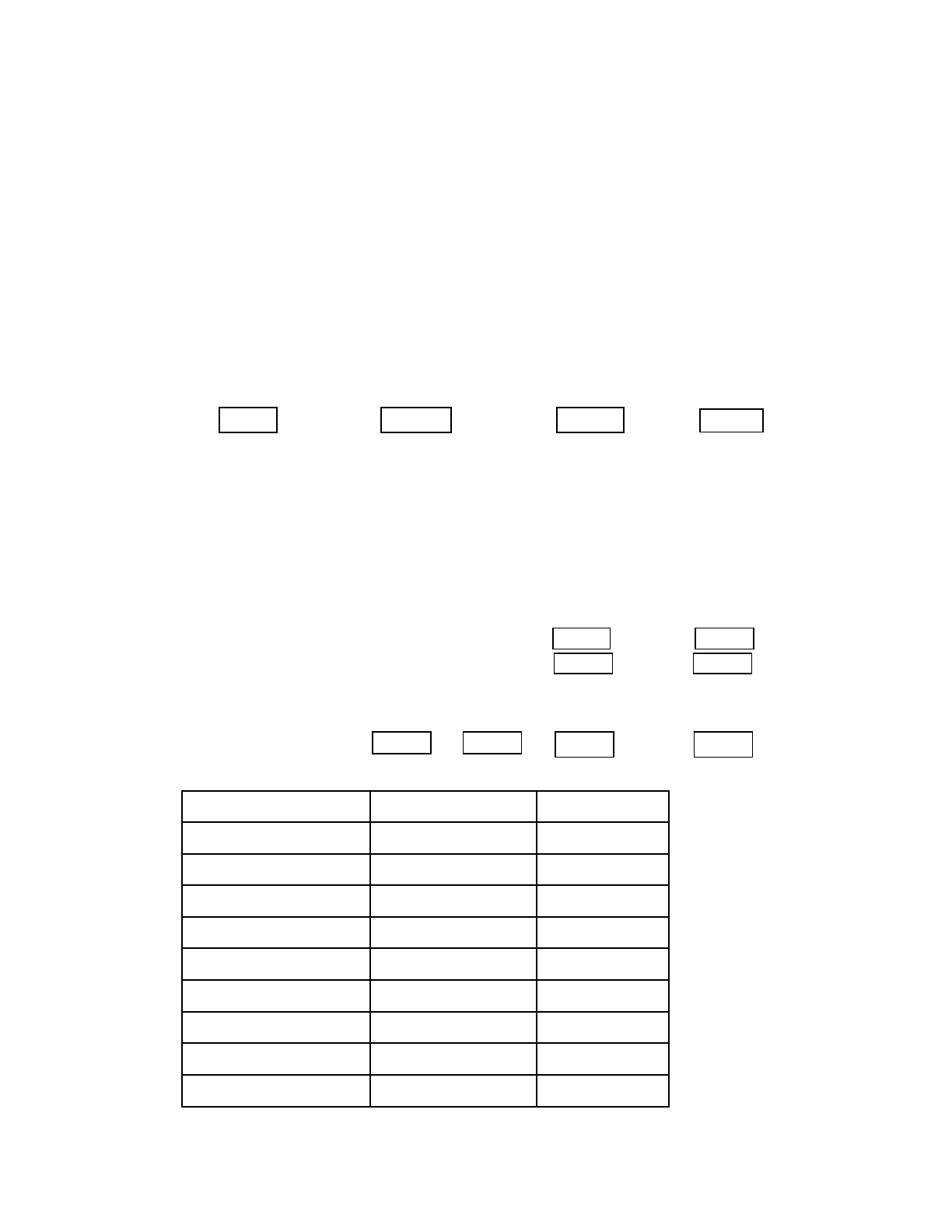
Institutional Quality Assurance Cell Operations Manual
IQACOM Annex 5
TEMPLATE FOR ANNUAL COURSE REPORTS
University ……………………..Faculty ……………………Department………………
I. Basic Information
Code and Title:
Name of the Program(s):
Year /Level/Semester of programs:
Units/ Credit hours:
Lectures
Tutorial
Practical
Total
5. Names of course instructor contributing to the delivery of the course
…………………………..
…………………………..
…………………………..
Course coordinator (if any) …………………………..
External evaluator ……………………………
II. Statistical Information
No. of students attending the course: No. %
No. of students completing the course: No. %
Results:
Passed: No.% Failed: No. %
Achievement of Students:
Letter Grade
No. of Students
%
A+
A
A--
B+
B
B--
C+
C
D
57

Institutional Quality Assurance Cell Operations Manual
III. Professional Information
Course teaching
Topics actually taught
No. of hours
Course Instructor
Topics taught as a percentage of the content specified:
.>90%
70-90%
,70%
Reasons in detail for not teaching any topic
……………………………………….
……………………………………….
……………………………………….
If any topics were taught which are not specified, give reasons in detail
……………………………………….
……………………………………….
……………………………………….
2. Teaching and learning methods:
Lectures:
Practical training/laboratory:
Seminar /Workshop:
Class activity:
Case Study:
Other assignment/homework:
If teaching and learning methods were used other than those specified, list, and give reasons:
…………………………………………………...................................................…………..
………………………………………………………...................................................……..
58

Institutional Quality Assurance Cell Operations Manual
3. Student assessment:
Method of assessment
Percentage of Total
Written examination
Oral examination
Practical /laboratory work
Other assignments/class work(Specify)
Total 100%
Involvement of external evaluator
………………………………………………
………………………………………………
………………………………………………
Facilities and teaching materials:
Totally adequate
Adequate to some extent
Inadequate
List any inadequacies
………………………………………………
………………………………………………
Administrative constraints
List any difficulties encountered
………………………………………………
………………………………………………
………………………………………………
Student evaluation of the course:
List any criticisms
………………………………………………
………………………………………………
………………………………………………
Comments from external evaluator(s):
………………………………………………
………………………………………………
………………………………………………
59

Institutional Quality Assurance Cell Operations Manual
8. Course enhancement:
Progress on actions identified in the previous year's action plan:
(State whether or not completed and give reasons for any non-completion)
………………………………………………
………………………………………………
9. Action plan for academic year 20XX – 20YY
Actions required
Completion date
Person responsible
…………………….
…………………….
…………………….
…………………….
…………………….
…………………….
Course coordinator/Teacher:
Signature:
Date: / /
60

Institutional Quality Assurance Cell Operations Manual
IQACOM Annex 6
FACULTY COURSE REVIEW REPORT
(To be filled by each teacher at the time of Course Completion)
For completion by the course instructor and transmission to Head of the Department with
copies of the Course outline
Department:
Faculty:
Course Code:
Title
Session:
Semester/Term
Credit Value:
Level
Name of
No. of students
Lectures
Other (Please
Course
contact hour
State)
Instructor:
Seminars
Assessment Methods: give precise
details
(no
&
length
of
assignments,
exams,
weightings
etc)
Distribution of Grade/Marks and other Outcomes: (Use the prescribed grading system
of the university)
Post graduate/Undergraduate
Number of Enrolled Students:
Scale
Letter Grade
Number of students
%
80% and above
A+
75% to less than 80%
A
70% to less than 75%
A-
65% to less than 70%
B+
60% to less than 65%
B
55% to less than 60%
B-
50% to less than 55%
C+
45% to less than 50%
C
40% to less than 45%
D
Less than 40%
F
Incomplete
I
Withdrawal
W
Total
61

Institutional Quality Assurance Cell Operations Manual
Overview/Evaluation (Course Coordinator’s Comments)
Feedback: first summarize, and then comment on feedback received from:(These boxes will
expand as you type in your answer.)
Student (Course Evaluation) Questionnaires:
External Examiners or Moderators (if any):
Curriculum: Comment on the continuing appropriateness of the Course curriculum in
relation to the intended learning outcomes and its compliance with the National
Qualification Framework
Assessment: Comment on the continuing effectiveness of method(s) of assessment in relation
to the intended learning outcomes (Course objectives)
Enhancement: Comment on the implementation of changes proposed in earlier Faculty
Course Review Reports
Outline any changes in the future delivery or structure of the Course that this semester/term’s
experience may prompt
Name: _________________________________ Date_______________
(Course Instructor (S))
Name: _________________________________ Date _______________
(Head of the department)
62

Institutional Quality Assurance Cell Operations Manual
IQACOM Annex 7
GUIDELINES FOR WRITING COURSE REPORTS
General rules
The University should have a file for each program containing the specification of its
courses. Three copies should be available, one with the academic /course coordinator,
second one with the head of the degree offering entity and the third one with the
director IQAC
The University should provide the necessary supports to ascertain periodic reviewing and
updating of the curricula.
The University should have clear academic standards and benchmarks for each education
program.
At the end of the semester/term/year, each and every course instructor should submit a
course report to the head of the degree offering entity.
I. Basic Information
Degree offering entity: Write the name of the degree offering entity.
Program: Write the title of the program(s) to which the course contributes
Course title and code: Write the title and the code (the letter(s) and the number that
identifies the course in the faculty by - law). If there is no code, leave the space blank.
Year / Level: Write the year and/or level of the students attending the course
No. of hours/ units: Referring to the ordinance / by-laws, write the number of weekly
contact hours of the course.
Teaching staff: Write the name(s) of course instructor(s) teaching the course.
II. Statistical Information
No. of students starting the course: Write the number of students starting the course at
the beginning of the semester / term / year.
No. of students at the end of the course: Write the number of students retained in the
course at the end of the semester / term / year.
Results of students’ assessment: Write the number and percentage of pass students as
well as fail students.
Distribution of passed students according to: Fill in the allocated space, the number, as
well as the percentage of students for each grade.
III. Professional Information
Course topics taught: In the first column of the table, write the topics actually covered
in the semester/year. In the second column of the table, write the actual hours spent in
covering each topic. In the third column, write the name of the course instructor
covering each topic.
63

Institutional Quality Assurance Cell Operations Manual
Write in the space provided the percentage of the specified topics actually covered.
State the reasons for the failure to cover any of the specified topics. If topics, not
included in the course specification, were taught, justify this action.
Teaching and learning methods:
Tick in the appropriate rectangle, the method used. Write any
comments. Lectures…………………………………….
Practical training / lab……………………..
Discussion sessions………………………
Class activities …………………………….
Case studies ………………………………
Other assignments…………………………
Student assessment:
Methods of assessment
Tick in the appropriate place the method(s) used.
State the rules applied for the selection of the examination committee.
State the names of the members of the examination committee.
State the involvement of the external evaluator in :
The match between the examination and the topics taught.
The existence of grading criteria in examination sheets.
The allocation and distribution of marks and weighting.
Effectiveness of the overall assessments in measuring the achievement of the
intended learning outcomes (ILOs).
Facilities and teaching materials:
Tick the boxes provided to indicate whether or not the facilities for learning and teaching
material s are adequate. If there are any inadequacies, identify them, together with any
problems in the delivery of the course or achieving the ILOs, which resulted.
Administration constraints:
State any administrative constraints related to teaching and learning (lack of some facilities
or funds, teaching aids, site visits, qualified personnel for laboratory and administration).
Also mention any management problems or regulations, which impeded the delivery of the
course and the achievement of the ILOs.
Results of course evaluation by students:
State the main points resulting from the analysis of students’ evaluation of the course, and the
response to any criticisms by the faculty members delivering the course, together with their
proposals for dealing with those issues.
64

Institutional Quality Assurance Cell Operations Manual
External evaluator’ comments:
State the issues raised by the external evaluator and the responses from the faculty members
delivering the course, together with their proposals for dealing with those issues.
Course enhancement:
List the issues identified in the action plan from the previous year and whether or not they
have been dealt with effectively. When issues have not been effectively dealt with, give
reasons, and include in the current year’s action plan. Write the issues not handled from those
raised in the previous report and the reasons for overlooking such issues.
Action plan for program enhancement over the next academic year: List:
Issues and actions required
Time schedule
Persons(s) responsible for the successful achievement of the specified action.
The action plan is fundamental to the success of the quality system. It appears at the end of
the report, because it is the result of all of prior analysis. Enhancement can only take place if
issues are identified and then acted upon and resolved. The action plan identifies the issues,
prioritizes them, and dictates the necessary action to be taken. It is also clearly places the
responsibility for the implementation of the action and the resolution of the associated issues,
in a given time scale on named individuals.
65

Institutional Quality Assurance Cell Operations Manual
IQACOM Annex 8
GUIDELINES FOR COMPILING A COURSE
SPECIFICATION
General rules
The University should have a file for each course “Course File” containing the course
specification, samples of previous examination sheets, and results of student evaluation
of the course as well as the percentages of students dropping out, passing, and failing
the course. The file should include other relevant information as necessary.
The University should ensure the existence of two copies of the course file, one for the
course instructor and the other for the head of the degree offering entity or course
coordinator. This will help in follow-up.
The University should provide a system for course evaluation.
The Academic Committee / Faculty Committee/ Academic Council should approve the
course specification when preparing/reforming/developing an educational program and
before authorization of the program by higher authority or, in case of reviewing a
course to cope with novel topics or to add/ delete some of program academic standards.
I. Basic Information
Program Title: Write the title of the program (s) which contain the course, and identify
if major/ minor/optional, where relevant.
Entity offering the program (s): Write the name of the entity responsible for program
(s)
Department responsible for the course: Write the name of the department responsible
for teaching the course.
Course code: Write the code (the letter(s) and the number that identify the course in the
faculty by – laws). If there is no code, leave the space blank.
Year / Level: Write the year and/or level of the students attending the course.
No. of hours/units: Referring to the ordinance / by-laws, write the number of weekly
contact hours of the course.
Authorization date of course specification: Write the year in which the course
specification has been authorized.
II. Professional Information
Course aims: Overall course aims should be expressed as the outcomes to be achieved by
students completing the course as significant and assessable qualities.
Intended Learning Outcomes from the course:
Express the ILOs of the course in terms of:
Knowledge: The main information is to be gained and the concepts that should be
understood, applied analyzed, evaluated and created from the course.
66

Institutional Quality Assurance Cell Operations Manual
Skills: The skills to be obtained and should be imitated, manipulated, précised,
articulated and naturalized from the course.
Attitude: The concepts that should influence to organize and internalize values.
Course content: Write in the main course topics, the number of hours allocated for
teaching each topic for lectures as well as for seminars, tutorials, exercises, laboratory
work, etc. The topics should comply with the content.
Teaching and learning methods: Identify the methods used in delivering the course
such as lectures, discussion sessions, information collection from different sources,
practical, research assignment, field visits, and case studies etc.
Student assessment:
Write down the assessment methods used, such as written examinations (continuous
assessment, mid-term, regular, at the end of term) class activities (reports,
discussion, practical… etc.). Match the methods used with the course ILOs.
Time Schedule: identify the percentage of marks allocated to teach assessment tool
mentioned above
Formative only assessment are those, which do not contribute to the overall grading
system, but are important in the learning process.
List of text books and references:
Lectures notes: When notes are available, specify whether they are prepared in the
form of a book authorized by the department or are handed out to the students part
by part.
Essential books (text books): When the lecturer uses one book that covers most of
course contents, specify the book.
When the lecturer uses more than one book, which contains parts of the course
specify the books and the topics covered by each.
General references, journals, periodicals, newspapers, web sites, which enrich the
learning process should also be listed.
The references that should be identified in the above items should be written in a
standard way (publisher, edition, year, author(s)…etc. Refer also to locations for
reading or buying the specified references.
Facilities required for teaching and learning:
The facilities include: appropriate teaching accommodation, including teaching aids,
laboratories, laboratory equipment, computers etc, facilities for field work, site visits etc,
which are necessary for teaching the course.
67

Institutional Quality Assurance Cell Operations Manual
IQACOM Annex 9
RESEARCH STUDENT PROGRESS REPORT
(To be filled by Master/ MPhil/PhD Research Students on six monthly
basis) Period of Reporting:
1.
Name of the Student with Designation
:
and Address
2.
Contact address, Telephone etc.
:
3.
Name of supervisor with designation, contact
:
address, telephone etc.
4.
Name of Program, Department and University
:
5
Research Title/Topic
:
6
Date of admission
:
7
Date of completion of Course work (if any)
:
8
Number of course/credit completed (if any)
:
9
Cumulative Grade Point Average (CGPA) secured
10
Research Area
:
11
Date of Defense on Research Proposal
12
Date of initiation of research
:
13
Please outline details of progress in your research
:
since your last report (including any research
publications):
14
Work Plan for the next 6 months?
:
17
Reference of deputation order and period
:
(if applicable)
i) First time
:
ii) Second time
iii) Third time
20
Work summary for last 6 months(including any
:
research publications):
21.
Expected date of completion of degree
:
22
Progress of Activities: (as per activity plan of the
:
student)
68

Institutional Quality Assurance Cell Operations Manual
23. Problems/Constraints (if any) :
Student’s signature: _____________________________Date: ________________________
Comment on work progress by the supervisor:
___________________________________________________________________________
___________________________________________________________________________
___________________________________________________________________________
Signature:________________________ Date:__________________________
Head of Department Comments:
___________________________________________________________________________
___________________________________________________________________________
___________________________________________________________________________
Signature:________________________ Date:__________________________
Progress of Activities: (as per activity plan of the student)
Activities
1
st
six
2
nd
six
3
rd
six
4
th
six
5
th
six
6
th
six
7
th
six
8
th
six
month
month
month
month
month
month
month
month
Note: Please submit the activities plan in excel spread sheet as a Gantt Chart
For assistant please consult: www.ganttchanrt.com
69

Institutional Quality Assurance Cell Operations Manual
IQACOM Annex 10
CONCEPPT NOTE ON SELF-ASSESSMENT
Self-assessment refers to a comprehensive, systematic review of an education institution’s
activities including academic programs. The SA process allows the organization to discern
clearly its strengths and areas in which improvements are required and culminates in planned
development actions.
Suggested Self-Assessment Process Activities
A. Preparation Phase
A1. Appointment of the Self-Assessment Committee
For a particular self assessment exercise there shall be a Self Assessment Committee.
Interested, experienced and qualified faculty members may the members of the SA
committee.
A2. Training and preparation of the SA Committee
All the SA Committee members may need to have training on the process of conducting SA
exercise and its implication of quality education. Training would prepare them to organize
and implement SA process activities effectively with a positive attitude.
A3. Support services necessary for SA implementation
Faculty/Department needs to provide required support services to conduct the SA exercise
properly, which may include the following:
Support staff
Academic staffs to collect and process information
Meeting rooms, computers and photocopier
Office supplies (paper, file folders etc.)
Adequate funds to meet the costs associated with the SA process activities.
A4. Preparation of the SA process
Finalizing the activity schedule
Selecting the stakeholders to be interviewed for information
Preparing the survey tools
Team building
B. Implementation Phase
Information gathering: Data collation using he survey tools
Data analysis and preparing the internal SA report
Preparation of the Internal SA Report
70

Institutional Quality Assurance Cell Operations Manual
Presentation of the Internal SA Report to the QAC or members of the program offering
entity (as applicable). SA Committee will finalize the accommodating the outcomes of
the discussion during presentation.
C. External Peer Review and Validation Phase
Selection and appointment of the external peer reviewers
Delivery of the Internal SA Report to the external peers
Planning of the external peer site visit
Facilitating external peer visit with appropriate and agreed schedule and logistics support
Wrap up on the findings of external peer review
D. Submission of External Peer Review Report
The external peer review panel will submit the final review and validation report as per the
ToR.
E. Improvement Plan
Preparing and Sharing the Improvement plan
It is highly recommended that after finalizing the SA report the findings and recommendation
shall be communicated with the concerned faculty members and officials. The SA committee
finally will prepare an improvement plan basing on the findings and recommendations in the
final SA report and external peer review report for further improvement.
Submission
At the end of the SA process the final report along with the improvement plan need to be
submitted to the respective authorities including IQAC.
Endorsement by the Authority
SA committee will appraise the Vice chancellor about the improvement plan for further
necessary support to implement the improvement plan. The university authority will provide
supports including budget allocation to implement the improvement plan.
71

Institutional Quality Assurance Cell Operations Manual
IQACOM Annex 10.1
Program Self Assessment
SURVEY QUESTIONNAIRE FOR EMPLOYER
The purpose of this survey is to obtain employers’ input on the quality of education of
_________________________ program of ____________________University. The survey
is with regard to _____________________graduates ______________________University
employed at your organization. Your sincere cooperation would enable us to improve the
quality of our graduates as per your requirements.
Name of the Institute/Organization:______________________________________________
Corporate Office Address______________________________________________________
Email:__________________________________ Web:______________________________
Nature: Θ Academic Θ Research Θ Business Enterprise Θ Others_______________
Establishment Year:
Ways of Sourcing for Entry Level Employee
Sourcing Ways
Previously
Currently
%
%
Online Application(Ad/Without Ad)
Direct Hard Copy Application with Ad
Internship
Campus Recruitment
Networking with Reputed Universities
Other
Experience Requirement for Entry Level Employees:
Θ Highly Experienced Θ Experience for few years Θ Fresh Θ Can not be
generalized
Please rate the following dimensions of quality of graduates according to importance in
recruitment using the following rating scale:
(5: Extremely important 4: very important 3: Important 2: Less important 1: Not
important at all)
72

Institutional Quality Assurance Cell Operations Manual
No.
Dimensions of Quality
Rating
Knowledge
Job knowledge (knowledge on subject matter)
IT Knowledge
Knowledge in designing a system component or process
Communication Skills
Oral communication
Report writing
Presentation skills
Interpersonal Skills
Ability to work in teams
Leadership
Independent thinking/ Self Confidence
Self Motivation/ Commitment to job
Reliability
Appreciation of ethical values
Adaptability
D. Work Skills
Time management skills
Judgment
Problem formulation, solving and decision making skills
Collecting and analyzing appropriate data
Ability to link theory to Practice
Discipline
Sense of Responsibility
Please evaluate the following dimensions of competence of graduates …… program, …
University based on their performance at your organization using the following scale:
5 – Excellent 4 – Very Good 3 – Good 2 – Fair 1 – Poor
73

Institutional Quality Assurance Cell Operations Manual
No. Dimensions of Quality
Knowledge
Job knowledge (knowledge on subject matter)
IT Knowledge
Knowledge in designing a system component or process
Communication Skills
Oral communication
Report writing
Presentation skills
Interpersonal Skills
Ability to work in teams
Leadership
Independent thinking/ Self Confidence
Self Motivation/ Commitment to job
Reliability
Appreciation of ethical values
Adaptability
Work Skills
Time management skills
Judgment
Problem formulation, solving and decision making skills
Collecting and analyzing appropriate data
Ability to link theory to Practice
Discipline
Sense of Responsibility
5.
Major weaknesses you have observed in the Graduates of …. Program
…..
University working at your organization
Do you provide any training right after recruitment before assigning any responsibility:
Yes/No
If Yes, Please specify….
General Comments
Please make additional comments or suggestions, which you think would help to
strengthen our programs for the preparation of graduates.
74

Institutional Quality Assurance Cell Operations Manual
IQACOM Annex 10.2
Program Self Assessment
SURVEY QUESTIONNAIRE FOR ALUMNI
(To be filled by the Graduates)
This form includes statements for self assessment at program level. You as a graduate are
requested to give your sincere comment against each of the statements by putting a tick (√)
mark. Your sincere evaluation will be helpful for correct assessment of the program so that
next improvement plan may be undertaken. Be honest!!
Name of the program:______________Department/Discipline:_______________________
Faculty/School:__________________ University: ________________________________
Degree and service Information:
Current status:
a) Searching Job b) Employed in an organization c) Engaged with own business If the
answer is b or c
Name of present organization __________________________________________________
Designation: ________________________________________________________________
Address: ___________________________________________________________________
Year of Passing/graduation:
Date of your first employment:
Time taken to get the first employment opportunity:
Year
Month
Training or any other courses or program attended to get job after graduation from ‘X’
University Θ Yes Θ No If yes, please specify_____________
Recruitment process you faced to get involved with your present organization
Direct Offer
Direct Oral Interview
Written & Oral Interview
Other (Pls. Specify)
75

Institutional Quality Assurance Cell Operations Manual
Way of submitting application/CV for current employment
Ways
Online Application (against Ad/Personal contact)
Direct Hard Copy Application (against Ad/Personal contact)
Internship
Campus Recruitment
Other
Evaluate the following aspects of the program in terms capacity to provide quality
education by marking “√” in the box of corresponding column according to the scale
given:
5–Strongly agree; 4–Agree; 3–Neutral;
2–Disagree;
1–Strongly disagree;
A. Governance
Area of Evaluation
5
4
3
2
1
1.
Department provided written information in advance about the aims,
objectives, learning outcomes, and methods of assessment of the
program to the students.
2.
The department provided its student a conducive learning
environment in which scholarly and creative achievements were
nurtured
3.
Fairness and transparency of academic decisions at all levels were
maintained
4.
Academic calendar was maintained properly
5.
Results at all levels were published according to the stipulated time
mentioned in the ordinance
6.
Teachers were friendly and cooperative to the students and which
made a positive impact over the teaching-learning environment
7.
Students’ opinion regarding academic and extra-academic matters
were treated properly
8.
Formal process using structured questionnaire to collect student
feedback was in practice.
9.
Website was informative and students could use that in various
purposes
76
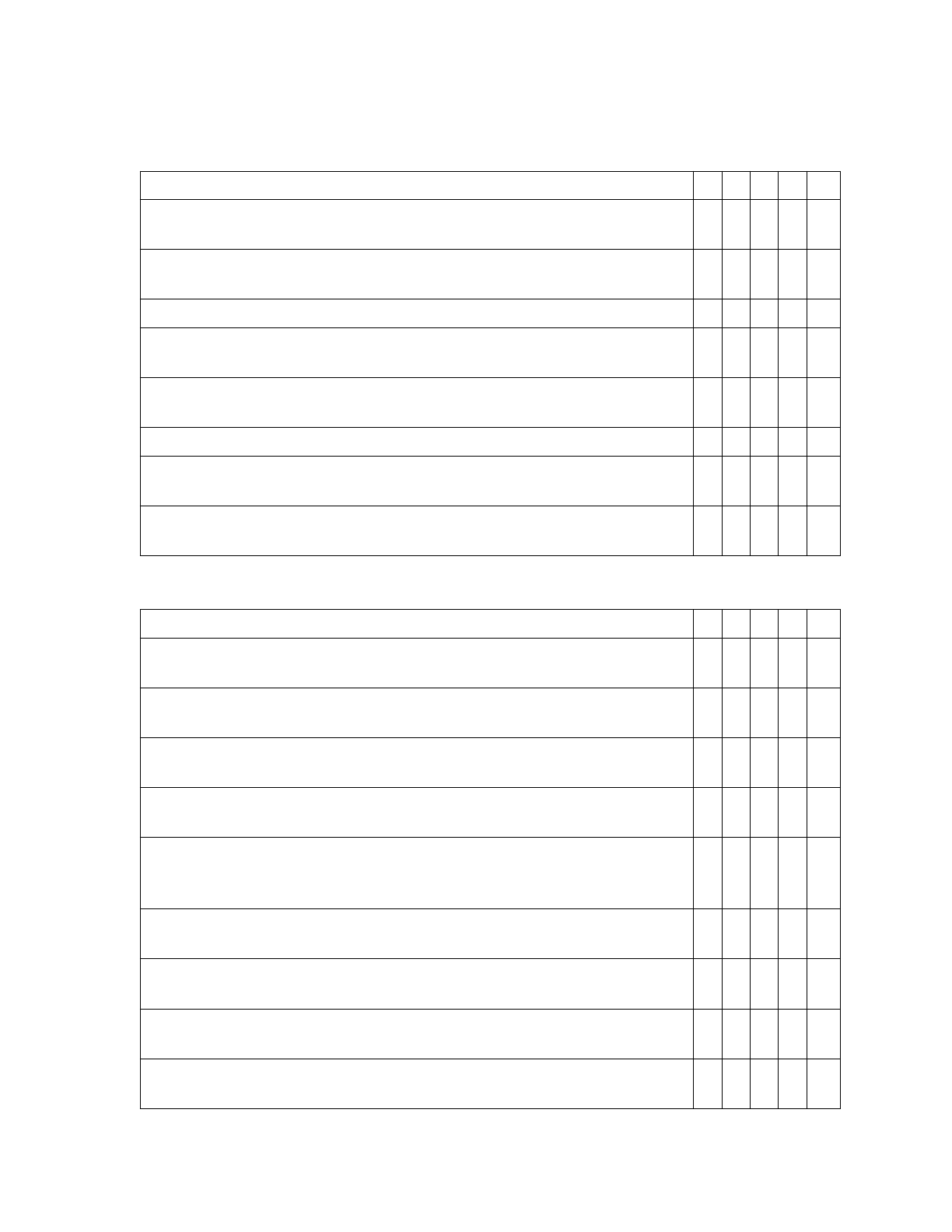
Institutional Quality Assurance Cell Operations Manual
B. Curriculum
Area of Evaluation
5 4 3 2 1
Curriculum addresses the program objectives and program learning
outcomes
Curriculum in the program was too heavy and induces huge
pressure
Courses in the curriculum were structured and arranged properly
Teaching strategies stated in curriculum were appropriate for
achieving learning outcomes
Assessment strategies were suitable and match to the learning
outcomes
The curriculum was effective in enhancing team-working abilities.
The curriculum was effective in developing analytical and problem
solving skills.
The curriculum was effective in developing ICT & communication
skills.
Teaching-learning
Item
5 4 3 2 1
The department created such a teaching-learning environment that
inspired students to become life-long learner
The teachers provided additional practical ideas from real life
situation apart from the textbook
The teachers remained available during the specified office hours
and after class for consultations
Teaching-learning approach was interactive and supportive for the
achievement of the program learning outcomes
Class size was optimum so that students could interact with the
teachers and took the opportunity to participate and feedback for
better teaching learning
Technological devices were used as regular practice to improve
teaching-learning process
Teaching and learning strategies inspired students for their own
learning and to achieve learning outcomes
Diverse teaching-learning methods were used to achieve intended
learning outcomes (ILOs)
Lesson plans were designed addressing aims and objectives of each
course that guides effective teaching-learning
77

Institutional Quality Assurance Cell Operations Manual
D. Assessment
Item
5
4
3
2
1
1.
The frequency, methods and criteria of assessment, including the
grading criteria were clearly communicated to students on the
commencement of the term/semester
2.
Diverse methods and tools were used appropriately to assess the
learning outcomes and competencies.
3.
The students were provided feedback on each assessment before the
next one.
4.
Students’ learning assessment procedures were maintained fairly.
5.
The content of examinations was representative of the course
material
E. Institutional structures and facilities
Item
5
4
3
2
1
1.
Classrooms were good in number, well spaced, well equipped and
well maintained to ensure effective delivery
2.
Laboratories were good in number, well spaced with relevant well off
equipments, competent manpower and properly maintained for
conducive teaching and learning
3.
The library had adequate and up-to-date reference materials that meet
the academic & research needs
4.
The library provided appropriate ICT-mediated reference materials
5.
Internet facilities with sufficient bandwidth capacity were available
6.
Adequate office room facilities along with relevant equipments and
competent manpower were available to support the students’ need
7.
Adequate indoor and outdoor healthcare facilities were available
78

Institutional Quality Assurance Cell Operations Manual
F. Student Support
Item
5 4 3 2 1
There was an arrangement to provide guidance and counseling for
academic improvement and to take special care of the weak students
There were scholarships/ grants available to students in case of
hardship.
The students were encouraged to involve in co- curricular and extra-
curricular activities.
There was placement and career planning office in the university
and/or department for maintaining communication with alumni and
employers
The placement and career planning office provided effective services
to the graduating students
Alumni support is available in internship and academic preparation
There were opportunities and students were encouraged to get
involve with community services
Research and Extension
Item
5
4
3
2
1
1.
The faculty/department has a policy and a program on research and
development
2.
Adequate funds and facilities were provided to sustain undertaken
policy and program
3.
Teachers were always eager to hunt research fund for smooth
running of the research.
4.
Teachers encouraged and prepared students for engagement in
research, scholarship and development.
5.
Research outputs were regularly published in reputed impact factor
journal
6.
Research findings in the form of theses, monographs and
publications were properly used in current teaching-learning.
7.
Research findings were patented and used for commercial purposes.
8.
The faculty/department was involved in community services with
the developed technologies
79

Institutional Quality Assurance Cell Operations Manual
H. Staff
Item
5
4
3
2
1
1.
The teachers in the department were well qualified
2.
Number of teachers was adequate to run the programs smoothly
3.
Supporting staffs in the laboratories and fields were adequate,
efficient and supportive
4.
Academics had enough opportunity to take part in different training
program for skill development
5.
Nonacademic staffs had enough opportunity to take part in different
training program for skill development
6.
The faculty/department provided mentoring and formative guidance
for new academic staff as part of its staff development program.
What are the best aspects of your program?
______________________________________________________________________
______________________________________________________________________
What aspects of your program could be improved?
______________________________________________________________________
______________________________________________________________________
80

Institutional Quality Assurance Cell Operations Manual
IQACOM Annex 10.3
Program Self Assessment
SURVEY QUESTIONNAIRE FOR STUDENTS
(To be filled by the Existing Students)
This form includes statements for self assessment at program level. You as a graduating
student are requested to give your sincere comment against each of the statements by putting
a tick ( √) mark. Your sincere evaluation will be helpful for correct assessment of the
program so that next improvement plan may be undertaken. Be honest!!
Name of the program: _______________Department/Discipline:________________
Faculty/School:_______________________ University: ____________________________
GPA/CGPA Earned
SSC
HSC
1
st
year
2
nd
year
3
rd
year
4
th
year
5
th
year
CGPA
Lev
Lev
Lev
Lev
Lev
Lev
Lev
Lev
Lev
Lev
I
II
I
II
I
II
I
II
I
II
YGPA
Number of classes held to complete the course
Number of Courses Completed
Number of Classes held to
Number of
by the responding student
complete the course
courses
Less than 15
16 to 20 Classes
21 to 25 Classes
26 to 30 Classes
31 to 35 Classes
36 and above
2. Classes are mostly: Lecture based
Interactive
Both
Evaluate the following aspects of the program in terms capacity to provide quality
education by marking “√” in the box of corresponding column according to the scale
given:
5–Strongly agree; 4–Agree; 3–Neutral; 2–Disagree; 1–Strongly disagree;
81

Institutional Quality Assurance Cell Operations Manual
Governance
Area of Evaluation
5
4
3
2
1
1.
Department provides written information in advance about the aims,
objectives, learning outcomes, and methods of assessment of the
program to the students.
2.
The department provides its student a conducive learning
environment in which scholarly and creative achievements are
nurtured
3.
Fairness and transparency of academic decisions at all levels are
maintained
4.
Academic calendar is maintained properly
5.
Results at all levels are published according to the stipulated time
mentioned in the ordinance
6.
Teachers are friendly and cooperative to the students and which made
a positive impact over the teaching-learning environment
7.
Students’ opinion regarding academic and extra-academic matters are
treated properly
8.
Formal process using structured questionnaire to collect student
feedback is in practice.
9.
Website is informative and students can use that in various purposes
Curriculum
Area of Evaluation
5
4
3
2
1
1.
Curriculum addresses the program objectives and program learning
outcomes
2.
Curriculum in the program is too heavy and induces huge pressure
3.
Courses in the curriculum are structured and arranged properly
4.
Teaching strategies stated in curriculum are appropriate for
achieving learning outcomes
5.
Assessment strategies are suitable and match to the learning
outcomes
6.
The curriculum is effective in enhancing team-working abilities.
7.
The curriculum is effective in developing analytical and problem
solving skills.
8.
The curriculum is effective in developing ICT & communication
skills.
82

Institutional Quality Assurance Cell Operations Manual
Teaching-learning
Item
5 4 3 2 1
The department creates such a teaching-learning environment that
inspired students to become life-long learner
The teachers provides additional practical ideas from real life
situation apart from the textbook
The teachers remain available during the specified office hours and
after class for consultations
Teaching-learning approach is interactive and supportive for the
achievement of the program learning outcomes
Class size is optimum so that students could interact with the
teachers and took the opportunity to participate and feedback for
better teaching learning
Technological devices are used as regular practice to improve
teaching-learning process
Teaching and learning strategies inspires students for their own
learning and to achieve learning outcomes
Diverse teaching-learning methods are used to achieve intended
learning outcomes (ILOs)
Lesson plans are designed addressing aims and objectives of each
course that guides effective teaching-learning
Assessment
Item
5
4
3
2
1
1.
The frequency, methods and criteria of assessment, including the
grading criteria are clearly communicated to students on the
commencement of the term/semester
2.
Diverse methods and tools are used appropriately to assess the
learning outcomes and competencies.
3.
The students are provided feedback on each assessment before the
next one.
4.
Students’ learning assessment procedures are maintained fairly.
5.
The content of examinations is representative of the course material
83

Institutional Quality Assurance Cell Operations Manual
E. Institutional structures and facilities
Item
5
4
3
2
1
1.
Classrooms are good in number, well spaced, well equipped and well
maintained to ensure effective delivery
2.
Laboratories are good in number, well spaced with relevant well off
equipments, competent manpower and properly maintained for
conducive teaching and learning
3.
The library has adequate and up-to-date reference materials that meet
the academic research needs
4.
The library provides appropriate ICT-mediated reference materials
5.
Internet facilities with sufficient bandwidth capacity are available
6.
Adequate office room facilities along with relevant equipments and
competent manpower are available to support the students’ need
7.
Adequate indoor and outdoor healthcare facilities were available
F. Student Support
Item
5
4
3
2
1
There is an arrangement to provide guidance and counseling for
academic improvement and to take special care of the weak students
There are scholarships/ grants available to students in case of
hardship.
The students are encouraged to involve in co- and extra-curricular
activities.
There is placement and career planning office in the university and/or
department for maintaining communication with alumni and
employers
The placement and career planning office provides effective services
to the graduating students
Alumni support in internship and academic preparation
There are opportunities and students are encouraged to get involve
with community services
84

Institutional Quality Assurance Cell Operations Manual
G. Research and Extension
Item
5 4 3 2 1
The faculty/department has a policy and a program on research and
development
Adequate funds and facilities are provided to sustain undertaken
policy and program
Teachers are always eager to hunt research fund for smooth running
of the research.
Teachers encourage and prepare students for engagement in research,
scholarship and development.
Research outputs are regularly published in reputed impact factor
journal
Research findings in the form of theses, monographs and publications
are properly used in current teaching-learning.
Research findings are patented and used for commercial purposes.
The faculty/department is involved in community services with the
developed technologies
Staff
Item
5
4
3
2
1
1.
The teachers in the department are well qualified
2.
Number of teachers is adequate to run the programs smoothly
3.
Supporting staffs in the laboratories and fields are adequate, efficient
and supportive
4.
Academics have enough opportunity to take part in different training
program for skill development
5.
Nonacademic staffs have enough opportunity to take part in different
training program for skill development
6.
The faculty/department provides mentoring and formative guidance
for new academic staff as part of its staff development program.
85

Institutional Quality Assurance Cell Operations Manual
What are the best aspects of your program?
______________________________________________________________________
______________________________________________________________________
______________________________________________________________________
______________________________________________________________________
______________________________________________________________________
What aspects of your program could be improved?
______________________________________________________________________
______________________________________________________________________
______________________________________________________________________
______________________________________________________________________
______________________________________________________________________
______________________________________________________________________
______________________________________________________________________
86

Institutional Quality Assurance Cell Operations Manual
IQACOM Annex 10.4
Program Self Assessment
SURVEY QUESTIONNAIRE FOR NON-ACADEMIC STAFFS
(To be filled by the non-academic staffs)
This form includes statements for self assessment at program level. You as a non- academic
staff are requested to give your sincere comment against each of the statements by putting a
tick (√ ) mark on appropriate grade-column. Your sincere evaluation will be helpful for
correct assessment of the program so that next improvement plan may be undertaken. Be
honest!!
Name: _______________________________ Years of experience____________________
Department:__________________________ Faculty: ______________________________
University: __________________________________
Evaluate the following aspects of the program in terms capacity to provide quality
education by marking “√” in the box of corresponding column according to the scale
given:
5–Strongly agree; 4–Agree; 3–Neutral;
2–Disagree;
1–Strongly disagree;
A.
Governance:
Item
5
4
3
2
1
1.
Department provides a brochure to the students in advance
consisting a comprehensive guidelines of the program
2.
Fairness and transparency of academic decisions at all levels are
maintained
3.
The department provides its student a conducive learning
environment in which scholarly and creative achievements are
nurtured
4.
Academic calendar is maintained properly
5.
Results at all levels are published in compliance with the ordinance
6.
Documentations (decisions of committees, class attendance
registers, questions, continuous assessment answer scripts, marks,
examination results, students’ progress etc) are maintained properly
7.
Perfect evaluating system for nonacademic staffs’ performance is
prevailing
8.
Teachers are friendly and cooperative to the staffs and which make a
positive impact over the teaching-learning environment
9.
University has defined procedures for all activities performed
87
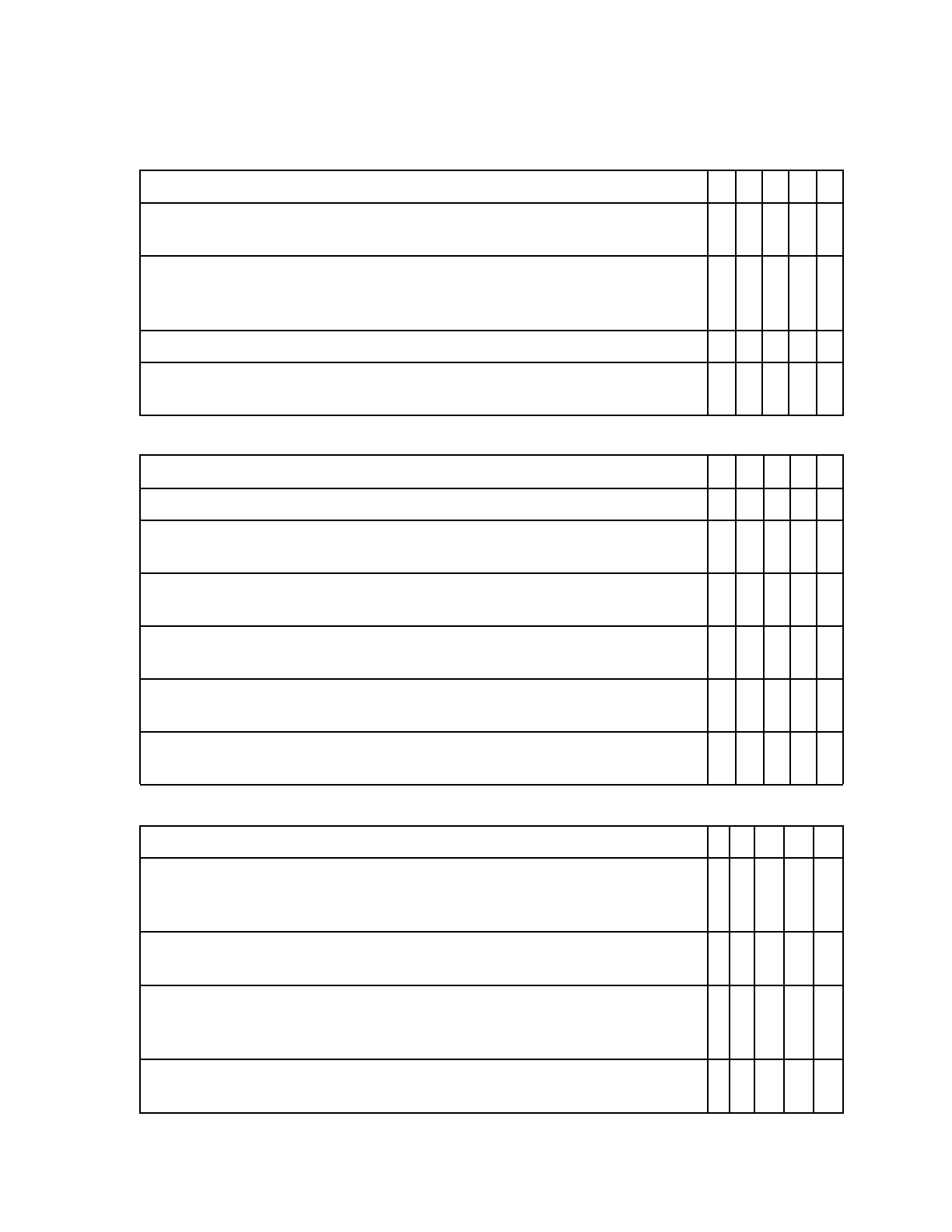
Institutional Quality Assurance Cell Operations Manual
B. Institutional structure and facilities
Item
5
4
3
2
1
8.
Classrooms are good in number, well spaced, well equipped and well
maintained to ensure effective delivery
9.
Laboratories are good in number, well spaced with relevant well off
equipments and properly maintained for conducive teaching and
learning
10.
Internet facilities with sufficient bandwidth capacity are available
11.
Adequate office room facilities along with relevant equipments and
competent manpower are available
Staff: Recruitment and development
Item
5
4
3
2
1
1.
Nonacademic staffs are competent and responsive
2.
Nonacademic staffs have enough opportunity to take part in different
training program for skill development
3.
The Faculty/Department has policy to complement non-academic
staffs related to service, development and appraisal.
4.
The faculty/department provides mentoring and formative guidance
for new non-academic staff as part of its staff development program.
5.
The recruitment and up-gradation policy is good enough and
inspiring
6.
Competence, experience and sincerity are the only criteria for
promotion and up-gradation
D. Students support
Areas of Evaluation
5
4
3
2
1
1.
The faculty/department maintains students progress documents and
offer appropriate developmental or remedial support to assist students
who need such support
2.
The faculty/department maintains active linkages with its alumni and
employers.
3.
Students have access to appropriate and adequate support services,
such as physical, social, financial and recreational facilities, and
counseling and health services.
4.
Students and staffs maintain a good relationship that makes teaching-
learning environment healthy
88

Institutional Quality Assurance Cell Operations Manual
What are the major weaknesses you have observed in the department
______________________________________________________________________
______________________________________________________________________
______________________________________________________________________
______________________________________________________________________
Your suggestion to improve the teaching learning environment:
______________________________________________________________________
______________________________________________________________________
______________________________________________________________________
______________________________________________________________________
______________________________________________________________________
______________________________________________________________________
89

Institutional Quality Assurance Cell Operations Manual
IQACOM Annex 10.5
Program Self Assessment
SURVEY QUESTIONNAIRE FOR ACADEMIC STAFF
(To be filled by the faculty members)
This form includes statements for self assessment at program level. You as a teacher are
requested to give your sincere comment against each of the statements by putting a tick (√)
mark on appropriate grade-column. Your sincere evaluation will be helpful for meaningful
assessment of the program so that next improvement plan may be undertaken. Be honest!!
Name:________________________________ Years of experience: __________________
Department/Discipline:______________________Faculty/School:___________________
University: __________________________________
Evaluate the following aspects of the program in terms capacity to provide quality
education by marking “√” in the box of corresponding column according to the scale
given:
5–Strongly agree; 4–Agree; 3–Neutral; 2–Disagree; 1–Strongly disagree;
Governance
Areas of Evaluation
5
4
3
2
1
1.
Program aims, objectives and Learning outcomes are clear enough
2.
The program objectives and learning outcomes are periodically
reviewed in consultation with stakeholders (students, alumni,
employers, civil society organizations and international peers etc.)
3.
Peer observation, mentoring and feed back is in practice
4.
Department provides student handbook containing the program
aims, objectives, learning outcomes, and methods of assessment of
the students.
5.
Fairness and transparency of academic decisions at all levels are
maintained
6.
Decision making procedure in the discipline/department is
participatory
7.
The department provides student a conducive learning environment
in which scholarly and creative achievements are nurtured.
8.
Academic calendar is maintained properly
9.
Results at all levels are published in compliance with the ordinance
10.
Documentations (decisions of committees, class attendance
registers, questions, continuous assessment answer scripts, marks,
examination results, students’ progress etc) are maintained properly
90

Institutional Quality Assurance Cell Operations Manual
Definition of accountability lines for academic staff and non-
academic staff is clear
KPIs are well defined and well communicated
Perfect evaluating system for teaching staffs’ performance is
prevailing.
Students’ opinion regarding academic and extra-academic matters
are treated properly
Teachers are friendly and cooperative to each other and which make
a positive impact over the teaching-learning environment
Internal quality assurance unit is working
B. Curriculum Design and Review
Areas of Evaluation
5 4 3 2 1
Curriculum addresses the program objectives and program learning
outcomes
Inputs from the relevant stakeholders are taken into consideration in
designing curriculum
Curriculum consists course learning outcomes, content, teaching
strategy and assessment strategy
Curriculum evaluation is done regularly following appropriate
procedures with the involvement of students, teachers and other
stakeholders.
Volume of curriculum in terms of study load is optimum for
achieving learning outcomes.
Stated teaching strategies are appropriate for achieving learning
outcomes
Assessment strategies are suitable and match to the learning
outcomes
Current curriculum is reviewed and updated regularly in
consultation with the stakeholders (students, alumni, employers,
civil society organizations and international peers etc.)
Current curriculum is enough to develop students’ creativity,
positive attitude with ethical standard.
91

Institutional Quality Assurance Cell Operations Manual
C. Teaching Learning
Areas of Evaluation
5
4
3
2
1
1.
Size of the class is good for better teaching learning
2.
Technological devices are available for use in teaching
3.
Students are sincere and committed to learning
4.
Teaching and learning strategies inspires students for their own
learning
5.
Diverse teaching-learning methods are used to achieve intended
learning outcomes (ILOs)
6.
Multiple techniques are used to develop communication skills
7.
Interactive teaching-learning approach supports the achievement of
the program learning outcomes
8.
Co-curricular activities which enrich students’ experiences, and
foster personal development and responsibility are encompassed in
teaching-learning process
9.
Lesson plans are designed addressing aims and objectives of each
course that guides effective teaching-learning
D. Learning Assessment
1.
Both summative and formative assessment strategies are followed
5
4
3
2
1
2.
The frequency, methods and criteria of assessment, including the
grading criteria are clearly communicated to students on the
commencement of the term/semester
3.
Diverse methods and tools are used appropriately to assess the
learning outcomes and competencies.
4.
The students are provided feedback on each assessment before the
next one.
5.
The learning assessment methods ensure the validity, reliability,
consistency
6.
The assessment system is reviewed at appropriate scheduled
intervals.
7.
The review of the assessment system is done in consultation with
external experts
92

Institutional Quality Assurance Cell Operations Manual
E. Structure and Facilities
Areas of Evaluation
5
4
3
2
1
1.
Classrooms are good in number, well spaced, well equipped and
well maintained to ensure effective delivery
2.
Laboratories are good in number, well spaced with relevant well off
equipments and properly maintained for conducive teaching and
learning
3.
The library has adequate and up-to-date reference materials that
meet the academic research needs
4.
The library provides appropriate ICT-mediated reference materials
5.
Internet facilities with sufficient bandwidth capacity are available
6.
Adequate office room facilities along with relevant equipments and
competent manpower are available
F. Research & Extension Services
Areas of Evaluation
5
4
3
2
1
The faculty/department has a policy and a program on research and
development
Adequate funds and facilities are provided to sustain undertaken
policy and program
Teachers are always eager to hunt research fund for smooth running
of the research.
Teachers encourage and prepare students for engagement in research,
scholarship and development.
Research outputs are regularly published in reputed impact factor
journal
Research findings in the form of theses, monographs and publications
are properly used in current teaching-learning.
Research findings are patented and used for commercial purposes.
The faculty/department is involved in community services with the
developed technologies
93

Institutional Quality Assurance Cell Operations Manual
G. Students Supports
Areas of Evaluation
5
4
3
2
1
1.
The faculty/department maintains students progress documents and
offer appropriate developmental or remedial support to assist
students who need such support
2.
The faculty/department maintains active linkages with its alumni
and employers.
3.
The faculty/department encourages the alumni to play a role in
preparing the students for their professional future, and to provide
linkages with industry and the professions.
4.
The faculty/department encourages the alumni to play a role in the
development of the program.
5.
The faculty/department facilitates students’ activities and student
organization to gain basic managerial and leadership experience, to
encourage character building, to inculcate a sense of belonging and
responsibility, and to promote active citizenship.
6.
The faculty/department encourages students and provides adequate
facilities to be involved in publication activities
7.
The faculty/department has a policy and programs for active student
participation in areas that affect their welfare, for example, peer
counseling, co-curricular activities, and community engagement.
8.
Students have access to appropriate and adequate support services,
such as physical, social, financial and recreational facilities, and
counseling and health services.
9.
There has a mechanism for students to minimize grievances and
make appeals relating to student support services.
10.
Student support services are evaluated regularly to ensure their
adequacy, effectiveness and safety.
11.
The faculty/department provides academic and career counseling to
the students by qualified staff and issues with confidentialities
94

Institutional Quality Assurance Cell Operations Manual
H. Staff
Areas of Evaluation
5 4 3 2 1
Teachers work load in teaching and research is justified
Academics have enough opportunity to take part in different training
program for skill development
Nonacademic staffs are competent and responsive
Nonacademic staffs have enough opportunity to take part in
different training program for skill development
Teacher student ratio is justified
The Faculty/Department has policy to complement academic staffs
related to service, development and appraisal.
The faculty/department provides mentoring and formative guidance
for new academic staff as part of its staff development program.
The faculty/department provides necessary training, tools and
technology for self-learning, access to information and for
communication to the academic staffs
I. Process Control Internal (Quality Assurance and Continuous quality Improvement)
Areas of Evaluation
5 4 3 2 1
The faculty/department supports the University policies, procedures
and mechanisms for regular reviewing and updating of its structures,
functions, strategies and core activities to ensure continuous quality
improvement.
The faculty/department develops a system to review its programs
from time to time.
The faculty/department has already initiated a review of the program,
implement its recommendations, and record the achievements
accomplished in the quality improvement of the program.
The Dean or Head of the faculty/department plays a prominent role in
the policy processes of the faculty/department.
The faculty/department embraces the spirit of continual quality
improvement taking into consideration past experiences, present
conditions, and future possibilities.
The faculty/department ensures that courses are taken by the teachers
uniformly throughout the term
The faculty/department always tries to maintain academic calendar
The faculty/department ensures the culture as a usual practice for
evaluation of the teachers by the students and its documentation
95

Institutional Quality Assurance Cell Operations Manual
Major weaknesses you have observed in the quality of your graduates
______________________________________________________________________
______________________________________________________________________
______________________________________________________________________
______________________________________________________________________
______________________________________________________________________
Your suggestion to improve the quality of graduates:
______________________________________________________________________
______________________________________________________________________
______________________________________________________________________
______________________________________________________________________
______________________________________________________________________
______________________________________________________________________
96

Institutional Quality Assurance Cell Operations Manual
IQACOM Annex 10.6
Program Self Assessment
REPORT FORMAT
Chapter 1: Introduction
Significance of program Self Assessment
Process of Assessment
Overview of the university
Mission and objectives of the university
Overview of the program offering entity
Intended Learning Outcomes of the program
Graduate Profile
Chapter 2: Governance
2.1 Program Management
2.2. Academic Documentation
Peer Observation & Feedback Process
Internal Quality Assurance Process
Key Performance Indicators (KPIs)
Chapter 3: Curriculum Design & Review
Need Assessment
Curriculum Design
Curriculum Review Process
Curriculum Alignment /Skill Mapping
Gaps in Curriculum : Adequacy to Meet the Needs
Chapter 4: Student
Admission
Progress and Achievement
Chapter 5: Teaching Learning and Assessment
Chapter 6: Staff
Recruitment
Staff Development
Chapter 7: Physical Facilities
Chapter 8: Student Support Services
Co-curricular and Extra-curricular Activities
Academic Guidance and Counseling
97

Institutional Quality Assurance Cell Operations Manual
Career & Placement
Alumni Services
Community Services
Chapter 9: Research and Extension
Chapter 9: Process Control
Chapter 10: SWOT Analysis
Strengths
Weaknesses
Opportunities
Threats
Chapter 11: Conclusion and Improvement Plan
Strategic plan for further improvement of the institution
Conclusion
Appendix
98
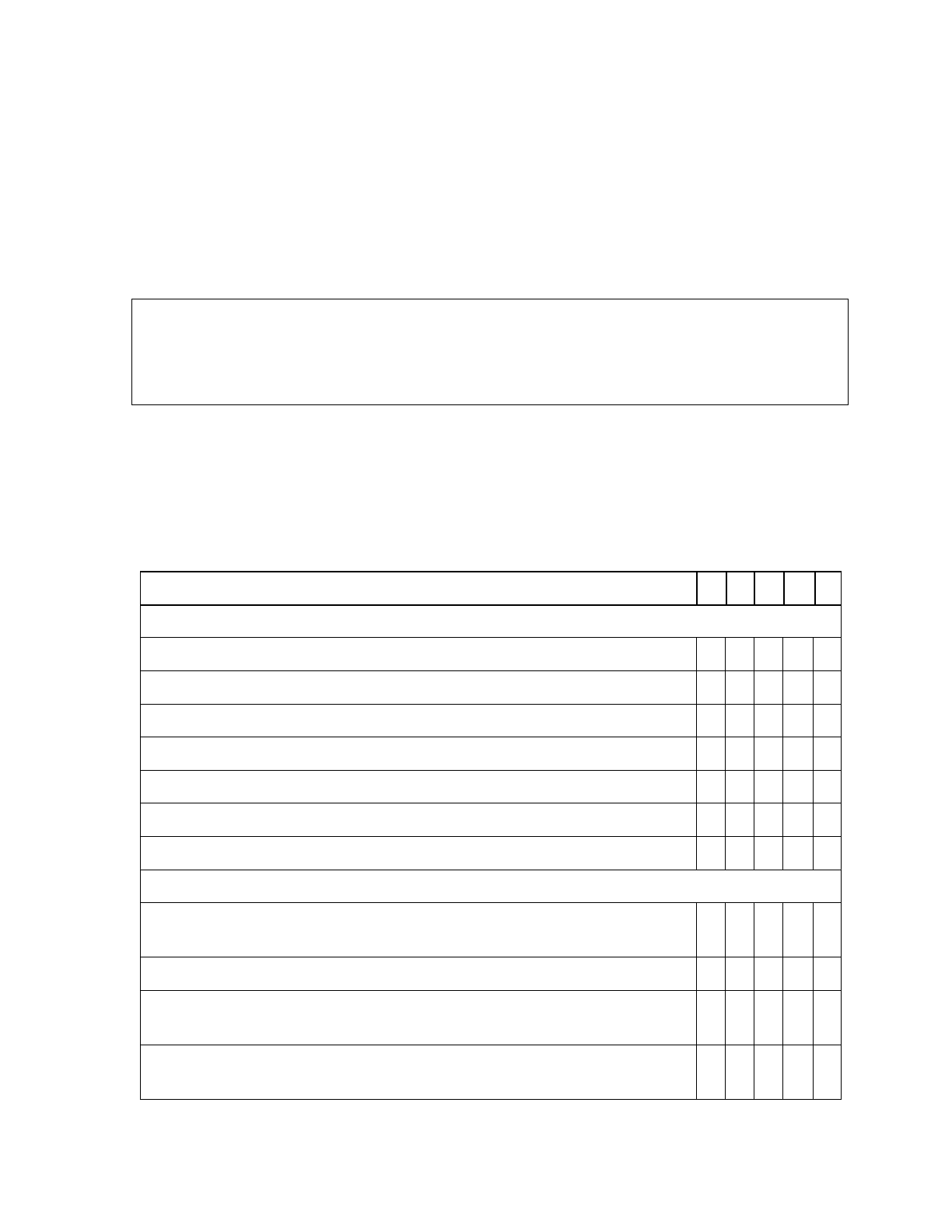
Institutional Quality Assurance Cell Operations Manual
IQACOM Annex 10.7
Institutional Self Assessment
SURVEY QUESTIONNAIRE FOR ACADEMIC STAFF
(To be filed by the Faculty Members)
This form includes statements for self assessment at institution level. You are requested to
give your sincere comment against each of the statements by putting a tick (√) mark on
appropriate box. Your sincere evaluation will be helpful for perfect assessment of the
institution, which in effect, would help to improve the performance of the institution further.
Evaluate the following aspects of the university in terms capacity to provide quality
education by marking “√” in the box of corresponding column according to the scale
given.
5–Strongly agree
4–Agree
3–Neutral
2–Disagree 1–Strongly
disagree
A. Governance
Areas of Evaluation
5
4
3
2
1
A.1 Mission and Objectives
Mission and objectives of the university are clearly defined
Mission and objective of the university are well communicated
University acts according to the mission and objectives
A.2 Governance Structure
Statutory bodies under the act/ordinance are functioning properly
University website is well designed with easy access to information
Students union/association is active to protect rights of the students
A.3 Policy and Management
Decision making procedure in the university is
democratic/participatory
Documentations are maintained properly
University provide handbook with details of academic programs and
rules regulations
Fairness and transparency of academic decisions at all levels are
maintained (such as admission, publication of results etc.)
99
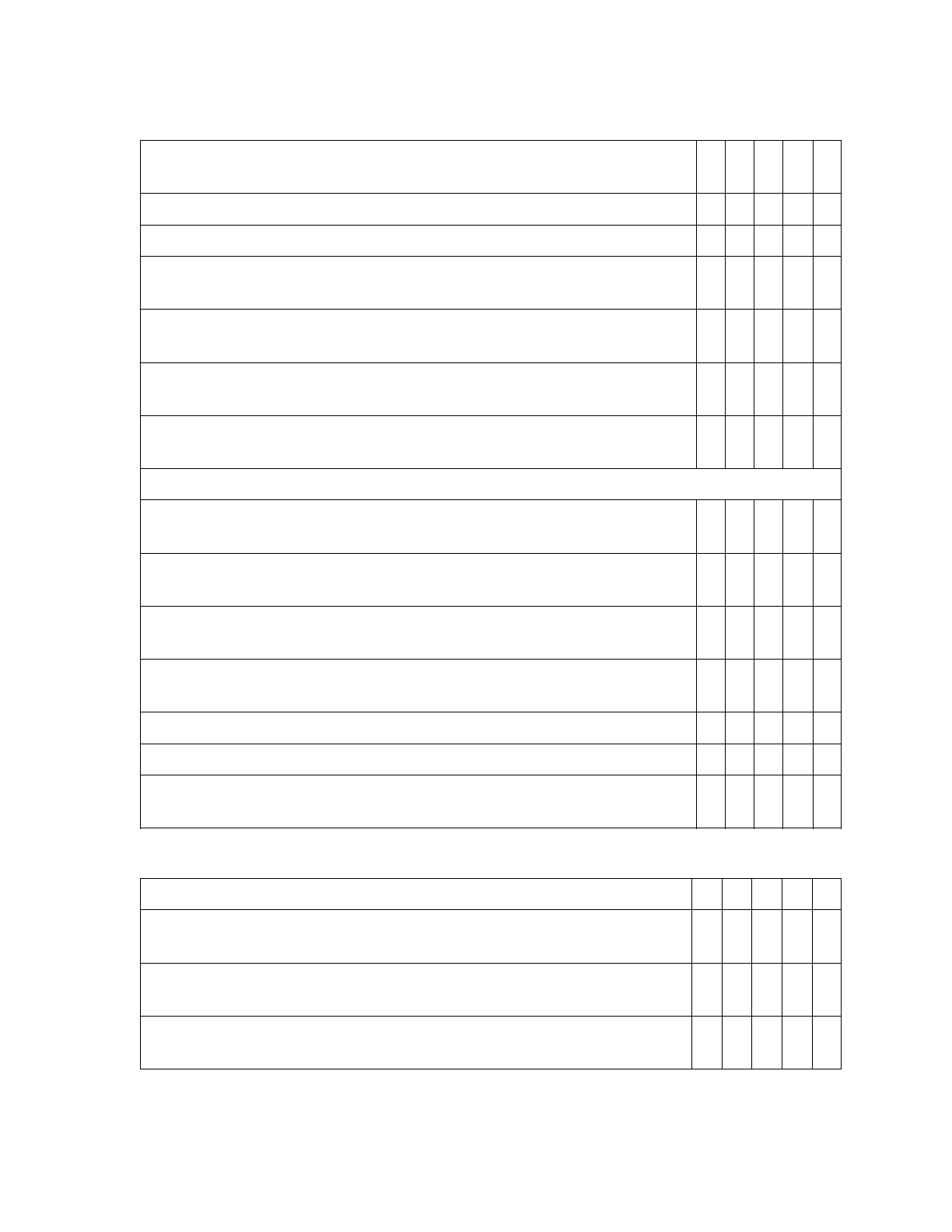
Institutional Quality Assurance Cell Operations Manual
University authority is sincere enough to maintain sound
environment to teaching learning.
Academic calendar is maintained properly
Results at all levels are published in compliance with the ordinance
University has policy and mechanism to entertain the disabled
students for higher education
University has very attractive service rules and career development
opportunities to retain the competent and qualified staff members
University has set policy to resolve students grievance in case of
assessment
Students’ opinion regarding academic and extra-academic matters
are treated properly
A.4 Accountability & Transparency
Definition of accountability lines for academic staff and non-
academic staff is clear enough and well communicated
Recruitment process is good to select the best candidates with
fairness and transparency
Key performance indictors (KPIs) are well defined for both academic
and non-academic staff members
Staff performance appraisal process is executed with fairness and
transparency
A.5 Autonomy
Internal QA system is functioning with enough autonomy
Teachers are performing in accordance of university rules with out
interference
Curriculum Design and Review
Areas of Evaluation
5 4 3 2 1
Inputs from the relevant stakeholders are taken into consideration in
designing curriculum
Curriculum consists aims, objectives, learning outcomes, content,
teaching strategy and assessment strategy
Curriculum review is done regularly following appropriate
procedures and documentation.
100

Institutional Quality Assurance Cell Operations Manual
C. Physical Facilities
Areas of Evaluation
5
4
3
2
1
1.
Classrooms are good in number, well spaced, well equipped and
well maintained to ensure effective delivery
2.
Laboratories are good in number, well spaced with relevant well off
equipments and properly maintained for conducive teaching and
learning
3.
The library has adequate and up-to-date reference materials that
meet the academic research needs
4.
The library provides appropriate ICT-mediated reference materials
5.
Internet facilities with sufficient bandwidth capacity are available
6.
Adequate office room facilities along with relevant equipments and
competent manpower are available
7.
Enough facilities of Sports and culture
8.
Enough medical facilities for the university community
D. Research & Extension Services
Areas of Evaluation
5 4 3 2 1
1.
The university has
policy and
program on research
and
development
University has institutional set up to coordinate advanced research
Adequate funds and facilities are provided to innovative research and
development
Capacity to hunt research fund for smooth running of the research.
University encourages students for engagement in research,
scholarship and development.
Research outputs are regularly published in reputed impact factor
journal
Research findings in the form of theses, monographs and publications
are properly preserved used in current teaching-learning.
Research findings are patented and used for commercial purposes.
The university is involved in community services with the output of
research and development activities
101
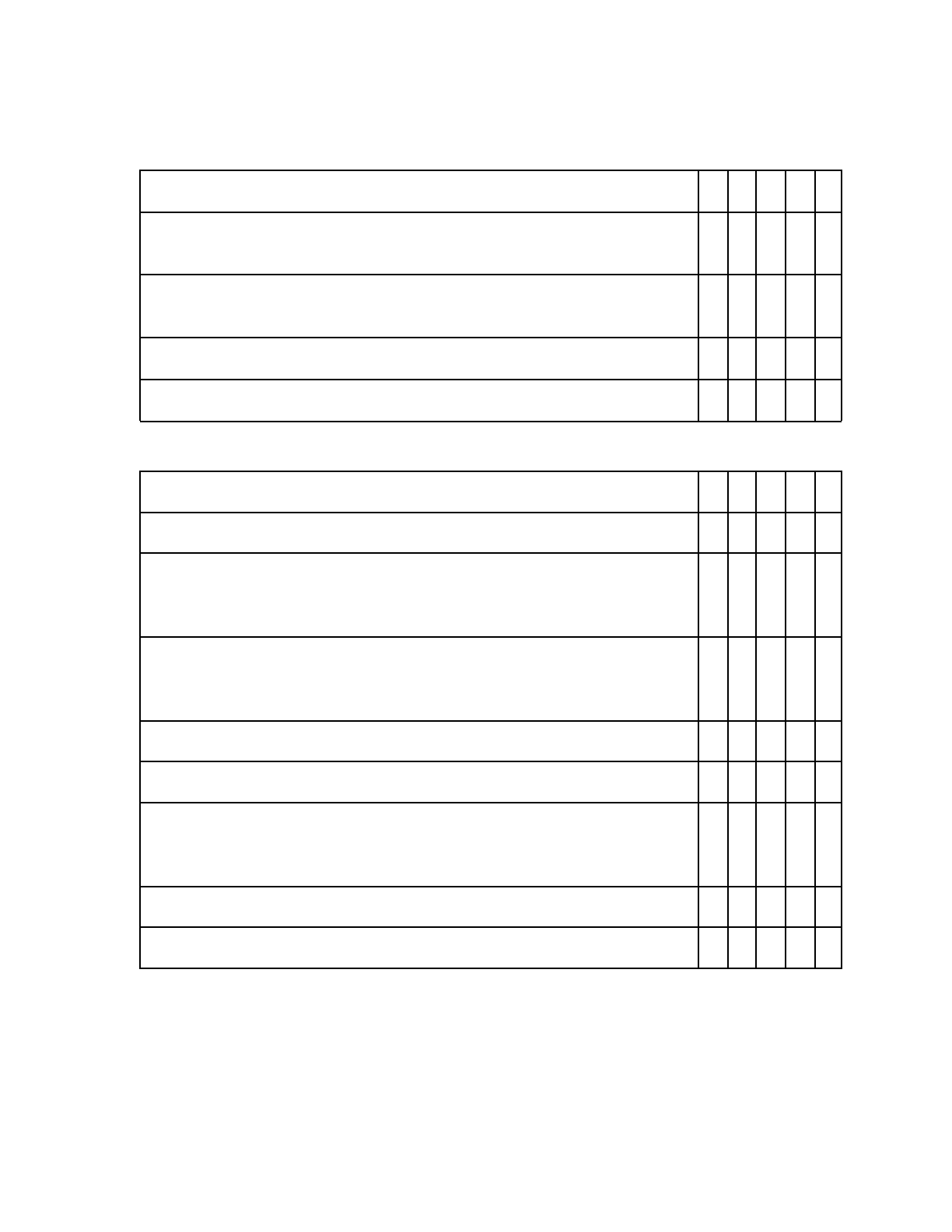
Institutional Quality Assurance Cell Operations Manual
E. External Relations
Areas of Evaluation
5
4
3
2
1
1.
The university maintains active institutional linkages with research
and academic institutions at national and international levels.
2.
University has set policy and mechanism for university industry
collaboration
3.
The university has institutional set up for community services
4.
University encourages to involve in consultancy services
F. Staff
Areas of Evaluation
5
4
3
2
1
1.
Teachers work load in teaching and research is justified
2.
Academics have enough opportunity including financial assistance
to take part in different training program, workshop, conferences
etc. for professional skill development
3.
University has provision to arrange experience sharing sessions to
transfer the knowledge and experience from attending training,
workshop and conferences.
4.
Staffs are competent and responsive
5.
Teacher student ratio is justified
6.
The university provides necessary training, tools and technology for
self-learning, access to information and for communication to the
academic staffs
7.
University has resourceful and effective staff development center
8.
Peer observation, mentoring and feedback are in practice
102

Institutional Quality Assurance Cell Operations Manual
G. Process Control (Internal Quality Assurance and Continuous quality Improvement)
Areas of Evaluation
5
4
3
2
1
1.
University has effective quality assurance system in action.
2.
University authority is committed to ensure good practices in levels
of administration
3.
University encourages innovative thinking and participation in QA
activities
4.
The university nurtures the spirit of continual quality improvement
taking past experiences, present conditions, and future possibilities
into consideration.
5.
University has a quality culture with commitment to continuous
improvement
6.
University rewards the staff members who are maintaining quality
assurance and evidences of good practices.
7.
The university evaluates performance to check whether the
achievements are in line with the expected outcomes and mission
Major weaknesses of your institution that you have observed:
______________________________________________________________________
______________________________________________________________________
______________________________________________________________________
______________________________________________________________________
______________________________________________________________________
Your suggestion to improve the quality of graduates:
______________________________________________________________________
______________________________________________________________________
______________________________________________________________________
______________________________________________________________________
______________________________________________________________________
______________________________________________________________________
______________________________________________________________________
103

Institutional Quality Assurance Cell Operations Manual
IQACOM Annex 10.8
Institutional Self Assessment
SURVEY QUESTIONNAIRE FOR EXTERNAL
STAKEHOLDERS
(To be filled by the employers and community people)
This form includes statements for self assessment at institution level. You are requested to
give your sincere comment against each of the statements by putting a tick (√) mark on
appropriate box. Your sincere evaluation will be helpful for perfect assessment of the
institution, which in effect, would help to improve the performance of the institution further.
Evaluate the following aspects of the university in terms capacity to provide quality
education by marking “√” in the box of corresponding column according to the scale
given.
5–Strongly agree
4–Agree
3–Neutral
2–Disagree
1–Strongly
disagree
Areas of Evaluation
5
4
3
2
1
1.
The mission statement is of the university is defined in accordance
with social and national context
2.
University website is well designed with easy access to information
3.
The university is responsive to the needs of the community.
4.
The university is responsive to the needs of the job market
5.
The university has a clear idea about the relevant
6.
demands and needs of the students/parents
7.
The university has a clear idea about the relevant
8.
demands and needs of the emerging global settings
9.
The university has clear guidelines on consultancy and
10. community outreach
11.
The university has a structured method for obtaining
12. feedback from external stakeholders
13.
University has set policy and mechanism for university industry
collaboration
104

Institutional Quality Assurance Cell Operations Manual
The university maintains active institutional linkages with research
and academic institutions at national and international levels.
University has set policy and mechanism for university industry
collaboration
The university has institutional set up for community services
University encourages to involve in consultancy services
Major weaknesses of the university ….. that you have observed
________________________________________________________________________
________________________________________________________________________
________________________________________________________________________
________________________________________________________________________
________________________________________________________________________
Your suggestion to improve the capacity of the university:
______________________________________________________________________________
_____________________________________________________________________
________________________________________________________________________
________________________________________________________________________
________________________________________________________________________
________________________________________________________________________
________________________________________________________________________
________________________________________________________________________
105
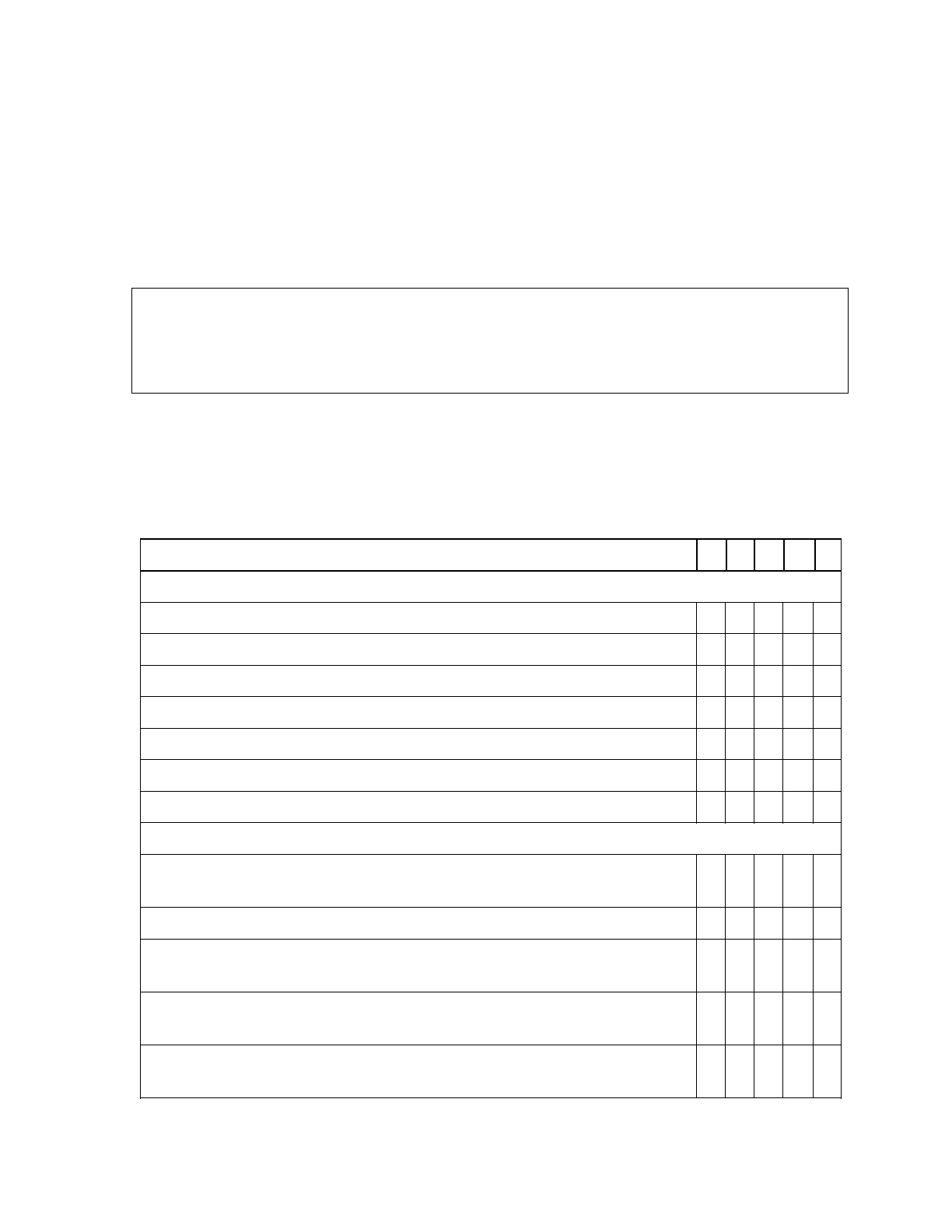
Institutional Quality Assurance Cell Operations Manual
IQACOM Annex 10.9
Institutional Self Assessment
SURVEY QUESTIONNAIRE FOR THE
NON-ACADEMIC STAFF
This form includes statements for self assessment at institution level. You are requested to
give your sincere comment against each of the statements by putting a tick (√) mark on
appropriate box. Your sincere evaluation will be helpful for perfect assessment of the
institution, which in effect, would help to improve the performance of the institution further.
Evaluate the following aspects of the university in terms capacity to provide quality
education by marking “√” in the box of corresponding column according to the scale
given.
5–Strongly agree
4–Agree
3–Neutral
2–Disagree 1–Strongly disagree
A. Governance
Areas of Evaluation
5
4
3
2
1
A.1 Mission and Objectives
Mission and objectives of the university are clearly defined
Mission and objectives of the university are well communicated
University acts to achieve the mission and objectives
A.2 Governance Structure
Statutory bodies under the act/ordinance are functioning properly
University website is well designed with easy access to information
Students union/association is active to protect rights of the students
A.3 Policy and Management
Decision making procedure in the university is
democratic/participatory
Documentations are maintained properly
Fairness and transparency of academic decisions at all levels are
maintained (such as admission, publication of results etc.)
University authority is sincere enough to maintain sound
environment to teaching learning.
University has very attractive service rules and career development
opportunities to retain the competent and qualified staff members
106
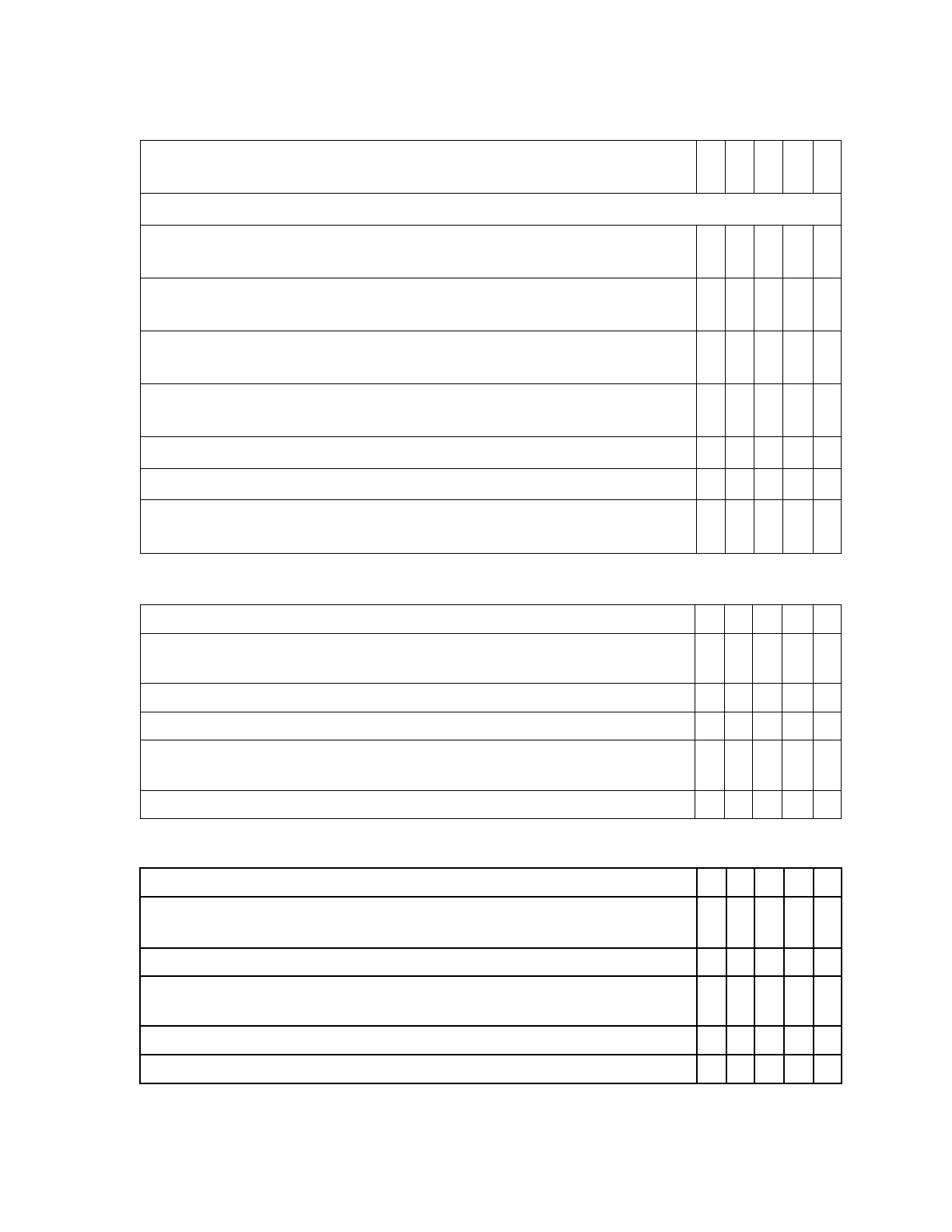
Institutional Quality Assurance Cell Operations Manual
University has set policy to resolve students grievance in case of
assessment
A.4 Accountability & Transparency
Definition of accountability lines for academic staff and non-
academic staff is clear enough and well communicated
Recruitment process is good to select the best candidates with
fairness and transparency
Key performance indictors (KPIs) are well defined for both academic
and non-academic staff members
Staff performance appraisal process is executed with fairness and
transparency
A.5 Autonomy
Internal QA system is functioning with enough autonomy
Staffs are performing in accordance of university rules with out
interference
Physical Facilities
Areas of Evaluation
5 4 3 2 1
The library has adequate and up-to-date reference materials that
meet the academic research needs
The library provides appropriate ICT-mediated reference materials
Internet facilities with sufficient bandwidth capacity are available
Adequate office room facilities along with relevant equipments and
competent manpower are available
Enough medical facilities for the university community
C. Staff
Areas of Evaluation
5
4
3
2
1
1.
Have enough opportunity to take part in staff training program for
professional skill development
2.
Staffs are competent and responsive
3.
The university provides necessary tools and technology for effective
performance
4.
University has resourceful and effective staff development center
5.
Peer observation, mentoring and feedback are in practice
107

Institutional Quality Assurance Cell Operations Manual
D. Process Control (Internal Quality Assurance and Continuous quality Improvement)
Areas of Evaluation
5
4
3
2
1
1.
University has effective quality assurance system in action.
2.
University authority is committed to ensure good practices in levels
of administration
3.
University encourages innovative thinking and participation in QA
activities
4.
University has a quality culture with commitment to continuous
improvement
5.
University rewards the staff members who are maintaining quality
assurance and evidences of good practices.
What are the major weaknesses you have observed in the quality of your graduates
______________________________________________________________________
______________________________________________________________________
______________________________________________________________________
______________________________________________________________________
______________________________________________________________________
Your suggestion to improve the quality of graduates:
______________________________________________________________________
______________________________________________________________________
______________________________________________________________________
______________________________________________________________________
______________________________________________________________________
______________________________________________________________________
108
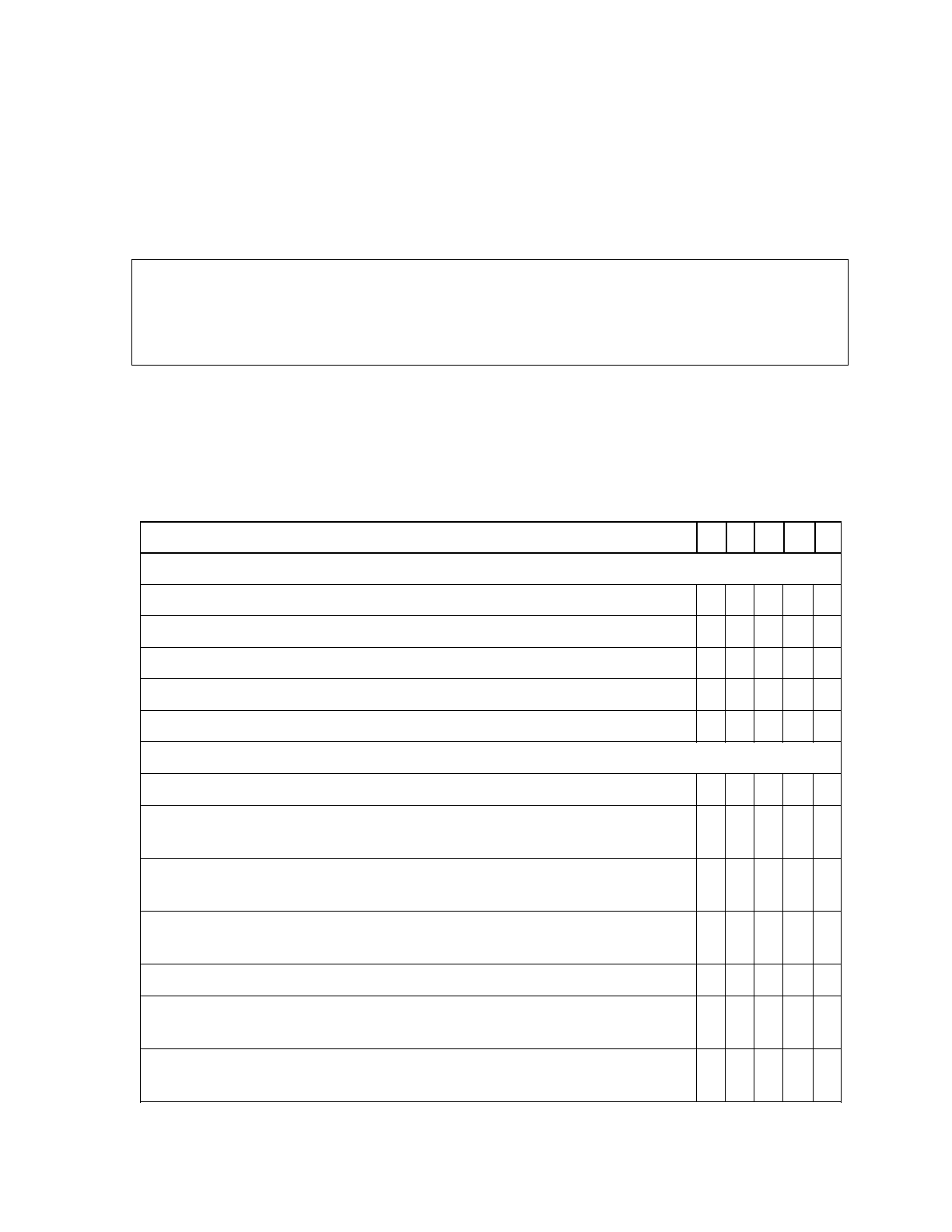
Institutional Quality Assurance Cell Operations Manual
IQACOM Annex 10.10
Institutional Assessment
(SURVEY QUESTIONNAIRE FOR THE STUDENTS
This form includes statements for self assessment at institution level. You are requested to
give your sincere comment against each of the statements by putting a tick (√) mark on
appropriate box. Your sincere evaluation will be helpful for perfect assessment of the
institution, which in effect, would help to improve the performance of the institution further.
Evaluate the following aspects of the university in terms capacity to provide quality
education by marking “√” in the box of corresponding column according to the scale
given.
5–Strongly agree
4–Agree
3–Neutral
2–Disagree 1–Strongly disagree
A. Governance
Areas of Evaluation
5
4
3
2
1
A.1 Mission and Objectives
Mission and objectives of the university are clearly defined
Mission and objective of the university are well communicated
A.2 Governance Structure
University website is well designed with easy access to information
Students union/association is active to protect rights of the students
A.3 Policy and Management
Documentations are maintained properly
University provide handbook with details of academic programs
and rules regulations
Fairness and transparency of academic decisions at all levels are
maintained (such as admission, publication of results etc.)
University authority is sincere enough to maintain sound
environment to teaching learning.
Academic calendar is maintained properly
University has set policy to resolve students grievance in case of
assessment
Students’ opinion regarding academic and extra-academic matters
are treated properly
109

Institutional Quality Assurance Cell Operations Manual
B. Physical Facilities
Areas of Evaluation
5
4
3
2
1
1.
Classrooms are good in number, well spaced, well equipped and
well maintained to ensure effective delivery
2.
Laboratories are good in number, well spaced with relevant well off
equipments and properly maintained for conducive teaching and
learning
3.
The library has adequate and up-to-date reference materials that
meet the academic research needs
4.
The library provides appropriate ICT-mediated reference materials
5.
Internet facilities with sufficient bandwidth capacity are available
6.
Enough facilities of Sports and culture
7.
Enough medical facilities for the university community
A. Research & Extension Services
Areas of Evaluation
5 4 3 2 1
1.
The university has
policy and
program on research
and
development
University has institutional set up to coordinate advanced research
Adequate funds and facilities are provided to innovative research and
development
Capacity to hunt research fund for smooth running of the research.
University encourages students for engagement in research,
scholarship and development.
Research findings in the form of theses, monographs and publications
are properly preserved used in current teaching-learning.
The university is involved in community services with the output of
research and development activities
110

Institutional Quality Assurance Cell Operations Manual
B. Students Supports
Areas of Evaluation
5
4
3
2
1
1.
The university maintains active institutional linkages with its alumni
and employers.
2.
University has set policy and mechanism for academic guidance and
counseling
3.
The university has institutional set up for placement and career
counseling to the students.
4.
University provides financial assistance to the meritorious and
distressed students
5.
Concerned offices of the university are sincere and cooperative in
handling the students affairs
C. Process Control (Internal Quality Assurance and Continuous quality Improvement)
Areas of Evaluation
5
4
3
2
1
1.
University has effective quality assurance system in action.
2.
University authority is committed to ensure good practices in levels
of administration
3.
The university nurtures the spirit of continual quality improvement
taking past experiences, present conditions, and future possibilities
into consideration.
4.
University has a quality culture with commitment to continuous
improvement
5.
University rewards students for extraordinary performances in
academic and non academic affairs
111

Institutional Quality Assurance Cell Operations Manual
What are the major weaknesses you have observed in the quality of your graduates
______________________________________________________________________
______________________________________________________________________
______________________________________________________________________
______________________________________________________________________
______________________________________________________________________
Your suggestion to improve the quality of graduates:
______________________________________________________________________
______________________________________________________________________
______________________________________________________________________
______________________________________________________________________
______________________________________________________________________
______________________________________________________________________
112

Institutional Quality Assurance Cell Operations Manual
IQACOM Annex 10.11
Institutional Assessment
SURVEY QUESTIONNAIRE FOR THE GRADUATES
This form includes statements for self assessment at institution level. You are requested to
give your sincere comment against each of the statements by putting a tick (√) mark on
appropriate box. Your sincere evaluation will be helpful for perfect assessment of the
institution, which in effect, would help to improve the performance of the institution further.
Evaluate the following aspects of the university in terms capacity to provide quality
education by marking “√” in the box of corresponding column according to the scale
given.
5–Strongly agree
4–Agree
3–Neutral
2–Disagree
1–Strongly disagree
A. Governance
Areas of Evaluation
5
4
3
2
1
A.1 Mission and Objectives
Mission and objectives of the university were clearly defined
Mission and objective of the university were well communicated
A.2 Governance Structure
University website was well designed with easy access to information
Students union/association was active to protect rights of the students
A.3 Policy and Management
Documentations were maintained properly
University provided handbook with details of academic programs and rules
regulations
Fairness and transparency of academic decisions at all levels were
maintained (such as admission, publication of results etc.)
University authority was sincere enough to maintain sound environment to
teaching learning.
Academic calendar was maintained properly
University had set policy to resolve students grievance in case of
assessment
Students’ opinion regarding academic and extra-academic matters were
treated properly
113

Institutional Quality Assurance Cell Operations Manual
B. Physical Facilities
Areas of Evaluation
5
4
3
2
1
1.
Classrooms were good in number, well spaced, well equipped and
well maintained to ensure effective delivery
2.
Laboratories were good in number, well spaced with relevant well
off equipments and properly maintained for conducive teaching and
learning
3.
The library had adequate and up-to-date reference materials that
meet the academic research needs
4.
The library provided appropriate ICT-mediated reference materials
5.
Internet facilities with sufficient bandwidth capacity were available
6.
Enough facilities of Sports and culture
7.
Enough medical facilities for the university community
C. Research & Extension Services
Areas of Evaluation
5 4 3 2 1
1.
The university had policy and
program on research
and
development
University had institutional set up to coordinate advanced research
Adequate funds and facilities were provided to innovative research
and development
Capacity to hunt research fund for smooth running of the research.
University encouraged students for engagement in research,
scholarship and development.
Research findings in the form of theses, monographs and publications
were properly preserved used in current teaching-learning.
114
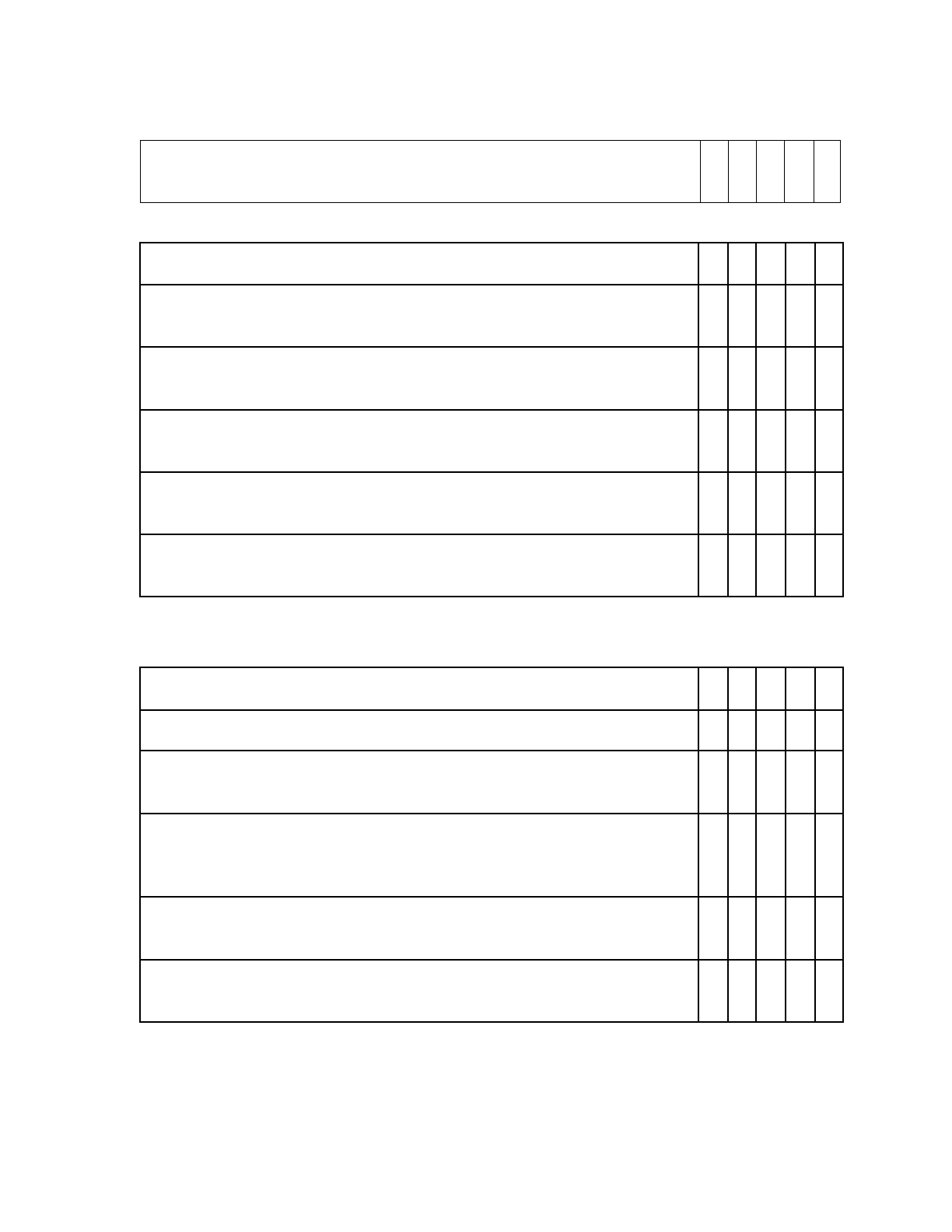
Institutional Quality Assurance Cell Operations Manual
The university was involved in community services with the output
of research and development activities
Students Supports
Areas of Evaluation
5
4
3
2
1
1.
The university maintained active institutional linkages with its
alumni and employers.
2.
University had set policy and mechanism for academic guidance
and counseling
3.
The university had institutional set up for placement and career
counseling to the students.
4.
University provided financial assistance to the meritorious and
distressed students
5.
Concerned offices of the university were sincere and cooperative in
handling the students affairs
E. Process Control (Internal Quality Assurance and Continuous quality Improvement)
Areas of Evaluation
5
4
3
2
1
1.
University had effective quality assurance system in action.
2.
University authority was committed to ensure good practices in
levels of administration
3.
The university nurtured the spirit of continual quality improvement
taking past experiences, present conditions, and future possibilities
into consideration.
4.
University had a quality culture with commitment to continuous
improvement
5.
University rewarded the students for extraordinary performances in
academic and non-academic affairs
115

Institutional Quality Assurance Cell Operations Manual
What are the major weaknesses you have observed in the quality of your graduates
______________________________________________________________________
______________________________________________________________________
______________________________________________________________________
______________________________________________________________________
______________________________________________________________________
Your suggestion to improve the quality of graduates:
______________________________________________________________________
______________________________________________________________________
______________________________________________________________________
______________________________________________________________________
______________________________________________________________________
______________________________________________________________________
116

Institutional Quality Assurance Cell Operations Manual
IQACOM Annex 10.12
INSTITUTIONAL SELF ASSESSMENT REPORT FORMAT
Chapter 1: Introduction
Significance of Institutional Self Assessment
Process of Assessment
Overview of the university
Mission and objectives of the university
Chapter 2: The core activities
Education
Research
Outreach Activities
Chapter 3: Quality assurance
Internal Quality Assurance system
Benchmarking
Chapter 4: Achievements
4.1 Achieved outcomes (graduates)/graduate profile
Research out put
Community outreach
Chapter 5: Stakeholder Opinion
Students
Alumni (graduates)
Employers & Community
5..4 Academic and non-academic staffs
Chapter 6 SWOT analysis
Strengths
Weaknesses
Opportunities
Threats
Chapter 7: Conclusion and Strategic Plan
Strategic plan for further improvement of the institution
Conclusion
Appendix
117

Institutional Quality Assurance Cell Operations Manual
IQACOM Annex 10.13
GUIDELINES FOR PEER-REVIEWERS
Introduction
The UGC through its QA Unit wishes to ensure that the peer-review process makes a full
contribution to its quality assurance and accreditation process. In this context the role of
the peer-reviewers is multifaceted and demanding. The reviewers can assist the
universities to develop their quality assurance systems and for continual improvement
of their standards.
This note offers guidance to the reviewers and other participants in the peer-review
process on the standards of conduct expected.
The QA Unit will monitor and evaluate the effectiveness of the review process.
Code of Conduct
The reviewer is expected to:
Take all reasonable steps to know and understand the published quality assurance
and accreditation process and in particular the methods of developmental
engagements and accreditation.
Ensure that they remain up to date with any developments in the published method,
including attending conferences and workshops arranged for peer-reviewers by the
Unit.
Conduct their roles and activities in reviews in a way that fully respects the
published method and protocols, including reaching justifiable evidence- based
judgments.
Undertake their part in review in a way that respects the mission of the entity they
are visiting and avoids bringing to the process any prejudices.
Show courtesy to all colleagues with whom they work in the review team and in the
institution, including respect for their views and opinion.
Complete the assignment on time and to a high professional standard, drawing upon
the hand book and the guidance provided in the review.
Respect the confidences shared in the course of the review, so that they do not
divulge any information on the self-evaluation, the findings of the review team or
the conduct of the review to any other university, any member of the public or the
media.
Contribute a requested by the QA Unit, to the evaluation of the process by offering
constructive comment of their experiences as a reviewer.
It is expected that peer reviewers will provide the entity with judgments basing on
the review observations for all the QA areas and overall.
118

Institutional Quality Assurance Cell Operations Manual
IQACOM Annex 11
Internal Audit Scale
Internal Academic Audit
Rating Scale
Rating
Description
5
(Excellent)
There are clear and documented policies, procedures and strategies,
which are consistently followed across the school. Conformance to
these policies, procedures or strategies is being monitored and action
taken for improvement.
4
(Very Good)
There are clear and documented policies, procedures and strategies,
which are mostly followed. Conformance to these policies,
procedures or strategies is being monitored and action taken for
improvement.
3
(Good)
Some form of process takes place, but policies/procedures/strategies
are not clearly stated or documented. Adherence and monitoring
takes place but are not consistent.
2
(Poor)
Process takes place in isolation. There are no clear policies/
procedures/strategies guiding the implementation of the process.
Monitoring is not consistent.
1
(Unsatisfactory)
No evidence of any policy/procedure/strategies. Process or action
takes place on ad-hoc basis when necessary.
119

Institutional Quality Assurance Cell Operations Manual
IQACOM Annex 12
TEMPLATE OF FACULTY/DEPARTMENT QUALITY
ASSURANCE REPORT
(Will be prepared by the degree offering entity and forwarded to IQAC through Faculty
QA Cell)
QUALITY ASSURANCE REPORT (QAR)
(Name of the Entity with address and website)
Basic Information
Date of Establishment:
Total Number of Staffs:
Items
Male
Female
Total
Full
Part
Full
Part
time
time
time
time
Teachers
Teachers with PhD
Administrative staff
Support Staff
Total
1.3 Number of Faculty Positions:
Position
Total
Recruited During the
Position Remains
Faculty
Year
Vacant
Lecturer
Assistant Professor
Associate Professor
Professor
Total
120

Institutional Quality Assurance Cell Operations Manual
1.4 Faculty Members participation in conferences and symposia during the year:
International
Total
Status
No. of Faculty
National level
level
Attended
Seminars/
Workshops
Presented
papers
Resource
Persons
1.5 Total Number of Students
Items
Male
Female
Total
Students:
International students
Total
1.6 Academic Programs of the Entity:
Programs added during
Programs
Existing Programs
the year
Programs
PhD
M. Phil
Masters
Under Graduate
PG Diploma
Advanced Diploma
Diploma
Certificate
Others
Total
121

Institutional Quality Assurance Cell Operations Manual
1.7 Accreditation Details (if any)
Name of the Programs
Year of Accreditation
Validity Period
Pattern of Program Management : Trimester /Semester /Annual
Development in Infrastructure Facilities:
Facilities
Existing
Created during this
Total
year
Class rooms
Laboratories
Seminar Halls
No. of important equipments
purchased during the current year.
Others (If any)
1.10 Scholarships and Financial Support to the students:
Number of students
Amount
benefitted
Financial support from
institution
Financial support from
government
Financial support from other
sources
International/
National
scholarships
122

Institutional Quality Assurance Cell Operations Manual
Co-curricular and Extra-curricular Activities organized by the students during this year:
Community Welfare Activities organized during this year:
Activities organized under university industry collaboration:
Quality improvement strategies adopted for each of the QA areas:
Activities undertaken for staff development during this year:
Initiatives taken to make the campus eco-friendly:
1.17 Number of collaborations: International …. National … Any other
Number of linkages created during this year: International …. National
Research Budget of the university for the year:
Number of patents received this year
Number of research awards/ recognitions received by faculty and research fellows during
this year:
1.22 Research funds sanctioned and received from various sources:
Nature of the
Duration
Source/Funding
Total Fund
Project/Research
Year
Agency
received
1.23 Research publications during the year:
International
National
Others
Peer Review Journals
Non-Peer Review Journals
e-Journals
123

Institutional Quality Assurance Cell Operations Manual
Conference proceedings
Books
1.24 Number of organizations /Clubs active during the year:
Nature of Organizations
Total
Students Society
Cultural
Sports
Cadet/Scouts
Community club
Philanthropic Club
Others (Pls. Specify)
IQAC cooperation received during the year
Summary of program self assessment specifying SWOT and recommendations if
conducted during this year and not reported before:
Name of the Strengths Weaknesses Opportunities Threats Recommendations
programs
Summary of Teacher Evaluation Report by the Student
Summary of Annual Course Report
Describe the evidences of best practices during this year:
Achievements with reference to milestone and performance indicators
Benchmark for the coming year
Probable Constraints to achieve the benchmark(s)
Conclusion
Summary of Action plan for the next academic year
124

Institutional Quality Assurance Cell Operations Manual
Name & Signature of the Head/Chairman _______________________________
IQACOM Annex 13
ANNUALINSTITUTIONAL QUALITY ASSURNACE REPORT
Note:
Institutional Quality Assurance Report (IQAR) will be a summary of the AQAR reports
prepared by the degree offering entities of the university.
The IQAC shall be responsible for the preparation of Annual Institutional Quality
Assurance Report.
The IQAC shall submit the report to the Academic Council after presenting it to the
QAC. Thereafter one copy of the report is submitted to the Syndicate and another
copy to the QAU, UGC.
ANNUAL INSTUTIONAL QUALITY ASSURANCE REPORT
(AIQAR) (Name of the University with address and website)
Basic Information
Date of Establishment of IQAC:
IQAC Received Fund During the Year:
Sl.
Source
Amount
Total
1.3
Total Number of Departments:
Faculties:
Centers:
Institutes:
1.4
Addition during the Year: Departments:
Faculties:
Centers:
Institutes:
1.5
Total Number of Staffs:
Items
Male
Female
Total
Full
Part
Full
Part
time
time
time
time
Teachers
125

Institutional Quality Assurance Cell Operations Manual
Teachers with PhD
Administrative staff
Support Staff
Total
1.6 Number of Faculty Positions:
Position
Total
Recruited During the
Position Remains
Faculty
Year
Vacant
Lecturer
Assistant Professor
Associate Professor
Professor
Total
1.7 Faculty Members participation in conferences and symposia during the year:
Status
No. of
International
National level
Total
Faculty
level
Attended
Seminars/
Workshops
Presented
papers
Resource
Persons
1.8 Total Number of Students
Items
Male
Female
Total
Students:
International students
Total
126

Institutional Quality Assurance Cell Operations Manual
1.9 Number of Academic Programs
Programs added during
Programs
Existing Programs
the year
PhD
M. Phil
Masters
Under Graduate
PG Diploma
Advanced
Diploma
Diploma
Certificate
Others
Total
1.10 Accreditation Details (if any)
Name of the
Year of
Institution
Validity Period
Programs
Accreditation
1.11 Pattern of Program Management
Pattern
Number of Programs
127

Institutional Quality Assurance Cell Operations Manual
Trimester
Semester
Annual
1.12 Development in Infrastructure Facilities:
Facilities
Existing
Created during this
Total
year
Campus area
Class rooms
Laboratories
Seminar Halls
No. of important
equipments purchased
during the current year.
Others (If any)
1.13 Library services:
Existing
Added during
Total
this year
No.
Value
No.
Value
No.
Value
Text Books
Reference Books
e-Books
Journals
e-Journals
Digital Database
128
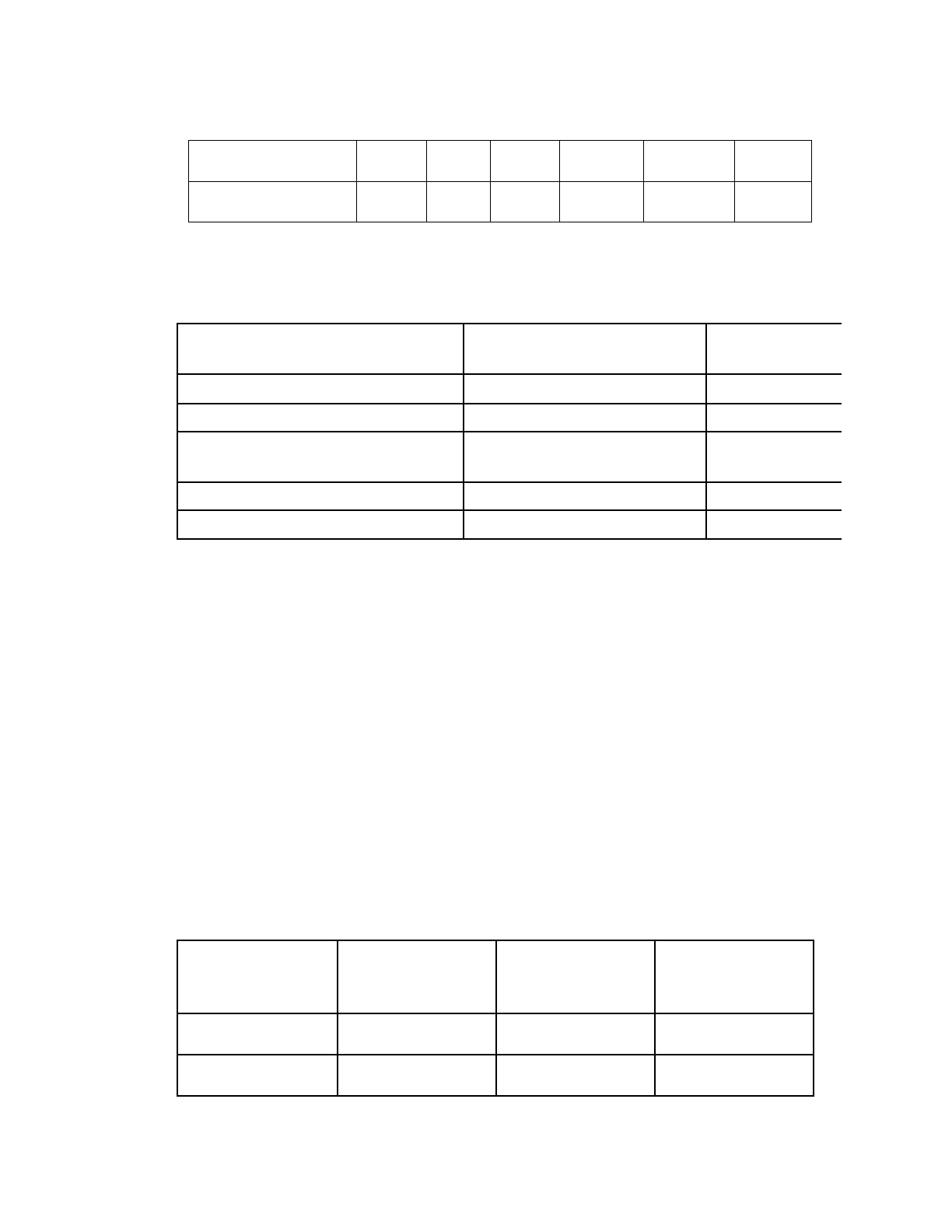
Institutional Quality Assurance Cell Operations Manual
CD & Video
Others (specify)
1.14 Scholarships and Financial Support to the students:
Number of students
Amount
benefitted
Financial support from institution
Financial support from government
Financial support from other
sources
International/ National scholarships
Co-curricular and Extra-curricular Activities organized by the students during this year:
Welfare activities for the university community during this year:
Activities organized under university industry collaboration:
Quality improvement strategies adopted by the institution for each of the QA areas:
Activities undertaken for staff development during this year:
Initiatives taken to make the campus eco-friendly:
1.21 Number of collaborations: International …. National … Any other
Number of linkages created during this year: International …. National
Research Budget of the university for the year:
Number of patents received this year
Number of research awards/ recognitions received by faculty and research fellows
during this year:
Research funds sanctioned and received from various sources:
Nature of the
Duration
Source/Funding
Total Fund
Project/Research
Year
Agency
received
129

Institutional Quality Assurance Cell Operations Manual
1.27 Research publications during the year:
International
National
Others
Peer Review Journals
Non-Peer Review Journals
e-Journals
Conference proceedings
Books
1.28 No. of organizations /Clubs:
Nature of Organizations
Total
Students Society
Cultural
Sports
Cadet/Scouts
Community club
Philanthropic Club
Others (Pls. Specify)
IQAC Activities during the year
Number of IQAC meetings held during the year:
Number of meetings held with stakeholders during the year:
Stakeholders
Total
Students
Teaching staffs
Non teaching staffs
130

Institutional Quality Assurance Cell Operations Manual
Parents
Employers
Community leaders
Alumni
Others (Pls. Specify)
2.3 No. of Seminars/Conferences/ Workshops/Symposia organized by the IQAC:
Items
National
International
Total
Seminar
Workshop
Conference
Study Tour
Training
Number of programs carried out Self Assessment (If it is done during the academic
year):
Number of program completed External Peer Review and validation(if any):
Summary of program self assessment specifying SWOT and recommendations:
Name of the Strengths Weaknesses Opportunities Threats Recommendations
programs
2.7 Summary of Institutional self assessment and external peer review:
Strengths
Weaknesses
Opportunities
Threats
Recommendations
2.8 Summary of Audit Reports during the academic year
131

Institutional Quality Assurance Cell Operations Manual
Issue consideration
Good practice highlighted in reports
Summary of Teacher Evaluation Report by the Student
Summary of Annual Course Report
Describe the evidences of best practices during this year:
Achievements with reference to milestone and performance indicators
Benchmark for the year
Probable Constraints to achieve the benchmark
Conclusion
Summary of Action plan for the next academic year
Name & Signature of the Director, IQAC _______________________________
Name & Signature of the Vice Chancellor _______________________________
132

Institutional Quality Assurance Cell Operations Manual
IQACOM Annex 14
DECLARATION OF IDEPENDANCE AND
CONFIDENTIALITY FORM
(This form is to be completed by officers involved in audit prior to an audit exercise.)
Name:
Title/Position within the University:
Faculty/Department:
Declaration of Independence and Disclosure of Conflict of Interest:
Declaration of Confidentiality
I, hereby, declare that I shall hold in confidence all information obtained during this
audit and shall deal with it in accordance to my terms of reference.
Declaration of Independence
“As the Chairperson/Member (delete as appropriate) of the audit team for (state the
name of the audit here), I declare that to the best of my knowledge and belief I am able
to carry out my responsibilities as required by my terms of reference without bias and
independently.
Disclosure of Conflict of Interest
I declare that in carrying out my responsibilities in this audit exercise, I:
(tick where appropriate)
am not at risk of any possible conflict of interest
declare a possible conflict of interest (please provide details below)
______________________________________________________
______________________________________________________
133

Institutional Quality Assurance Cell Operations Manual
I, (name of the audit team member), hereby affirm the truth of the statements made above
and I understand that I will be required to discontinue my current responsibilities if any of
the above is shown to be untrue.
______________________________________
(Signature of Person submitting the Statement)
____________
Date
*******************For Official Use ONLY*******************
Declaration accepted and verified by:
Comments/Observation if any:
__________________________________________________________________________
__________________________________________________________________________
Name of IQAC Officer: _________________________________
Signature: ____________________________________________
Date: ________________________________________________
134

Institutional Quality Assurance Cell Operations Manual
IQACOM Annex 15
TEACHER EVALUATION FORM
(To be filled by the student)
This checklist includes statements for evaluating ‘Teaching Performance’ of a teacher. You
as a student are requested to give your sincere comment against each of the statements. Your
sincere evaluation will be helpful for improving ‘teaching quality’ of your honorable teacher
community. Be honest!!
Course Title and Number:__________________________________________
Name of Instructor: ___________________Semester____________________
Department: ________________________Degree________________________
Evaluate the following aspects of the teaching performance in terms capacity to provide
quality education by marking “√” in the box of corresponding column according to the scale
given:
5–Strongly agree; 4–Agree; 3–Neutral; 2–Disagree; 1–Strongly disagree;
Scale
Aspects related to Teaching Performance
5 4 3 2 1
A: Subject Matter Knowledge
Have sound and updated knowledge on subject
Gives adequate information considering students level
Makes topics easily understandable
Gives appropriate and lively examples from real life situation to
motivate the students for learning
Provides additional material apart from the textbook
B: Presentation and Management
Has clear and audible voice
Keeps class lively using wit (humor) & body language
Encourages students’ participation (question-answer)
Controls and maintain conducive environment for learning
Provide and maintain lesson plan
135

Institutional Quality Assurance Cell Operations Manual
C: Assessment
Remains keen and use multiple techniques for continuous assessment
Sets easily understandable questions
Sets questions relevant to intended learning outcomes
Remains fair and unbiased in assessment
Provide prompt feedback after every assessment
D: Students’ Development
Always keen to explore potentials of the students
Provide guidance and counseling
Plays a role model for values and ethics
E: Professional Behavior
Remains honest, polite and gentle in any situation
Shows respect towards students and encourages class participation
Arrives and leaves the class on time
Always completes the whole course
Available during the specified office hours and for after-class
consultations
136
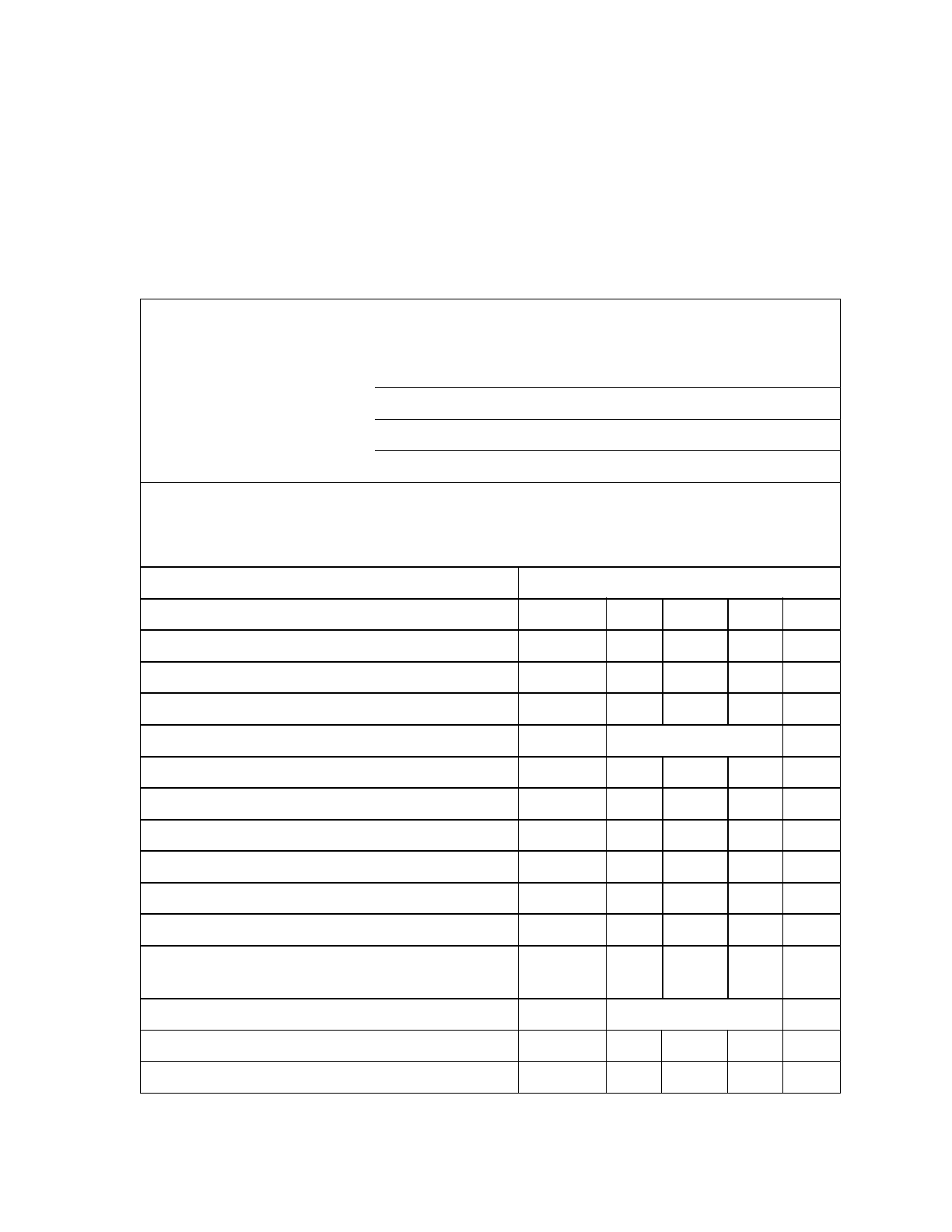
Institutional Quality Assurance Cell Operations Manual
IQACOM Annex 16
CLASS ROOM TEACHING OBSERVTION
REPORT FORMAT
(To be filled by the peer observer in class)
A. General Information
1. Name of the program:
2. Name of Teacher:
3. Name of Observer:
4. Title of Presentation:
5. Venue /Date/Time:
B. Aspects Evaluated and Scoring Scale
5-Excellent
4-Very good
3-Good
2-Fair
1-Poor
(Please circle the score for each aspect)
Description
Level of Evidence
1. Set Induction
a)
Clarity of objectives
b)
Relevance to topic
c)
Appropriateness of introduction
Subtotal for Section B1
2. Content
a)
Knowledge
b)
Extend of coverage
c)
Level of interest generated
d)
Logical flow of presentation
e)
Correctness of language used
f)
Clear
and
relevant
use
of
analogies/examples
Subtotal for Section B2
Presentation
Appropriate pacing
137

Institutional Quality Assurance Cell Operations Manual
Confidence
Enthusiasm
Provoking students to think
Clarity of presentation
Interaction with students
Effective use of teaching/learning aids
Effective class management
Subtotal for Section B3
Closure
Appropriateness of closure
Use of effective questions to gain
feedback
Appropriate links to the next lesson
Subtotal for Section
B4 Total Score
Score Interpretation
90 to 100 Excellent
80 to less than 90 Very Good
70 to less than 80 Good
60 to less than 70 Fair
50 to less than 60 Poor
40 to less than 50 Very poor
Observer’s Overall Comments and Suggestions for Improvement
Presenter’s Comment/Remarks
Signatures:
Observer/Date
Presenter/Date
138

Institutional Quality Assurance Cell Operations Manual
IQACOM Annex 17
SURVEY FORM FOR PhD PROGRAMSOFFERING ENTITY
The following information is required for Departments in which a PhD program is offered.
1.
General Information:
1.1
Name of the Department
1.2
Name of the Faculty
1.3
Date of initiation of PhD program
1.4
Total number of academic journals subscribed in area relevant to PhD
program.
1.5
Number of Computers available per PhD student
1.6
Total Internet Bandwidth available to all the students in the Department.
2.
Faculty Resources:
2.1
Number of faculty members holding PhD degree in the department.
2.2
Number of approved PhD Advisors in the department.
3.
Research Output:
3.1
Total number of articles published last year in International Academic
Journals that are authored by faculty members and students in the
department.
3.2
Total number of articles published last year in Asian Academic Journals
that are authored by faculty members and students in the department.
3.3
Total number of ongoing research projects in the department funded by
different organizations
3.4
Total Research Funds available to the Department from all sources.
3.5
Number of active international linkages involving exchange of
researchers/students/faculty etc. (Attach Details)
4.
Student Information:
4.1
Number of PhD degrees conferred to date to students from the
Department during the past three academic years.
4.2
Number of PhD students currently enrolled in the department.
4.3
Ratio of number of students accepted to total number of applicants for
PhD Program.
5.
Program Information
139

Institutional Quality Assurance Cell Operations Manual
5.1
Entrance requirements into PhD Program (M.Sc. / MPhil) Indicate
subjects or M.Sc. / MPhil
5.2
Is your PhD program based on research only? (Y/N)
5.3
Maximum number of years in which a PhD degree has to be completed
after initial date of enrollment in PhD program.
5.4
Total number of post M.Sc. (16 year equivalent) courses required for PhD
5.5
Total number of MPhil level courses taught on average in a Term /
Semester.
5.6
Total number of PhD level courses taught on average in a Term /
Semester.
5.7
Do your students have to take/write:
a.
PhD Qualifying examination (Y/N)
b.
Comprehensive examination (Y/N)
c. Research paper in UGC approved Journal
d. Any other examination (Y/N)
5.8
Total number of International examiners to which the PhD dissertation is
sent.
5.9
How is the selection of an examiner from technologically advanced
countries carried out?
5.10
Is there a minimum residency requirement (on campus) for award of PhD
degree?
6.
Additional Information
6.1
Any other information that you would like to provide.
140

Institutional Quality Assurance Cell Operations Manual
IQACOM Annex 18
Activity Chart of QAU
Preparing List of Peer
Reviewers
Program Self
Assessment
Guidelines
IQAC
Programs
Self Assessment
/External Peer
Review
Reporting by
Discipline Specific
Accreditation
Committee
Universities Judgment
standards and
Evaluation guidelines
IQAC
University
QAACB Self
Assessment
QAU
University Evaluation
by External Peers
(Council Members)
QAU Reports Published
Quality
Program
Management at
Accreditation
University Level
Quality Management in Higher Education
141
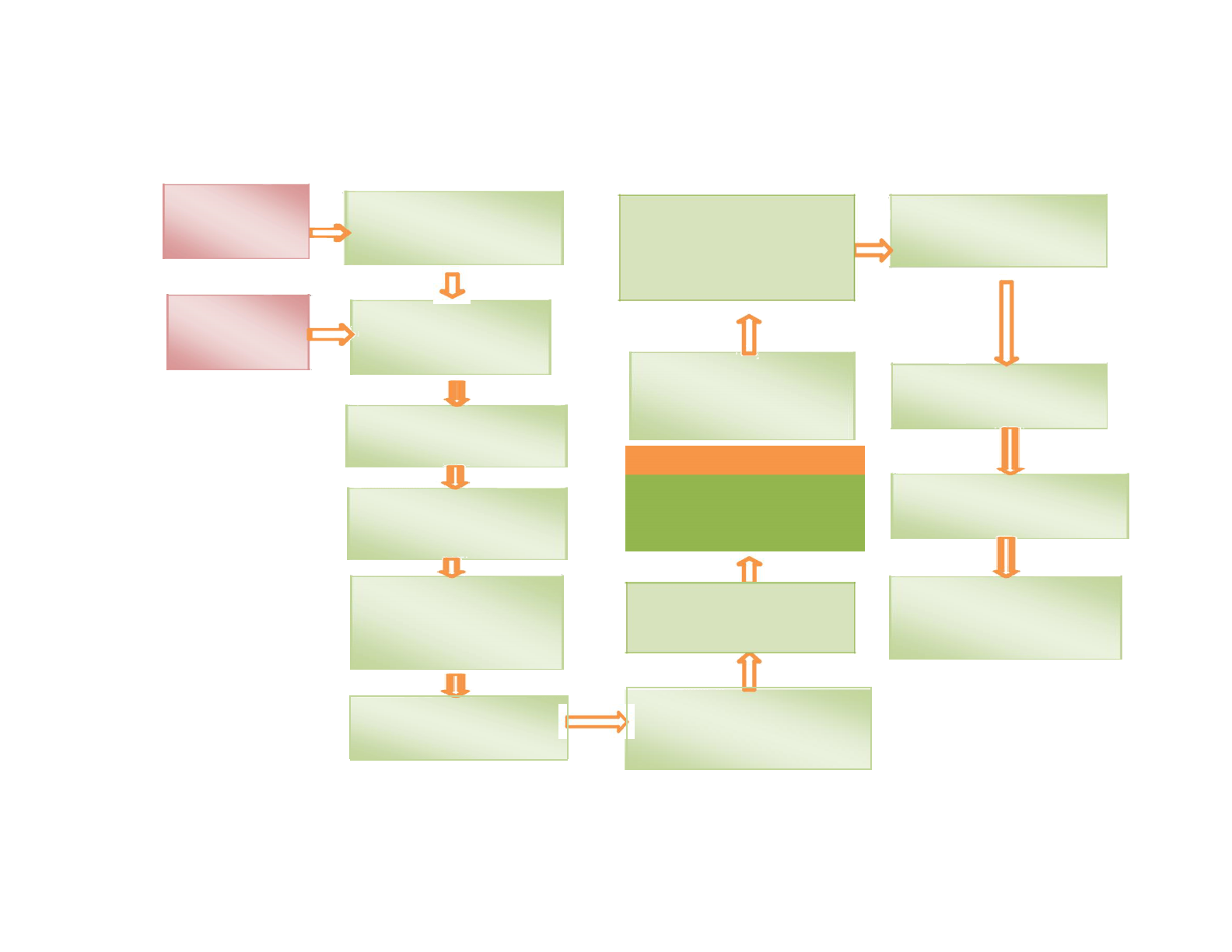
Institutional Quality Assurance Cell Operations Manual
Figure 1: Flow Chart on QAP Selection Process (09 weeks)
IQACOM Annex 19
QAU,
UGC
Universities
Call for Proposals by QAU
for 1
st
round of IQACF for
Group A Universities
Preparation of draft QAP
by universities in four
weeks
Review and approval of QAP by
QAC of each university
Submission of QAP by
universities to QAU on the
completion of four weeks
Checking of QAP by QAU
for its completeness in three
days
Rationalization of budget,
financing and procurement
plans of selected QAPs in
one week
Sharing of reviewers’
comments with IDA in
three days
Preparation of database on
reviewed QAPs by QAU in
two days
Review of QAPs by panel of
experts in two days
Final selection of QAPs by
QAU in two days
Publication of award in one
day
Processing of contract by
QAU in one week
Signing of contract with
the Universities in one day
Preparation of QAP database by
Resubmission of QAP if
QAU in two days
needed in three days
142